The future of Aussie weather –What’s on the horizon for farmers?

The goats of Dry Creek Farm –
How a family business began to thrive
Safeguarding our oysters –Creating a diseaseresistant spat
Agritourism is booming –Farming diversifying into tourism
Election yields new government
How NSW Farmers plans to secure strong outcomes for agriculture

MAY – JUNE 2023 / $ 9.95
THE MUSTER
Mental health support needed for more farmers; Filling Ukraine’s sunflower export gap; Kids to Farms is developing the next generation of young farmers; Mumma Be is helping new country mums to thrive; Veterans and farmers bond with horses for health, Special Report on the NBN
SPOTLIGHT ON A
BUSINESS
THE GOATS OF DRY CREEK FARM Utilising goats and permaculture for managing noxious weeds 46

DOMES OF HOPE AND HAPPINESS
A family turned to tourism following the 2018 drought to preserve their farm 50
ENVIRONMENT
THE BIG PICTURE
PREPARING FOR THE NEXT DROUGHT How can farmers be prepared for what weather patterns might unfold next? 56
SPECIAL
THE BIG
TRADE
NEWS AND VIEWS
6
INVERELL TICKS THE BOXES The community in Inverell fosters a forward-thinking, creative approach to living 20
TOWN
FUTURE OF PORT STEPHENS OYSTERS Will the historic Port Stephens oyster industry survive a mystery enemy and QX disease? 26
THE
from the major parties 34
ISSUE A VOTE FOR CHANGE AS NSW USHERS IN A NEW ERA The verdict is in – people are walking away
COMPETITION
GRAIN
competition and transparency in the supply chain for grain farmers 40
NOT GOING WITH THE
Improving
SPECIAL REPORT: CONNECTIVITY CONNECTIVITY DRIVING EFFICIENCY Remote farm monitoring systems like FarmBot are improving efficiency 54
TOURIST Forget Farmer Wants a Wife: farmers in NSW are courting tourists instead 60 INTERNATIONAL INFLUENCE CRYING FOR ARGENTINA Argentinian farmers are dealing with the driest period South America has recorded in 60 years 66 INNOVATION CO-INVESTING IN FARM INNOVATION The Farm Innovation Fund has the potential to build drought resilience and improve farm efficiency 70 COMMUNITY COMMUNITY: LOCAL FARMERS Cowra farmers have survived serious rainfall, Covid-19 and skyrocketing inflation� What are they doing to stay ahead of the next curve ball? 74 NEW GENERATION: THE HERRMANNS The Herrmann family from Murrami produce a mix of food and fibre that is feeding the future of its farming enterprise 78 FARM DOGS Meet Spags – a fun-loving retired farm dog now residing in Berry 84 SALEYARDS We’ve rounded up some great new Aussie-made products 85 MEET A MEMBER Always ahead of the game, Ranald and Jenny Mitchell have been members of NSW Farmers for 62 years 86 JOIN US – SUBSCRIBE Sign up and become a NSW Farmers’ member, and also receive The Farmer 88 THE TAIL END Bees could be the key to determining whether our avocado crops are pathogen-free 90 Contents
REPORT: AGRITOURISM FARMER WANTS A
THE FARMER MAY - JUNE 2023 2
The Munsie family used the drought to diversify into luxury on-farm tourism.

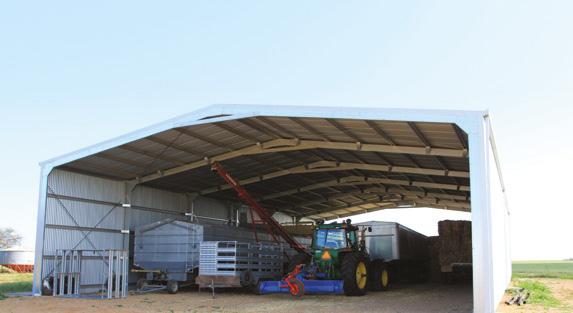





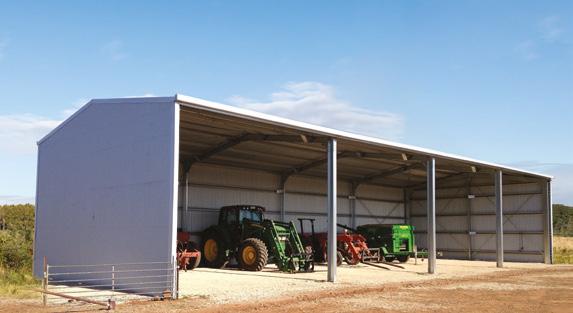





Images are from the Now Buildings range, for illustration purposes only. Imperial measurements are approximate. Shed price only. WA and NT slightly extra. Prices are based on collection, delivery extra. Extras pricing in bold is applicable at the shed purchase stage only. Extensions for existing sheds POA. Now Buildings will not be responsible to honour these prices once the total allocation has been sold. E&OE. Prices are Region A, Terrain cat. 2. Reg B slightly extra. *Now Buildings is not responsible for any changes made to tax legislation after the print deadline. You should consult your own taxation advisors before entering any transaction. 100% Australian steel, 100% Australian made, 100% Australian family owned High tensile bolts & class 4 fasteners, gutters & downpipes included Site specific engineering, heavy duty connection & footing design High grade industrial strength materials and design THE NOW BUILDINGS ADVANTAGE CALL US ON 02 5944 3404 WEB: shed.sale/TheFarmer JOHN 0437 699 111 TREVOR 0431 597 160 JAMES 0413 104 820 MANUFACTURING LOCATIONS: DUBBO, CARDIFF, TAMWORTH, COFFS HARBOUR, QUEANBEYAN & ALBURY PLUS, UPGRADE TO COLORBOND®️ FOR FREE! ABN HOLDERS ONLY SAVE $1000’S! STRICTLY LIMITED NUMBERS HURRY! THIS IS YOUR LAST CHANCE TO SAVE TAX!* The instant tax write off & 100% deduction for sheds ends soon. Don't miss out! *Check with your tax advisor for eligibility. 15M x 27M x 5.1M (50’ x 90’ x 17’) So popular and such great value. Add an extra bay for $6,320. 5.6M (18’3”) high version $44,670. GREAT OPENINGS $41,960 INC GST ONLY 15M x 40.5M x 5.1M (50’ x 135’ x 17’) With one large open ended shed, plus a 6M x 18M lean-to, this duo is great for all your farm needs. A BIT ON THE SIDE $76,800 INC GST ONLY 18M x 45M x 5.7M (60’ x 147’ x 19’) Five huge 9M bays with three-sided protection. MONSTER OPENINGS $96,950 INC GST ONLY 20M x 45M x 5.7M (66’ x 147’ x 19’) Huge openings with great clearance means this shed is perfect for all your needs. THE BIG ONE $105,800 INC GST ONLY 15M x 18M x 4.5M (50’ x 60’ x 15’) Two 9M open bays. Great space for storage, protection and access. Increase height to 5.1M (17’) for $1,410. TOUGH DOUBLE PLUS $36,250 INC GST ONLY 15M x 18M x 5.1M (50’ x 60’ x 17’) Strong, robust and extendable. Open both ends. Add an extra bay for $6,570. ULTIMATE VALUE $29,150 INC GST ONLY 9M x 24M x 5M (30’ x 80’ x 16’8”) Four large 6M bays to suit all storage needs. Extend to 13M (43’) wide for an extra $8,900. 5.7M (19’) high version $32,360. EASY ACCESS $30,070 INC GST ONLY 9M x 13.5M x 4.5M (30’ x 45’ x 15’) Heavy duty building with a large industrial roller door and PA door. Building in Colorbond. COMPACT BUSINESS $23,930 INC GST ONLY 9M x 13.5M x 4.5M (30’ x 45’ x 15’) Open front three bay shed in Zinc. Add an extra bay for $4,320. FARM SAVER $18,600 INC GST ONLY 13M x 22.5M x 5M (43’ x 75’ x 16’8”) Have the best of both worlds with an enclosed workshop featuring a large industrial roller door plus a PA door that leads out to the four 4.5M open front bays. FARMERS WORKSHOP $46,800 INC GST ONLY 13M x 13.5M x 5.1M (43’ x 45’ x 17’) Access from both 13.5M ends makes this shed perfect for drive-thru storage, and it’s easy to extend. CLASSIC SHELTER $21,150 INC GST ONLY 10M x 20M x 3.9M (33’ x 66’ x 12’7”) Three 3.3M high roller doors plus a PA door. Ideal shed for a secure workshop (or man cave). THE MAN CAVE $38,050 INC GST ONLY
PUBLISHER James Wells
EDITOR Michelle Hespe
ART DIRECTOR Ryan Vizcarra
EDITORIAL ENQUIRIES
Michelle Hespe
Email: mhespe@intermedia.com.au
ADVERTISING
SALES DIRECTOR

Ben Payne
Email: bpayne@intermedia.com.au
Phone : 0403 893 668

–CONTRIBUTORS
Anthony Ong
Danielle McIltrot
Emily Simpson
Ian Neubauer
Jessica Vant
Lucy Jones
Matilda Meikle
Michael Burt
Paul Henderson-Kelly

Rachael Lenehan
Sue Wallace
Susan Gough Henly
From the editor
It is with some sadness that I write this last letter as the editor of The Farmer magazine for the NSW Farmers Association
I am moving to a new venture, and a new editor will have joined the team by the time you are reading this I know that they will continue to produce the wonderful, informative magazine that I have grown to love over the past three years� I’ve not only loved working with the amazing team at NSW Farmers and Intermedia, but also with the many passionate journalists and photographers who ensure that the lives of farmers are quite literally bursting from these pages
NSW FARMERS


I started working on The Farmer in March 2020, just as Covid-19 brought the world to its knees, and from there I was taken on a wild ride through everything that farmers have been through in the past few years such as unprecedented fires and floods, mice plagues, transport, supplier and logistics issues, and we will never forget the great toilet paper shortage Wasn’t that a ridiculous debacle?
to everyone within their reach is both humbling, and heartening Ultimately, the resilience that comes from that support is part of what makes farming so incredible�
When I sit down to edit a feature article on something new that a person, company or family is working on, I admire the tenacity and the innovation that comes from working on and with the land That hard work and connection with the land produces the food and the fibre that we all need to live
CEO Pete Arkle
SOCIAL & CONTENT MANAGER Michael Burt
MAGAZINE CONTENT TEAM
Alicia Harrison – Membership Service Manager
Annabel Johnson – Head of Policy & Advocacy
CONTACT US
Level 4, 154 Pacific Highway, St Leonards, NSW 2065
PO Box 459, St Leonards, NSW 1590
Head Office: 02 9478 1000
MEMBER SERVICE CENTRE
For membership, magazine subscriptions and mailing list enquiries: 1300 794 000
@NSWFarmers
THE INTERMEDIA GROUP
MANAGING DIRECTOR Simon Grover
GM OF OPERATIONS Chris Baker
FINANCE MANAGER Mina Vranistas
PRODUCTION MANAGER Jacqui Cooper
HEAD OF DIGITAL Jordan Guiao
The Farmer magazine is published for the NSW Farmers Association (ABN: 31 000 004 651) by The Intermedia Group (ABN: 94 002 583 682) 41 Bridge Rd, Glebe NSW 2037. All rights reserved. Printed by IVE Group. Getty Images were used throughout the magazine.
Having grown up in Frogs Hollow on the Sapphire Coast, I thought I knew a thing or two about farming when I started editing this magazine, but I can now say that I really had no idea when it came to so many of the other issues, challenges and triumphs that are a day-to-day part of farming


It’s such an honour to learn from farmers themselves, and from journalists who have farming in their hearts� The support that the solid communities in farming give
So, thank you all for everything you do for the rest of the country, and I hope to see you around the traps�
MICHELLE HESPE Editor
The Intermedia Group takes its corporate and social responsibilities seriously and is committed to reducing its impact on the environment. We continuously strive to improve our environmental performance and to initiate additional CSR based projects and activities.
As part of our company policy we ensure that the products and services used in the manufacture of this magazine are sourced from environmentally responsible suppliers. This magazine has been printed on paper produced from sustainably sourced wood and pulp fibre and is accredited under PEFC chain of custody.
PEFC certified wood and paper products come from environmentally appropriate, socially beneficial and economically viable management of forests.
The wrapping used in the delivery process of this magazine is 100% recyclable.
DISCLAIMER: This publication is published by The Intermedia Group Pty Ltd (the “Publisher”). Materials in this publication have been created by a variety of different entities and, to the extent permitted by law, the Publisher accepts no liability for materials created by others. All materials should be considered protected by New Zealand and international intellectual property laws. Unless you are authorised by law or the copyright owner to do so, you may not copy any of the materials. The mention of a product or service, person or company in this publication does not indicate the Publisher’s endorsement. The views expressed in this publication do not necessarily represent the opinion of the Publisher, its agents, company officers or employees. Any use of the information contained in this publication is at the sole risk of the person using that information. The user should make independent enquiries as to the accuracy of the information before relying on that information. All express or implied terms, conditions, warranties, statements, assurances and representations in relation to the Publisher, its publications and its services are expressly excluded. To the extent permitted by law, the Publisher will not be liable for any damages including special, exemplary, punitive or consequential damages (including but not limited to economic loss or loss of profit or revenue or loss of opportunity) or indirect loss or damage of any kind arising in contract, tort or otherwise, even if advised of the possibility of such loss of profits or damages. While we use our best endeavours to ensure accuracy of the materials we create, to the extent permitted by law, the Publisher excludes all liability for loss resulting from any inaccuracies or false or misleading statements that may appear in this publication.
Copyright © 2023 – The Intermedia Group Pty Ltd



THE MAGAZINE
–
–
–
The goats of Dry Creek Farm –How family business began to thrive The future of Aussie weather –for farmers? Safeguarding our oysters –Creating diseaseresistant spat Agritourism is booming –Farming diversifying into tourism Election yields new Labor government How NSW Farmers plans to secure strong outcomes for agriculture
Photo by Rachael Lenehan
THE FARMER MAY - JUNE 2023 4
Discover Boarding at Scots All Saints
Space to live and learn on campus, the only co-educational day and boarding school in the regional city of Bathurst NSW.

For more information visit: scotsallsaints.nsw.edu.au
A Preparatory to Year 12 Co-educational day and boarding College
Barley breakthrough agreement with China
China and Australia have reached an agreement which could see the timely removal of import duties on Australian barley.
Grain farmers have welcomed moves to get barley exports flowing back into China following a breakthrough in trade negotiations in April
China will conduct an expedited review of barley tariffs over the next three to four months while the Australian government has paused its World Trade Organisation (WTO) dispute for imposing the tariffs�
In May 2020, the Chinese government imposed anti-dumping (AD) duties of 73�6 per cent and countervailing duties (CVD) of 6 9 per cent on all barley imports originating in Australia for five years The estimated cost to industry was tipped to be $2 5 billion over the initial five-year period of the tariffs
NSW Farmers Grains Committee Chair, Justin Everitt, said the news is good timing for growers in NSW who are planting barley in May�
“It will bring some confidence back and drive some more competition into the barley market,” Justin said
“We have been able to find other markets for our wonderful barley, but China is an important market for us, and they pay good money for it�”
Approximately 65 per cent of Australian barley exports were exported to China, of which about 44 per cent was malting quality�
Grain Producers Australia Chair, Barry Large, said the re-opening of the Australian barley exports to China would be a win for consumers and industry in China, as well as for Australian grain producers and exporters
“Barley is an important rotation crop for Australian growers and any optimism on the future outlook is good�
“This process to reach a resolution would be significantly shorter than if the WTO process continued ”
This two-step process will see China initiate an expedited review of tariffs on Australian barley It will include an option to extend, and also time to implement the review’s findings�
“We welcome the Labor Government’s constructive dialogue and positive progress towards stabilising the relationship with China and creating this process and opportunity to recommence the barley trade ”
NSW Farmers welcomes new Agriculture Minister Tara Moriarty MP

Queanbeyan-based upper house MP Tara Moriarty has been appointed as the state’s new Agriculture Minister.
A former trade union secretary representing hospitality workers in pubs and clubs, Ms Moriarty was elected to the Legislative Council in 2019 and will also hold the Regional NSW and Western NSW portfolios
Ms Moriarty wasted no time reaching out to NSW Farmers after her appointment, and has already met with President Xavier Martin, CEO Pete Arkle and Head of Policy and Advocacy Annabel Johnson, listening to their concerns, and committing to tackling biosecurity issues as a matter of priority
In her first speech to Parliament, Ms Moriarty spoke about the challenges facing regional communities and the need for more investment and services
“We need a strong economic plan for rural and regional New South Wales… we need more significant investment in the infrastructure and technology that will better enable people to run businesses with real scale outside of Sydney,” Ms Moriarty said�
“Embracing technology and new ideas as well as rolling out the infrastructure that assists more efficient freight and people movement around the regions is essential
“There is a role for government to set an agenda for the future and to enable and empower people to prosper – to feel hopeful and secure about the future, not hopeless or worried ”
l HEALTH & WELLBEING
More mental health support needed
New research on Australian farmer mental health has sparked calls for government support and industry-wide collaboration.
Almost one third of Australian farmers have declared a decline in their mental health in the past few years, according to the National Farmer Wellbeing Report released in late March The report, commissioned by Norco in partnership with the National Farmers’ Federation, found that in recent years, nearly half of Australian farmers (45 per cent) have felt depressed� Close to half of Australian farmers have had thoughts of self-harm or suicide, while close to 30 per cent have attempted self-harm or suicide�
The top three factors impacting farmer mental health were weather or natural disasters (47 per cent), financial
stress (36 per cent) and inflation and cost pressures (35 per cent)�
David Jochinke, National Farmers’ Federation Vice President said the data highlights the need for governments and industry representatives to step in “Farmers are built tough and can certainly endure a lot, but it’s incredibly important that we work to normalise the issue of mental health and give our farmers both permission and a safe space to share their struggles,” he said�
“But to do this effectively, we need to have the right resources and support mechanisms in place to adequately address their challenges ”
The Muster l TRADE
l POLITICAL APPOINTMENT
THE FARMER MAY - JUNE 2023 6
NSW Farmers CEO Pete Arkle, NSW Farmers president Xavier Martin, NSW Farmers Head of Policy Annabel Johnson with newly appointed NSW Agriculture Minister Tara Moriarty MP at the Royal Easter Show in Sydney.
HOW CONFIDENT ARE YOU TO NAVIGATE YOUR WAY THROUGH THE YEAR AHEAD?
A tale of two farms – meet the Reactive and the Proactive families

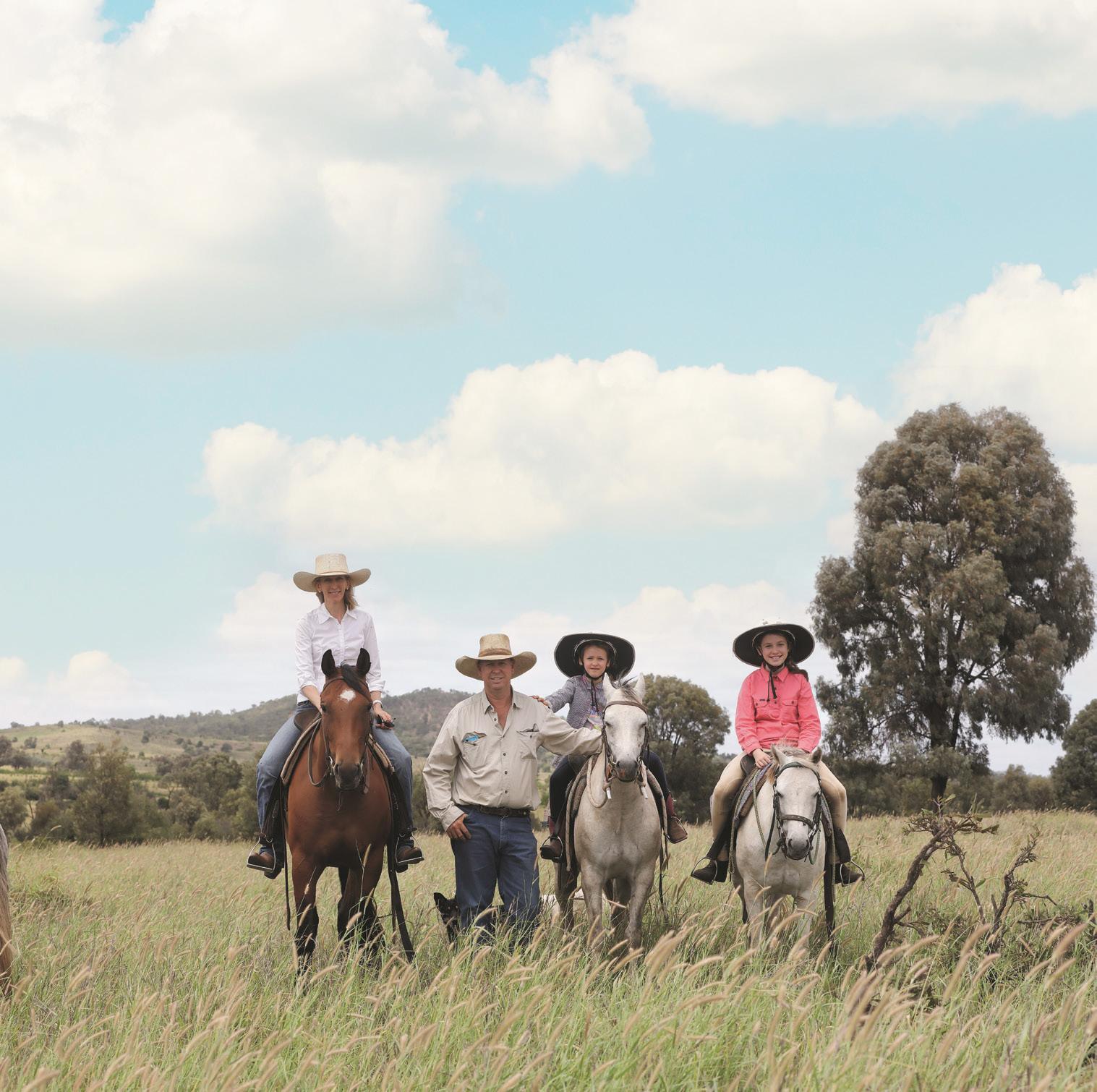
help them reduce numbers in advance of lessor seasons and it will give them more confidence to increase numbers in better seasons. The Proactives are starting to run gross margins on what winter crops they might plant.
Both farms are run by honest, hardworking people that are passionate about agriculture and the future of their land and business for future generations. Both are mixed farms with livestock and crops.
The first farm is run by the Reactive family and the second is managed by the Proactive family.
Currently, both families are focused on fixing flood gates, servicing machinery and mustering.
The Reactives are nervous about commodity prices and what declining prices might mean for them with a drier season forecast. They are nervous about having enough feed through the winter.
They can’t agree on what to sell or how many. Jack Reactive is reluctant to sell any, because they won’t get their money back in the current market. Mary can only remember the trauma on their family of the last drought. They are also a bit nervous about the next bank review as their costs have gone up. They have difficulty making decisions.
However, the Proactives are also starting to forecast their planned stock numbers. They’ve run three gross margins on different selling options and discussed the forecast and gross margins as a team. While they are feeling pretty good at forecasting, they know they need to upskill further in feed budgeting. They know that mastering this area will
After making changes to their accounting program, stock flows and cropping record keeping systems last year, the Proactives are starting to feel confident on what their cost of production is, and which enterprises are most vulnerable to a drop in commodity prices. With ongoing support from their RCS advisor, they are now looking forward to putting together their business budget.
As the Proactives have learned new skills through the RCS courses and programs, they are making timely decisions with confidence and are rewarded by being more in control, and less stressed.
If you want to gain the skills and knowledge to regenerate your land and business for your own peace of mind and family wellbeing, now is the time to start.
For more information call: rcsaustralia.com.au 1800 356 004, or email info@rcsaustralia.com.au

ADVERTORIAL RCS Farmer Magazine_210x90 ad_0423_PRINT.pdf 1 4/4/2023 9:26 am
Why the wartime sunflower bloom never happened in Australia
Can Australian farmers fill the gap in the market left by Ukraine farmers to supply the world with sunflowers?
Words IAN NEUBAUER
On February 24, 2022, the day Russia launched its invasion of Ukraine, an old woman in the Kherson region approached a Russian soldier to offer him a handful of sunflower seeds� “Put these in your pocket,” she told him, “so when you die on my land, flowers will grow from your corpse ”
This brave act spoke volumes about the defiance of the Ukrainian people and the hell they were about to unleash on the Russian invaders, who thought they would overtake the country in a matter of days�
It also highlighted the iconic status of sunflowers – soniashnyk in Ukrainian – that have been farmed commercially in Ukraine since the 18th Century and are the country’s unofficial symbol When Ukraine gave up its nuclear weapons to the Russian Federation in 1996, the defence ministers of both countries and the US planted sunflowers at the country’s largest missile base� And the Ukrainian flag? It represents a blue sky over a yellow sunflower field�
MORE THAN A SYMBOL
Sunflowers are crucial in fuelling Ukraine’s economy, while Ukrainian
sunflowers, in turn, help fuel the world Before the war, the country produced one-third of the global sunflower oil supply and two-thirds of sunflower meal, a key input for animal feed�

But the invasion threw a spanner into the trade and sent the price of sunflower products – already inflated by Covid-19 supply chain issues – to the moon
A month before the Russian invasion last year, sunflower oil was trading for US$1,348 per tonne, according to Trading Economics� Four months later, it hit a historical high of US$2,400 per tonne – spurring speculation that farmers in Australia, the 44th largest exporter of sunflower seeds in the world, could capitalise on the event
Sunflowers have been grown in Australia since 1974 and cover 3,000 hectares of agricultural land, primarily in northern NSW and southern Queensland but also in irrigation areas in southern NSW, the Riverina in Victoria as well as the Ord River catchment area of Western Australia
But the sunflower boom never transpired here
OR BUST
“It was the wrong time in the year for us,” says Nick Goddard, CEO of the Australian Oilseeds Federation� “Sunflowers are planted at the start of the summer, so we missed the boat to capitalise on the immediate global shortage and price bump As the year went on, the Ukrainians were able to export the seed by land after the ports closed, so the huge deficit in sunflower oil has somewhat been eased ”
This was obvious at the Isaccea-Orlivka crossing on the Romanian-Ukrainian border last year in June, where a kilometreslong queue of trucks waited to cross into Romania� Drivers had been waiting up to 10 days, and they were angry
Another reason why the Australian sunflower boom never happened, Nick explains, is “large plantings of sunflower crops in Europe Their summer starts in April or May, so they were well positioned to take up some of that buffer�
“Then there’s the fact that it’s a big challenge for growers in Australia to find someone to process their seeds into oil because there’s not a single dedicated sunflower crusher in the country; they’re
The Muster
l INTERNATIONAL TRADE
BOOM
THE FARMER MAY - JUNE 2023 8
all tooled for canola oil because it’s grown here so abundantly in our country�
“Some of the crushers did the numbers earlier on in the year but found out it wasn’t viable, even when the price for sunflower oil was so high And by October or November, the start of the planting season, the huge price premium had diminished,” Nick adds “So, by the end of the year, we saw a pretty much typical sunflower crop in Australia ”
BACKED UP BORDERS
In June 2022, a kilometres-long queue of trucks carrying sunflower seeds waited up to 10 days to cross from Ukraine into Romania.

Global prices for sunflower oil have continued to fall, losing another US$195 a tonne or 15 per cent in value between the start of 2023 and mid-February 2023�
Trading Economics estimates the trend will continue, with the price nearing US$1,000 per tonne by the end of the year
SUNFLOWER TOURISM
There has, however, been one small but noteworthy change to the sector in Australia – a response to the thousands of tourists who trespassed on sunflower fields late last year to snap photos of the bright yellow flowers for their social media feeds Instead of calling the cops or shooing photo hunters away, some farmers turned the problem on its head by remodelling their sunflower fields into agritourism businesses
“There are so many people who want to come and see sunflowers, but the last thing any farmer wants is to have people near their crops because of damage and the biosecurity risk,” says Roger Woods of Warraba Sunflowers
“So, we put two and two together and a couple of years ago planted a crop specifically to let people come and interact with them It’s $10 for adults, $5 for teenagers and kids under five are free ” l

Join us at a Community Event Alumnae, current and past families as well as prospective families are invited to join us for a relaxed social event. Registration is essential for catering purposes. Griffith — Thursday 25 May Wagga Wagga — Friday 26 May Narrabri — Friday 21 July Register at www.loretonh.nsw.edu.au/events
New chapter for Kids to Farms
The Kids to Farms project has been a success story in providing paddock to plate agriculture education for primary school students across NSW.
 Words MICHAEL BURT
Words MICHAEL BURT
5
,405 Primary School students from 84 schools right across the state These are the key numbers behind the success story of the Kids to Farms project�
Its chapters include visits to 25 farms, farmers visiting schools and adapting to a global pandemic with virtual tours, as well as thousands of food and fibre education packs for schools
Born in March of 2021, the NSW Farmers-led project has achieved the aim of bringing farms into the classroom and teaching children about where food and fibre comes from
NSW Farmers Projects Manager, Georgia Campbell said the project’s popularity with schools secured more than $820,000 in funding from the Federal Department of Agriculture, Water and Environment (now known as the Department of Agriculture, Fisheries and Forestry)
“2022 was a busy year for the project, with more than $57,000 in funding for almost 2,600 students to help them visit farms across NSW,” Georgia said
“It has helped simplify how farm produce gets from paddock to supermarket shelf for students and teachers – knowledge that is more in demand following major disruptions to supply chains over COVID-19 ”
The Federal funding has come to an end, but project officer Cassie Carslake is looking for opportunities to continue the good work of Kids to Farms
Georgia said NSW Farmers will continue to connect schools with farms and farmers in NSW through the Kids to Farms program to raise the importance of food and fibre education�
“The project is simply too important and has proven its worth in paddock to plate learning It also provides a conduit for farmers who want to connect more with schools and showcase the agriculture industry
“It’s been the same for the teachers involved in terms of opportunities to understand more about agriculture and farmer and how to incorporate it into the classroom�
“That’s why we will be advocating government to fund projects and initiatives that ensure students have access to farmers and the agriculture sector ”
DIVERSE LEARNING MENU FOR BLAYNEY STUDENTS
Apples, cherries, grain, wool and lamb featured on the paddock to plate learning menu for primary school students from St Joseph’s School in Blayney
Teacher Jane Webb said students embraced the ethos of the Kids to Farms ‘2 by 12’ program, which is to have two farm-related by the age of 12�
“We have had a fantastic experience with Kids to Farms,” Jane said “Both our incursions and excursions have been well planned and prepared to maximise student engagement and address key learning outcomes in the classroom ”
The incursion was a school visit from NSW Young Farmers committee member Charlotte Groves to learn about all aspects of sheep and grain farming, and the excursion was an education adventure at BiteRiot farm’s apple and cherry packing facility near Orange

“Our students loved being able to learn about aspects of farming they can relate to within their own lives, with many coming from or having some connection with the land
“The ability to access funding as well was a huge assistance for a small school like ours� It ensured our students are still able to engage in a variety of learning experiences outside of the classroom�
“We are very thankful for the experience of Kids to Farms and look forward to our next on-farm adventure ” l
The Muster
l EDUCATION
THE FARMER MAY - JUNE 2023 10
LEARNING ON THE LAND Clockwise from top left: St Joseph’s visit BiteRiot; Pelaw Primary School at Phoenix Park; St Ambrose students at Gracemere; Pelaw students at Phoenix Park.
Students at Tocal College get practical training on our large commercial farms. Tocal runs 1400 beef cattle, a 300 cow dairy herd, 120 stockhorses, Dohne sheep and a free range egg enterprise. Residential facilities available.

Apply now for 2024! Scholarship applications open until 20 November 2023.
Feedback from the frontline
“We were really impressed with the authentic farming experience provided for the children. They were engaged and asked many questions throughout the day and in the weeks following.” Year 1 Teacher, St Patrick’s, Gosford.
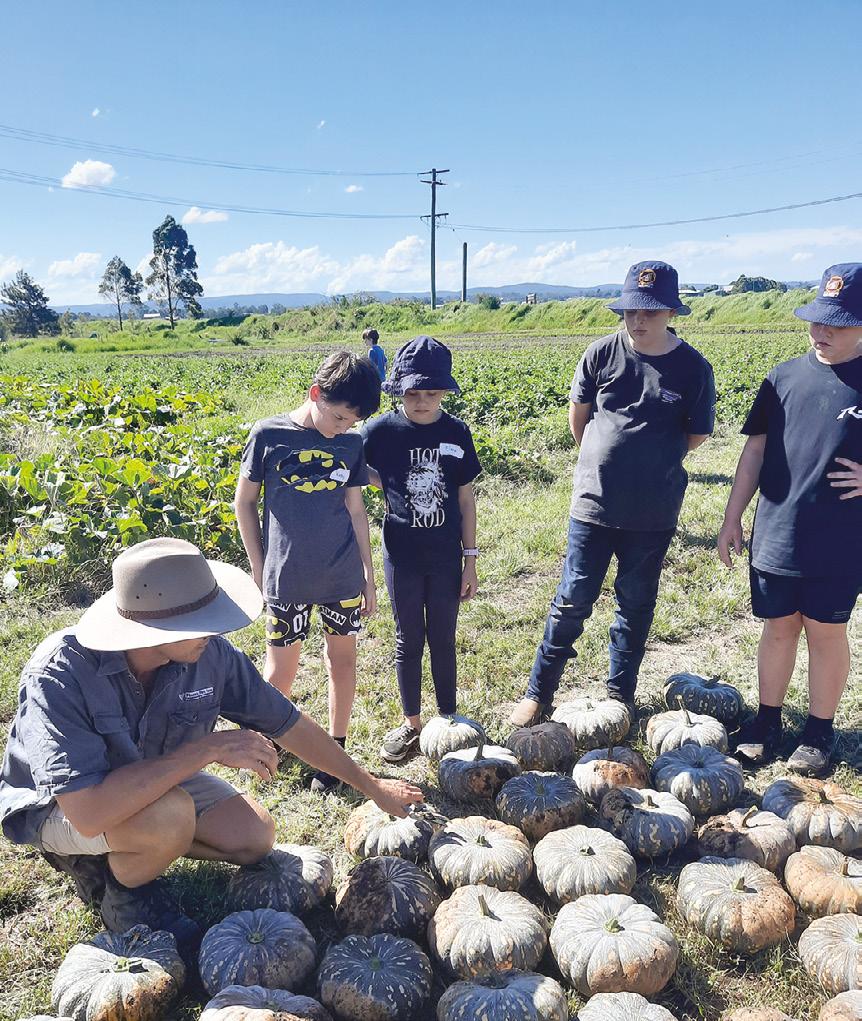

“I was actually surprised at how engaged our students were. A few students said afterwards ‘that was the best day ever!’” Kindergarten Teacher, Mt Victoria Public School.
“We were very happy, especially with the hands-on aspects of the excursion.” Stage 1 Teacher, St John’s Baptist School, Freshwater.
“We were extremely pleased with the day. Great organisation that kept the students engaged and learning.” Stage 3 Teacher, St Joseph’s, Blayney.
OPENDAYS
FridayFriday7and14July 29Sepand6Oct

1800 025 520 www.tocal.nsw.edu.au J23-030
Developing young farmers through our Youth Education program for over 50 years
The Muster
Connecting mothers and babies
Narromine-based Caroline Maxwell runs a thriving business as a travelling nurse and lactation consultant in Central Western NSW.
Caroline Maxwell has always been a country girl at heart� She grew up on a grazing property 70 kilometres outside Goodooga near the Queensland border Unable to decide whether she wanted to be a nurse or a teacher, she did a double degree in nursing and early childhood education at Charles Sturt University
Caroline then earned a graduate diploma in midwifery at the University of Technology in Sydney and continued her studies with a graduate certificate in child and family health nursing as well as becoming an international board-certified lactation consultant: the premier global credential in the lactation care profession
After living and working in Sydney, she and her electrician husband decided they wanted to move back to the bush to raise a family outside of Dubbo�
“We chose Narromine because it was just half an hour out of a big centre, but a small enough community that there was only one footy team and we’d get to know more people,” she says “We moved when my first baby was just 10 days old ”
LACK OF LACTATION SUPPORT
Caroline went back to work as a child and family health nurse in Narromine when her son George was 12 months old� “I was able to put all my passions in one place and spent the next nine years working there, apart from maternity leave periods with my next three babies
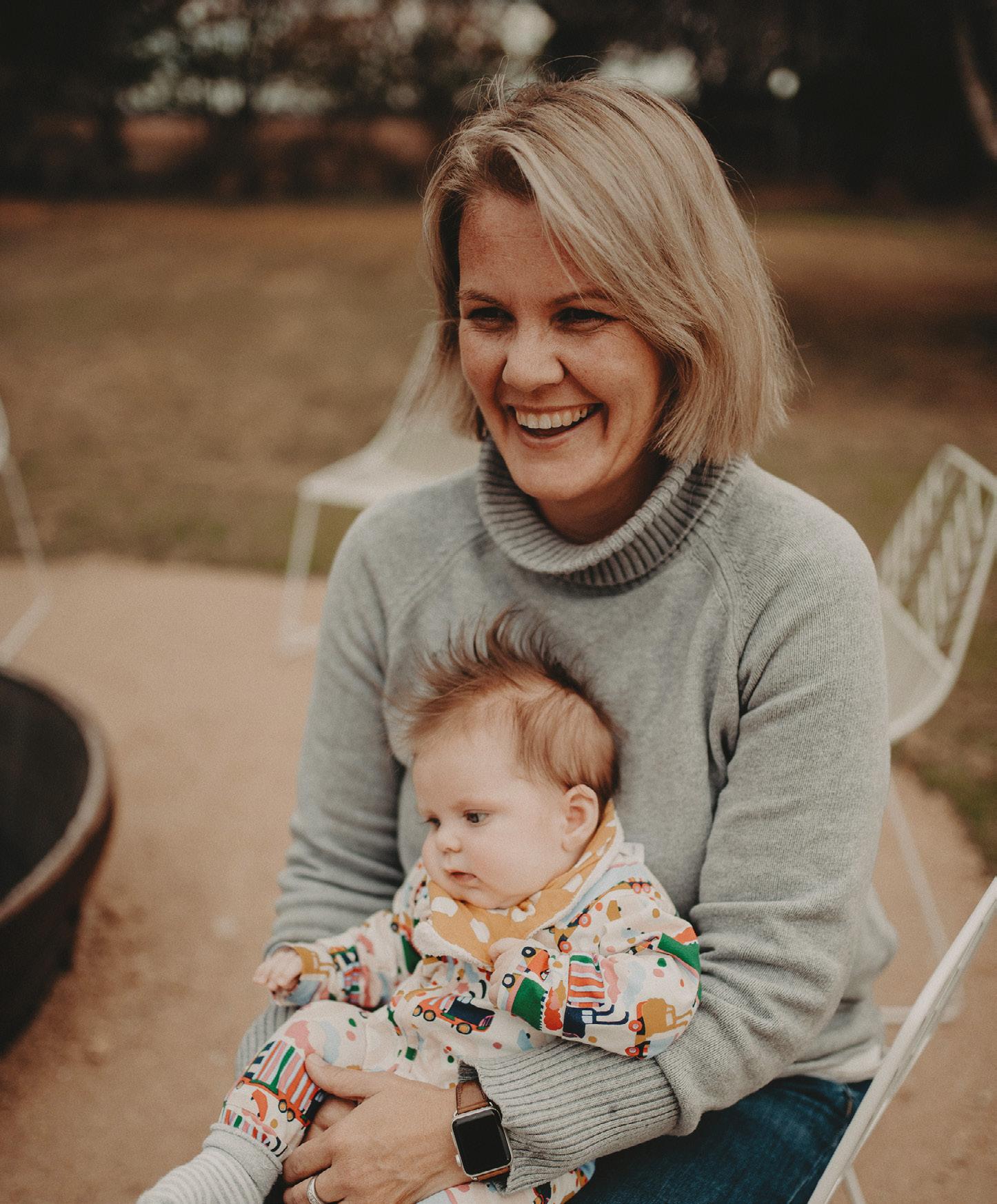
“During that time, I became aware of just how low breastfeeding rates were in the bush I decided it was time to fill a gap for rural women who were not getting enough professional help I couldn’t believe the lack of lactation support when I moved this side of the Blue Mountains,” says Caroline�
“Given how short hospital stays are after birth and that families often drive hundreds of kilometres back home with a newborn with only Google for help, there is a real need for caring, one-on-one support
“While 95 per cent of women set out to breastfeed, only about 39 per cent continue to breastfeed when their baby reaches four months
“Over my years as a midwife and lactation consultant, I’ve seen that the lack of encouragement for breastfeeding is a massive medical blind spot� It’s been scientifically proven that babies who are breastfed are better off, both because breast milk supports their immune system and because when they are held closely to their mother’s body this also supports cognitive and brain development Yet, the vast majority of paediatricians tend to be middle-aged men who focus on weight gain to the exclusion of these other vital benefits,” she says� “Not only that, it costs about $3,600 to bottle-feed a baby for the first year�”
“New mums in remote and regional Australia have the added burden of being isolated without the same intergenerational support network and knowledge base that our grandmothers had,” adds
NEW MUMS AND BUBS Caroline travels as far as 200 kilometres to see her clients for a face-to-face lactation consultation, and says that her reward is always their renewed confidence and knowledge of breastfeeding.
l HEALTH AND WELLBEING
Words SUSAN GOUGH HENLY
THE FARMER MAY - JUNE 2023 12
Caroline “As a result, they have a very real sense that they have to do it all or otherwise they’re failing I’m also seeing a lot of pressure on men to contribute to traditional women’s business while running a farm at the same time� Many do a great job, but there’s a lot of pressure ”
SUPPORTING NEW MUMS WITH EDUCATION
Caroline created her consultancy business Mumma Be in June 2020
“Most of my clients call me in the first couple of weeks of breastfeeding, or sometimes when things still aren’t working well after six or eight weeks,” she explains “New mums have so little information about what is normal, and they doubt whether they’ll ever be any good at breastfeeding They worry that they don’t have enough milk, what a good feed looks like and why their baby is unsettled or crying�
“I take a holistic approach that is all about offering reassurance, giving practical breastfeeding tips, explaining the wide range of normal baby behaviour, and suggesting that they meet their baby where she or he is at each day
“Most people think it’s all about the breastfeeding but it’s so much more than that� I focus on the mum, her health history and triggers� We discuss what she’d like to achieve and what might be causing problems I also help to adjust expectations by explaining that babies are not predictable robots, but just little
people with sometimes erratic behaviour� In the process, I try and help remove the mum’s sense of guilt and failure, which can become a self-fulfilling prophecy Together, we put together steps that will help mums get as close as possible to their goals
“Lactation consultants may have an airy-fairy image for many people but the services we offer are very practical,” says Caroline� “I’ve diagnosed babies with tongue-tie that had not been picked up in the hospital or by paediatricians, even after four months when a mother’s milk has dropped off because of her baby’s difficulty with sucking For mothers in remote areas, they still must travel long distances to get to a doctor or dentist in Orange, Bathurst, Forbes or even Sydney to snip their baby’s skin under the tongue so that it’s not anchored in the bottom of the mouth

“The vast majority of my clients breastfeed for 12 months, which is my
reward� I’m trying to get to as many women as I can before they feel defeated� As a country girl, I like to use animals as an analogy I’ve never seen a cow reject her calf because she fed less than three hours ago We should trust our own animal instincts about taking care of our babies ”
Caroline gets most of her referrals through word-of-mouth and believes her job is to make herself redundant as soon as possible� She’ll travel as far as 200 kilometres because face-to-face consultations are always better – but if someone is really remote, she’ll also consult over Zoom
“At the end of each session I ask: ‘How were you feeling when you reached out to me?’ And so many clients use words like ‘desperate, overwhelmed and scared’�
“Then I ask: ‘How are you feeling now?’ And they use words such as ‘reassured and confident’ This kind of feedback is what keeps me going ” l
“I take a holistic approach that is all about offering reassurance, giving practical breastfeeding tips, explaining the wide range of normal baby behaviour, and suggesting that they meet their baby where she or he is at each day.”
–CAROLINE MAXWELL Travelling nurse and lactation consultant
MAY - JUNE 2023 THE FARMER 13
The Muster
Horses for courses
The Remount program assists those who have served to ‘get back in the saddle’ and reconnect through horsemanship.

Former Australian Defence Force veteran Simon D’Arcey participated in the Remount horsemanship program two years ago and was instantly hooked He had zero riding experience, but the whole connection with the horse was so compelling it changed his life�
He’d spent 25 years in the regular army before transferring to military intelligence for 12 years He was deployed overseas six times, to the likes of Timor Leste, Iraq and Afghanistan
“Basically, I’d been through the mill,” says Simon “Over the last few years, I was less and less comfortable with people� Ironically, I almost pulled out the afternoon the program started because I was so nervous, uptight and anxious� But without this experience I would never have started my journey to recovery
“It wasn’t until I met Ben Maguire and his team of volunteers and horses at Remount who had absolutely no agenda but to welcome and support people like me that I felt I could trust again,” he explains�
HOW REMOUNT GOT STARTED
Remount is a not-for-profit delivering free-of-charge horsemanship programs for Australian Defence Force and first
responders who are experiencing stress related to their service, PTSD and/or physical injury
The weekend program runs 10 times a year on Gunben, Ben and Marina Maguire’s 300-acre cattle breeding property at Bowning, northwest of Yass�
Ben Maguire developed the kernel of the Remount concept when he was CEO of the Australian Stockman’s Hall of Fame at Longreach in Queensland
“I saw first-hand the incredible power of the horse to heal when I saw a team of 12 veterans on horseback working at a camp-draft competition in Longreach,” says Ben� “It was magic�”
Not long afterwards, he met with the people behind the Queensland RSL-supported Mates4Mates program They put him in touch with US Marine colonel and Texas rancher John Mayer who had previously run the Wounded Warrior Regiment He had played a key role in creating the Jinx McCain Horsemanship Program in the States where veterans participated in challengebased equine therapy�
“Whereas John travels the United States borrowing ranches, horses and volunteers for his program, we have
everything set up in the one place at Gunben,” explains Ben
“We moved back home to the Yass area and decided to start a non-profit with great stables, tack room, arena and accommodation to help veterans and first responders,” he says� “The focus would be learning about horses and building a human-and-horse team relationship to then work with cattle We found like-minded people in the district who were keen to volunteer and who underwent safety, mental and physical first-aid training
“Everything in the program is high quality� We have excellent horses as well as nice bed linen and good healthy food�”
Remount is delivered at no cost to veterans and their families� All catering, on-site accommodation and tuition is complimentary Since starting eight years ago, more than 400 men and women have gone through the program Each weekend is made up of six guest ‘drovers’ and six volunteer ‘stockmen’ riding a mix of prime registered Australian stock horses and quarter horses�
Remount has developed quite a reputation through its Facebook and Instagram pages as well as through word of mouth
l COMMUNITY
THE FARMER MAY - JUNE 2023 14
Words SUSAN GOUGH HENLY
A COMMUNITY SERVICE
About one-third of guests remain highly connected with Remount after their experience, volunteering with the program, while many are still a large part of the community as friends. Remount is often described as a life-changing experience for those who take part.
“We publish the dates on January 1 and spaces are filled within 24 hours, then we have a waitlist� I ask applicants to write me a letter telling me their story and I get up to 150 applications a year� There is no criteria It’s really just a matter of first-in, best-dressed,” explains Ben “We just ask people to let us know if they have acute issues and to give us a medical/emergency contact and a list of their medications
“I’ve learned that our winning formula is our low bureaucracy,” he says� “With government programs, there’s a lot of filling in forms and clinical assessment which can almost feel like an insult to those who’ve given so much for their country That very bureaucracy can cause a lot of pain and feelings of disempowerment
“At Remount, by comparison, we are just a normal place with ordinary people where you can just breathe� Of course, we are aware of people’s vulnerabilities, but we bring a spirit of optimism,” explains Ben� “We like to give people the feeling that, ‘You’ve got this� You can do this’� Most guests have limited or no experience with horses, but the Remount program is so much more than the sum of its parts It’s both subtle and substantial at the same time ”
BACK IN THE SADDLE
So, what happens during the weekend?
People arrive on Friday afternoon to a welcoming sense of calm� They can even muck in to help if they’re early by making beds There’s a bit of administration and they receive their Remount work shirts, which offer a different identification to a military or first responder uniform After an early dinner (Ben’s wife Marina does all the catering with help from neighbours), it’s early to bed�
On Saturday morning, guests meet the volunteers over an early breakfast� Ben shares Remount’s story and outlines the plans for the weekend before everyone goes out to catch the horses Next comes a groundwork session to learn the language of the horse and demonstrations on how to saddle up Lots of insights are given about how to build a bond with the horse and the importance of being both vulnerable and kind� Then it’s all about riding lessons in the arena and the paddock� After lunch, the ‘stockmen’ work with the ‘drovers’ to show them how to work as a team with their horses in order to muster cattle Later in the afternoon, one of the board members who is an accomplished leatherworker teaches everyone how to make their own belt from scratch Dinner follows with long chats around the campfire�
On Sunday, it’s back on the horses again and, depending on the season, there may be a muster to move cattle to another paddock or some camp drafting events in the arena Over a final lunch, everyone sits around and shares reflections about the weekend before bidding farewell


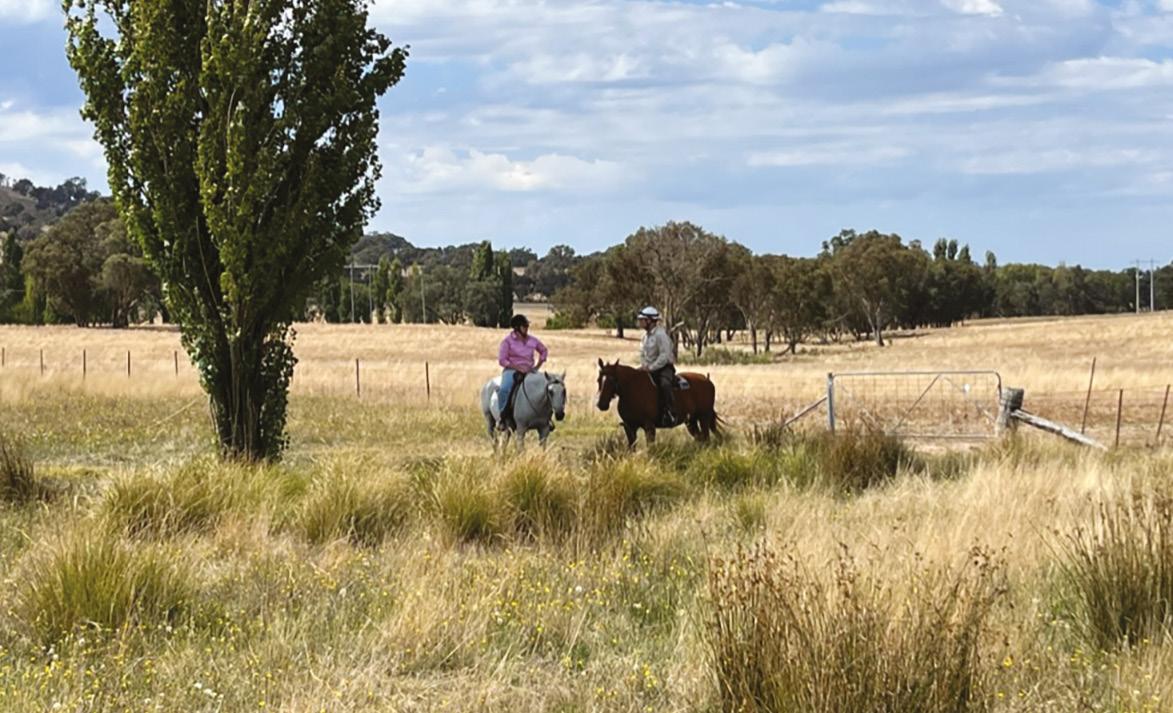
>
MAY - JUNE 2023 THE FARMER 15
The Muster
CREATE AFFORDABLE LIVING SPACE ON YOUR PROPERTY WITH OUR CONTAINER HOMES
Our expandable container homes is a great solution for anyone looking to create a comfortable and sustainable living space on their property or generate extra income.
From granny flats, agri-tourism, farm stays, staff accommodation container homes can be tailored to suit your needs, the possibi
• Customised floor plans for 20ft, 30ft and 40ft options
• Fully council compliant construction
• 75mm thick exterior walls
• 2.9m high ceilings
• Double glazed windows
BREATHING SPACE
The Remount program runs 10 times a year on Gunben, Ben and Marina Maguire’s 300-acre cattle breeding property, and provides veterans and first responders a chance to breathe, connect and recharge – with the magic of horses.




achaustralia.com.au
AFFORDABLE CONTAINER HOMES - EXPANDING YOUR SPACE AND YOUR POSSIBILITIES. Contact us now at
“People understand that nobody is making a buck doing this,” says Ben “It is a sincere community service that reflects how much we value their contributions� We just want to acknowledge their service and their trauma and give them a lifeaffirming experience
“None of us are specialists with experience in clinical health problems or acute psychiatric care� Instead, this is a totally non-judgmental environment with a very low barrier to entry,” says Ben� “We’ve had people get triggered and shut down but everything’s been managed well and we’ve not had any medical involvement ”
And what do they know about their guests’ experiences down the track?
“About one-third remain highly connected with Remount, some even buying horses and volunteering with the program,” says Ben� “About one-third are still a large part of our community as friends and one-third acknowledge how amazing the experience was then move onto other activities because they can more easily get on with their lives
“We may not hear anything until six
months later but there is so much good news Some may have stopped drinking, or got a new job, others are working on their marriage, sleeping better, developing a new confidence, or are no longer considering suicide because of two days in the saddle,” says Ben� “Simon, for instance, lost weight, stopped drinking, bought a horse and is now one of our most valued volunteers
“I’ve learned that horses are incredible non-verbal communicators,” says Simon, who is now head of security for the
National Gallery of Australia “If you are there with and for the horse, he will be there for you I’ve always been such a results-driven person but with my horse I get a concrete response from a sentient being telling me just to be here now�
“When I volunteer at Remount I see so many former ADF personnel who are struggling and anxious I can assure them by saying I was a former ADF and there’s no agenda or judgement here What you see is what it is You can see their relief in their body language ” l
Opportunities for farmers through the NSW biodiversity market - May 2023 workshops
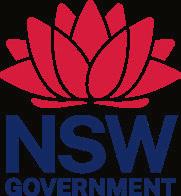
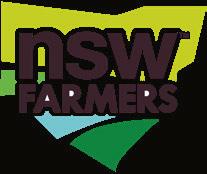
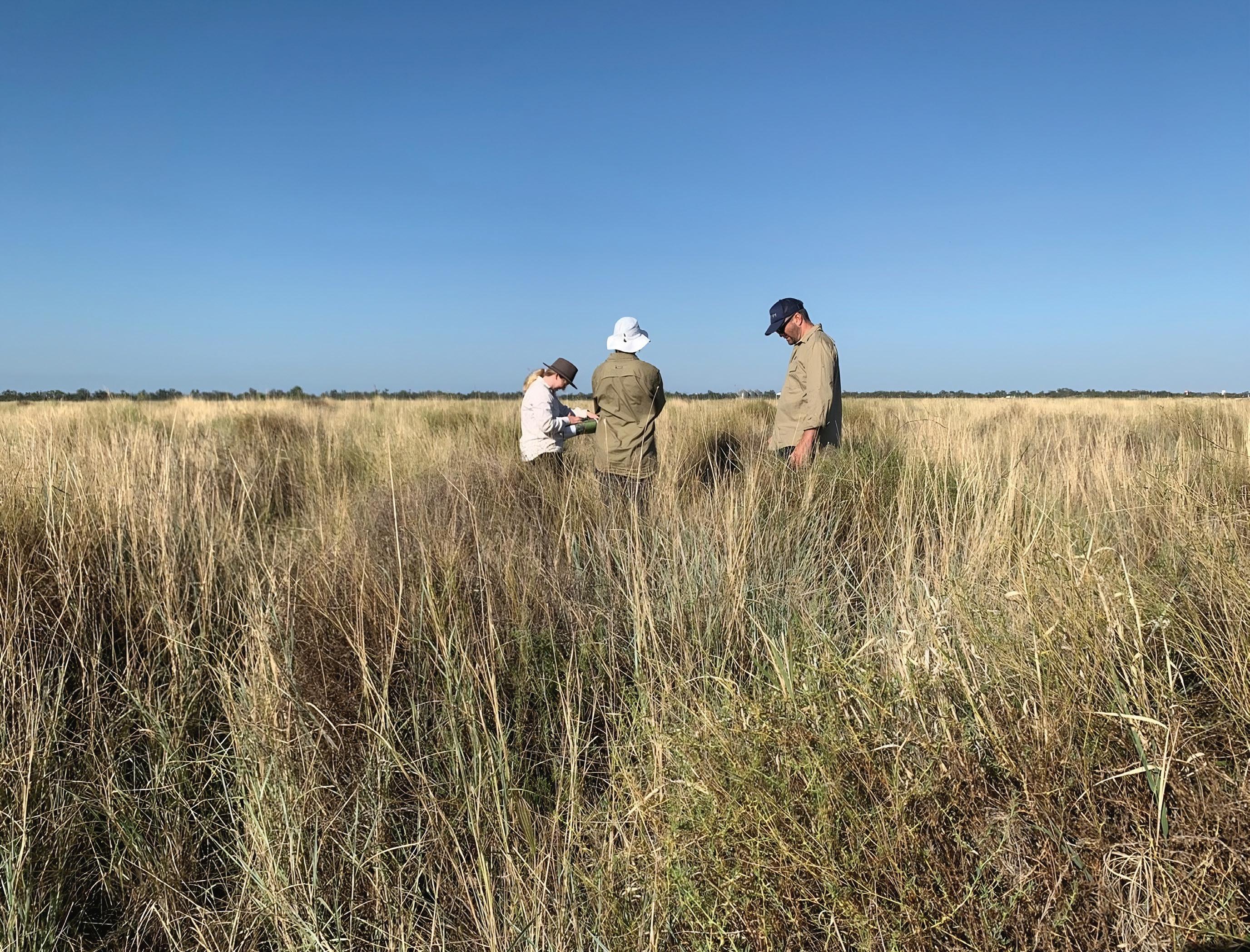
The workshops will focus on: how to generate & sell biodiversity credits how biodiversity opportunities can be integrated with other farming activities benefits for landholders in providing revenue and funds for land management environmental benefits

Wagga Wagga RSL Club
Thursday 4 May 2023 | 9:30am - 12:30pm
Dubbo RSL Club
Wednesday 17 May 2023 | 9:30am - 12:30pm
The workshops will feature speakers from the Biodiversity Credits Supply Taskforce & include a Q&A session. Food and drink will be provided. To express your interest in attending, visit www.nswfarmers.org.au/bcst
LIVE EVENT
“I saw first-hand the incredible power of the horse to heal when I saw a team of 12 veterans on horseback working at a camp-draft competition in Longreach. It was magic.”
–BEN MAGUIRE Founder of Remount
CONNECTIVITY THE KEY TO AG PRODUCTIVITY
Digital agriculture, enabled by connectivity, is set to play a crucial role in the New South Wales agriculture sector achieving its goal to increase production to $30 billion as part of Australian ag’s push to boost output to $100 billion by 2030� Connectivity is the threshold that enables agtech to operate, and giving farmers better access to data to make informed decisions and improve productivity by automating tasks will be key to achieving this goal
While realising the agricultural sector goal will be a great achievement nbn’s Executive Manager of Agriculture & Health Robert Hardie notes that there is a significant opportunity for the agtech industry
“We obviously see that increasing the proliferation of digital ag and extending the reach of connectivity across the Australian landscape will be essential to transform the digital capabilities of the agriculture sector However, it goes further than that Research released in 2020 by nbn suggested there was a $15 6 billion opportunity from the adoption of internet enabled digital agriculture ”
$750 MILLION UPGRADE TO TELECOMMUNICATIONS

As part of that transformation, nbn is partnering with the Commonwealth Government to invest $750 million to upgrade broadband connectivity across regional Australia The company is upgrading its Fixed Wireless network, with enhanced capability and reach that will enable up to 120,000 premises (that are
CONNECTING THE DOTS
nbn is partnering with the Commonwealth Government to invest $750 million to upgrade broadband connectivity across regional Australia.
currently serviced by nbn Sky Muster) to access nbn fixed wireless for the first time�
nbn aims to introduce two new wholesale higher speed plans on the Fixed Wireless network next year – Fixed Wireless Home Fast, which will deliver a wholesale peak information rate of 100-130Mbps downlink speed and an uplink speed of 8-20Mbps* and Fixed Wireless Superfast, which will deliver a wholesale peak information rate of 200-325Mbps downlink speed and an uplink speed of 8-20Mbps�*
“Home Fast will be available across the whole fixed wireless coverage area and Superfast will be available to approximately 85 per cent of the expanded Fixed Wireless coverage area These enhancements will enable faster and more consistent speeds overall across the Fixed Wireless network, including in the evening� This will allow more people to be online at the same time to work, study, and stream with less buffering,” says Robert�
“In addition, extending the Fixed Wireless footprint will free up the capacity for satellite customers as some people transition from satellite to Fixed Wireless For those that remain on nbn satellite, nbn is currently trialling a new Sky Muster Plus plan for up to 15,000 eligible users that is intended to deliver 100 per cent unmetered data usage with faster burst download speeds up to 100 Mbps� The trial aims to provide people with more flexibility in how they use their internet without needing to manage a data allowance and nbn hopes to launch the product later in 2023 ”** Satellite will continue to be a vital part of the connectivity picture for extremely remote farms
Digital agriculture is booming but enabling connectivity is a vital piece of the agtech puzzle.
–
SPECIAL REPORT CONNECTIVITY
Words DARREN BAGULEY
THE FARMER MAY - JUNE 2023 18
BARRIERS TO AGTECH ADOPTION REMAIN

Awareness of the types of connectivity, whether it is satellite, fixed wireless or mobile broadband, remains the number one barrier to adoption of agtech for farmers, and a lack of knowledge about available solutions and how to utilise them is another challenge Uncertainty about which solutions will solve their problems, and the risk of making a costly decision that may not meet their needs are also significant barriers, notes Robert�
“Proprietary solutions that are designed to solve specific problems abound, but farmers who have started the journey down the agtech road quickly realise they want a solution that can tell the whole story in one place This lack of information and understanding can lead to farmers being locked into expensive or unnecessary solutions that do not meet their requirements It is essential to know what connectivity solutions are available to deploy devices and systems on farms effectively�”
EXTENDING CONNECTIVITY BEYOND THE HOMESTEAD
“An emerging problem is the need to extend the nbn network connection from the house into the paddock to connect sheds, stockyards, machines and beyond Workforce shortages are an ongoing challenge that can be addressed through automation, which also requires connectivity,” says Robert�


“If a farmer has mobile signal across most parts of their farm, that’s great, but what if there is a black spot in an area that really needs to be connected? There’s a conversation to have about exactly how much connectivity is needed – what does the farmer want to be able to do in this location?”

nbn and the National Farmers’ Federation (NFF) recognised that many farmers are uncertain when it comes to answering those questions� In response the two organisations developed Australia’s first on-farm connectivity guide� Launched in November 2022, the guide contains almost 100 phrases commonly used in the on-farm connectivity space to help explain to farmers what various terms mean
STAYING IN TOUCH
Satellite will be a vital part of the connectivity picture for extremely remote farms, says Robert Hardie (below right), Executive Manager of Agriculture & Health at nbn.
In addition, the Regional Tech Hub, funded by the federal government and currently delivered by the NFF, provides a vital resource for farmers in regional Australia� It offers free connectivity audits, fact sheets, and other resources to help farmers understand their connectivity options and resolve issues
Improving connectivity is crucial for Australian farmers to improve productivity, profitability and quality of life through automation and accessing better data to make informed decisions� Farmers face barriers such as poor connectivity, lack of technological literacy and uncertainty about the available solutions� Nevertheless, help is available for farmers seeking to navigate the maze of technology and upgrades to existing networks are expected to provide improved connectivity to help meet Australia’s future data needs
*Actual end customer speed will vary across the network as a number of factors influence this, including the particular customer applications in use at the time, equipment software and in-home wiring, and the number of concurrent users on the nbn Fixed Wireless service.
**The Fair Use Policy will continue to apply and nbn may, at its discretion, shape certain types of traffic (in particular gaming/software updates and cloud uploads in the evening) to slow speeds, if required, to protect the network. For details on fair use conditions, contact your internet service provider. l
MAY - JUNE 2023 THE FARMER 19
NFF and nbn On-Farm Connectivity Guide
The Sapphire City still sparkles
An elegant town set along the McIntyre River in northern NSW, Inverell has ridden the waves of boom and bust to come out on top as a remarkable success story.
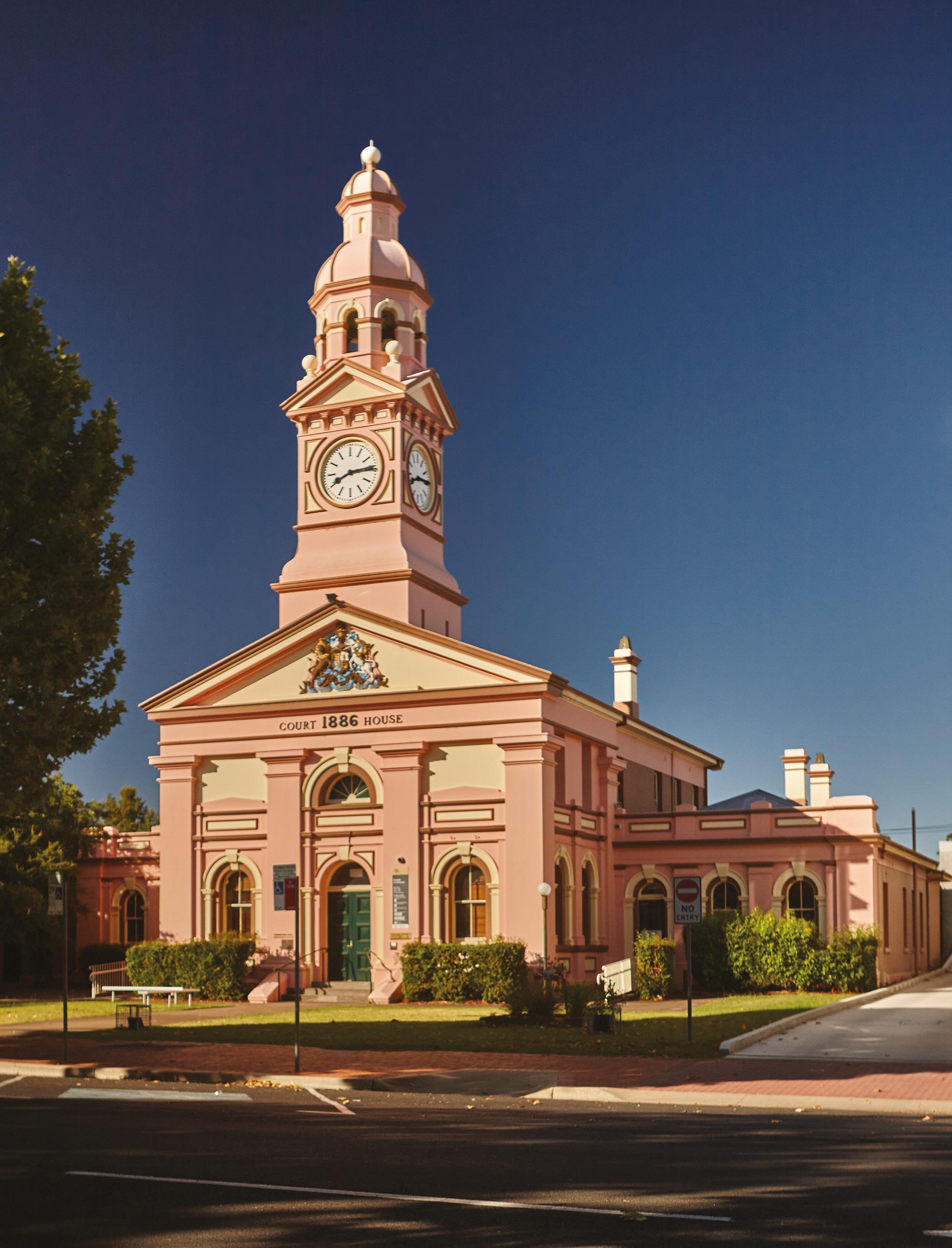
–
Words LUCY JONES
Photography ANTHONY ONG
THE FARMER MAY - JUNE 2023 20
The story of Inverell is similar to that of many towns in regional Australia: founded on cattle and farming in the mid 1800s, it flourished during a mining boom Sapphires were discovered in the area around the turn of the 19th Century and the town still bears the nickname ‘the Sapphire City’ An agricultural downturn in the mid 1960s led to a population decline and today Inverell has levelled out at around 10,000 residents� Yet, while many larger towns struggle to fill their main streets, Inverell has firmly established itself as a vibrant regional hub
Striking buildings dating from the town’s heyday line Otho Street, the main thoroughfare The pastel pink courthouse and ornate Town Hall take pride of place, with a stately row of well-preserved shops beyond�
“The combination of a strong agriculture industry, vibrant community spirit and investment in infrastructure has helped to make Inverell’s town centre a thriving and bustling hub of activity,” says Laura Cush from the Inverell Chamber of Commerce The Chamber of Commerce is a true champion of local small business They are lauded for listening to business owners, being open to change and trying new things� It’s an innovative approach that has played a role in the town’s remarkable success� Combined with a proactive local council that keeps the streets looking immaculate, they’ve created a town that’s both eminently liveable and appealing to visitors
Drive down the main street of Inverell and it immediately feels prosperous and bustling While local
operators like Bindaree Beef and Boss Engineering employ many, there has also been a recent shift to small businesses and boutique tourism� And business is booming� It’s driven largely by locals, young couples and women who are proud to have grown up in the region and are eager to give something back “The locals that love Inverell know how special it is,” says Emily Tomlinson, part owner of the stylish boutique hotel Oxford on Otho Phoebe Croft, who runs The Welder’s Dog brewpub, agrees: “We’ve always felt that Inverell is not just an ordinary town�” This passion has inspired them to leave their careers and start something new�

REBUILDING A LOCAL LEGEND
When long-time local Wendy Cracknell saw the dilapidated Oxford Hotel up for auction in 2016, she felt a strong desire to return the grand old dame to her former glory� “We were semi-retired when my husband Gary saw it was up for auction, and we went and had a look� I don’t think it had too much loving in the recent past but as soon as I walked into the place, I felt a special ownership and I just wanted to do it,” Wendy said “It was like a fuzzy feeling; I thought she needs us, this old girl ”
Inverell is a buzzing hub, filled with boutique shops, brewpubs, cafés and more – many operated by passionate locals, young couples and women who want to give back to the town.

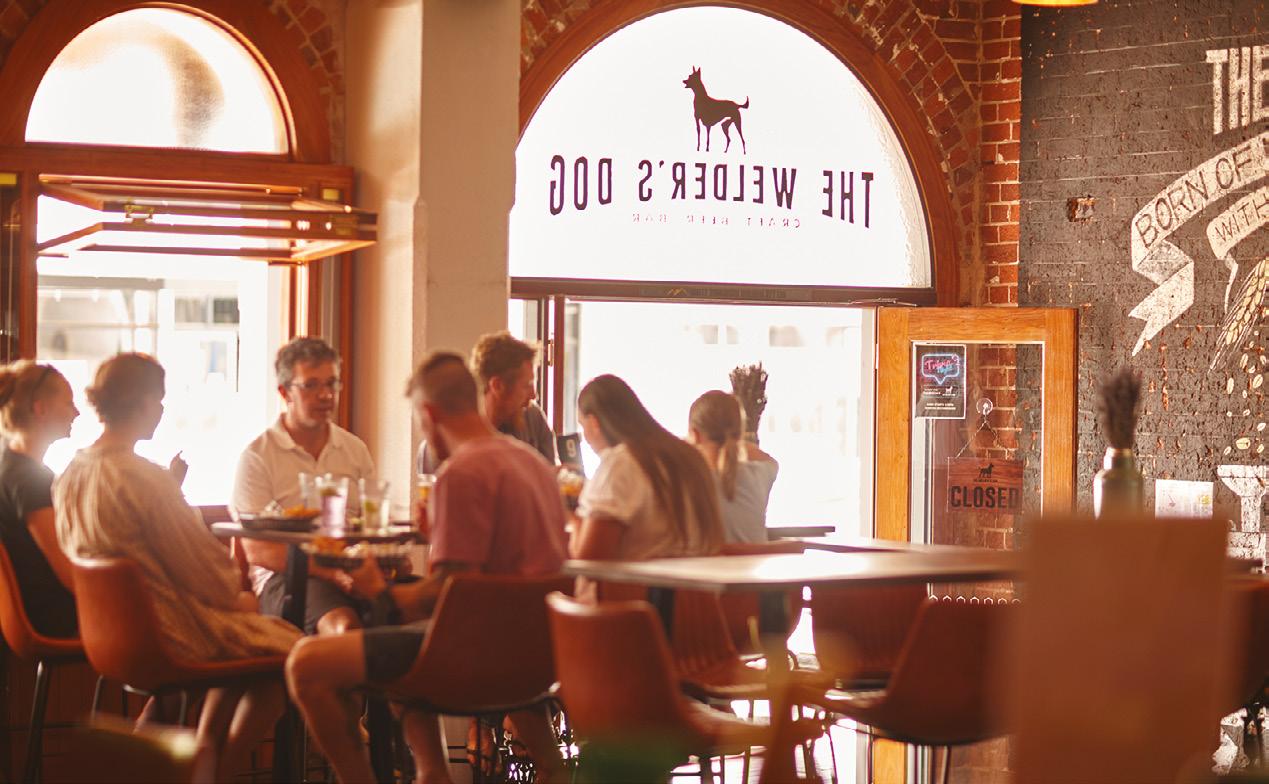
SPOTLIGHT ON A TOWN INVERELL
A VIBRANT HUB
> MAY - JUNE 2023 THE FARMER 21
The Cracknells partnered with their nephew, builder Brett Tomlinson, and his partner Emily to redevelop the 1886 property�
The Tomlinsons are born and bred Inverell stock and live on a property just outside of town with their sons Henry, 3, and Paddy, 18 months
“It’s not unusual for Brett to come home with a crazy idea,” says Emily “This time it was: do you want to buy a pub?” She initially said no, but was soon won over� Upstairs was a rabbit warren of small rooms, most leased out on a weekly basis with no ensuites and in dire need of updating� Rebranded as the Oxford on Otho, the hotel now has just eight rooms (with two more to come) in a chic industrial style All have private bathrooms and three feature an indulgent freestanding bath positioned under a skylight “It’s the only thing of its kind in Inverell,” Emily says And it’s full most of the time
The Tomlinsons bought another faded pub, The Australian Hotel, in July last year and plan to work their magic again, renovating the rooms in an Art Deco style and keeping them at a slightly lower price point�
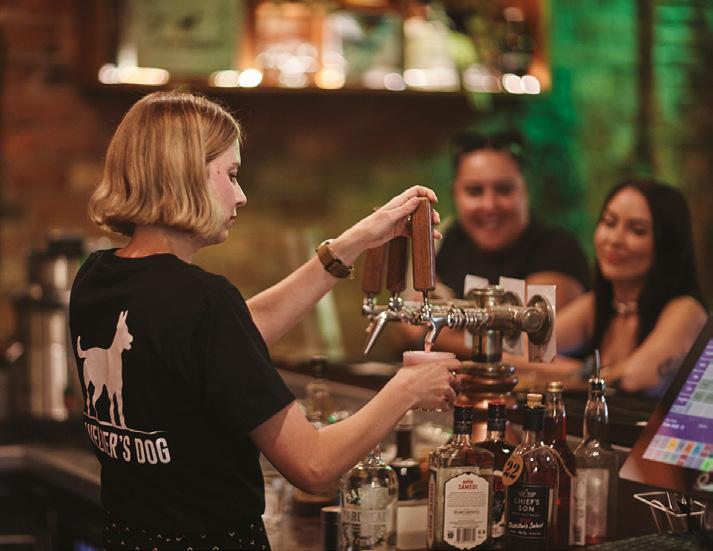
Downstairs at The Welder’s Dog, owners Phoebe and James Croft are also proud to be doing something a little different High school sweethearts and now parents to toddler Elke, Phoebe and James left careers in teaching and building to take over the venture The Welder’s Dog is a New England success story, a familyowned brewery growing barley in Wee Waa and with outposts in Armidale, Tamworth and, now, Inverell� And as with so much in this town, it’s a thoroughly local story; James’ brother Tom is co-owner of The Welder’s Dog group and the pair went to school with the pub’s owners, Brett and Emily “We’re trying to bring some variety to town,” says Phoebe “We do a lot of events, live music, drag bingo, paint and sip, art stuff, pub trivia� It’s about making it fun and always looking for the next thing to do�
“It turns out, people in Inverell are very progressive,” she says� “That was the most nerve-wracking part of our business We were spending a lot of money to run these events, pay for top-tier drag queens, and we were worried that no one would come But it’s been really eye-opening for James and I We can do this cool stuff in a small town and people will come We’ve discovered there’s a large, young, gay population, but heaps of farmers will come as well�” Challenging expectations has also proved rewarding for the young couple � “What’s most exciting for us is meeting people who have come from out of town and they aren’t expecting it to be so beautiful or trendy or cool That’s really uplifting ”
A FASHION CAPITAL
Though it’s just a fraction of the size of neighbouring towns such as Armidale and Tamworth, Inverell is easily the shopping capital of the region� Otho Street is dotted with half a dozen stylish boutiques that wouldn’t be out of place in Sydney’s Double Bay�

“It’s very common to hear that our customers have travelled from other surrounding country towns such as Armidale, Glen Innes, Tamworth and Moree to


SPOTLIGHT ON A TOWN INVERELL
THE FARMER MAY - JUNE 2023 22
A BIT EXTRAORDINARY Locals and families have teamed up to create fantastic new tourism drawcards for the town, including the chic Oxford on Otho hotel, and the soon-to-be-opened Australian Hotel.
space and grew very quickly, expanding to include a clothing store in 2020� We have an amazing local following plus a strong presence online and post parcels Australia-wide daily�”
Across the road, Eclectic House is equally appealing, with a chic mix of fashion, and a café with a focus on sustainable and ethical brands Co-owner Claire Wright lived and worked in developing countries such as Indonesia; what she saw in the sweatshops led her to develop one of Australia’s first ethical clothing brands, House of Bees� Now, along with partner Bel Thompson, she stocks the store with brands that do good for the planet� l
Why Inverell?

“We’re a bit off-the-beaten track and away from the coast. But it’s absolutely worth the trip.” Phoebe Croft, owner The Welder’s Dog
“There’s no other place like it. It’s so friendly and so supportive; you’re never on your own. And everyone is proud that they’re involved in something so beautiful.” Emily Tomlinson, co-owner Oxford on Otho

Inverell, because it’s known to be a hub for boutique shopping,” says Bec Devlin, co-owner of Clover & Co�
Bec and business partner Casey Grills opened their store in 2017 Both locals, the pair met through their partners, who are identical twins and run the Inverell branch of LJ Hooker Real Estate, and now have a total of five children under eight
Clover & Co is one of the street’s prettiest spaces; impeccably styled and bursting with colour, it occupies a double shopfront with coffee shop Hey Joe tucked inside� “We shared a love for homewares and gorgeous baby goods,” says Casey� “We started off in a very small
DOING THINGS
DIFFERENTLY
Challenging expectations is all part of the Inverell experience: see a drag show at brewpub The Welder’s Dog, or shop for unique, sustainable and ethical fashion at Eclectic House.
Support for NSW farming businesses

We are helping business leaders support their people dealing with stress, separation of work and home life, labour shortages, seasonal work and more.
Let us help you achieve big benefits with small changes. Our coaching service is free and confidential and available at a time convenient to you.
Book now to get started: mentalhealthatwork.nsw.gov.au
PRIMEX PREVIEW
With a tagline of ‘Fire up Farmers’ Norco Primex Field Days 2023 in Casino is back bigger and better than ever in its usual May timeslot. –
Words DARREN BAGULEY
Despite continuing COVID-related supply issues, Primex 2023 will have its biggest-ever display of agricultural equipment as it celebrates its 39th year of showcasing agricultural innovation and production As part of the lead up to its 40th Anniversary in 2024, it will be announcing its Hall of Fame� This award will acknowledge individuals and businesses who have contributed to the event over many years�
NEW TECHNOLOGY & INNOVATION
According to Primex Field Days managing director, Bruce Wright, “Farmers, want to see the latest machinery and that’s certainly what they will get when they come to Primex this year� Exhibitors in the machinery and equipment side know what stock they’ve got now and what is coming through�
“In particular, the agtech sector is going a million miles an hour and we will have more of that equipment at this event than we’ve ever had Much of the tech is focused on measuring and recording – whether it’s fuel or water tank levels through to pasture improvement, weed management and livestock management There’s even a company that’s working on facial recognition for cattle�”
A lot of the tech is focused on animal health and Bruce adds that the field day will again feature a Health and Wellbeing hub “Farmers’ health and wellbeing is very topical now It’s always been a factor, but it hasn’t been as openly discussed and resourced as it is now and we need to keep that conversation going
AFFORDABLE LIVING & VALUE-ADDING
A new initiative for Primex Field Days that launched just weeks before the event kicks off is the Affordable Housing hub� While the focus on affordable housing is a response to issues the region faces in the wake of the 2022 floods, it’s also reflective of legislation changes As of December 1, 2022, landholders can run activities such as farm stays, camping, pickyour-own orchards, cellar doors, restaurants or cafes and events under simplified planning rules�
EDUCATION IS THE KEY TO FUTURE FARMING
Bruce says yet again Primex Field Days’ Education and Careers hub is set to generate a lot of interest “We have a lot of exhibitors who are already looking to recruit and find people to enter the job space As part
of our Education and Careers hub, we’re working with the education department and our partner, Southern Cross University, to put together a whole range of different elements to offer focus and the means for someone in secondary school to work out which part of the supply chain they can fit into
“Youi don’t have to be a fifth or sixth generation farmer to work in ag,” he adds� “You might have an interest in chemistry and so work in a distillery� We’re offering a broad scope across the supply chain to help keep the next generation in the region working in agriculture ”
FORESTRY AND TIMBER HUB
One of Primex Field Days’ main differentiators has always been its Forestry and Timber hub� Bruce says 2023 will again feature the latest in forestry machinery, products and innovation and it will also host the Forestry and Timber Industry Collective� “The Forestry and Timber Industry Collective has been on the drawing board for probably five years and a whole range of factors have seen it coming to fruition this year
“We’ve been talking about carbon neutral for some years, and now planting and harvesting trees and having a regenerative forestry sector that can offer that element is of interest both to farmers and the industry itself� When you’ve got the issues of forestry in our region being decimated by fires, it’s very applicable to highlight all the advantages of forestry and timber for farmers and the stakeholders in the industries as part of an educational process ”
GET NOURISHED & BUY LOCAL
One of the highlights of Primex Field Days for non-primary producers is the Nourish Food and Drink Festival and Bruce says this year’s event will be double the size of last year’s� “We were able to create Nourish because we got an Australian Government Black Summer grant Over the last few years with COVID, floods and everything else restaurants, providores, the people that are sourcing local produce and getting out to the public have been hit hard To assist them, we’ve been running a program that offers a special opportunity to participate at the event, create brand and product awareness and start building networks�
“For anyone coming to Primex Field Days 2023, if they just want to sit down, have a few drinks and listen to some entertainment it’s all under the umbrella at Nourish ” l
FIRING UP FARMERS
Primex Field Days in Casino is back for its 39th year, with its biggest-ever display of agricultural equipment. Enjoy an amazing showcase of agricultural innovation and production. (Images: supplied).

FIELD DAYS PRIMEX
THE FARMER MAY - JUNE 2023 24





MAY - JUNE 2023 THE FARMER 25
The future for Port Stephens’ oyster industry
Will the historic Port Stephens’ oyster industry survive a mystery enemy and the QX parasite? Oyster farmers, hatcheries, researchers, NSW Farmers and DPI are working towards a solution, with ‘window farming’ and diseaseresistant spat.
Words MICHAEL BURT Photography PAUL HENDERSON-KELLY
Imagine losing your entire herd of cattle to a mystery cause, or finding a mob of merinos dead in your paddocks due to a disease�
That is what oyster farmers from Port Stephens have been facing, with millions of dead oysters across 800 hectares of leased estuary paddocks in the last two years

The devastating QX parasite wiped out the region’s Sydney Rock oysters in 2021-2022 and hopes of a plump Pacific oyster harvest this year were dashed due to an unknown enemy causing mortality rates of up to 100 per cent�
It has truly tested the resilience of the historic Port Stephens oyster industry, with some growers forced to sell leases and close down oyster retail shops
But just like their fellow farmers on the land, oyster farmers such as Matt Burgoyne from Tilligerry Creek are determined to overcome the mightiest of challenges and revive their businesses with ‘window farming’ Pacific oysters and disease-resistant young oysters or spat�
“Our industry is on its knees but there are plans to get back up,” says Matt
Those plans focus on breeding up stocks of a Sydney Rock oyster found in the Richmond River that has shown signs of QX resistance and ‘window farming’ of Pacific oysters during low-risk mortality conditions�
The Port Stephens’ industry was once dominated by Pacific oysters until a widespread mortality event in 2013 and 2014 that remains unexplained to this day� Farmers made the switch back to Sydney Rock oysters, which take three to four years to ‘fatten’ compared to around one year for Pacific oysters
The Big Picture >
–
THE FARMER MAY - JUNE 2023 26
BACK ON THEIR FEET
An unexplained disease brought the Port Stephens’ oyster industry to its knees, but according to oyster farmer Matt Burgoyne (pictured), there are big plans to deploy a creative and alternative business model.
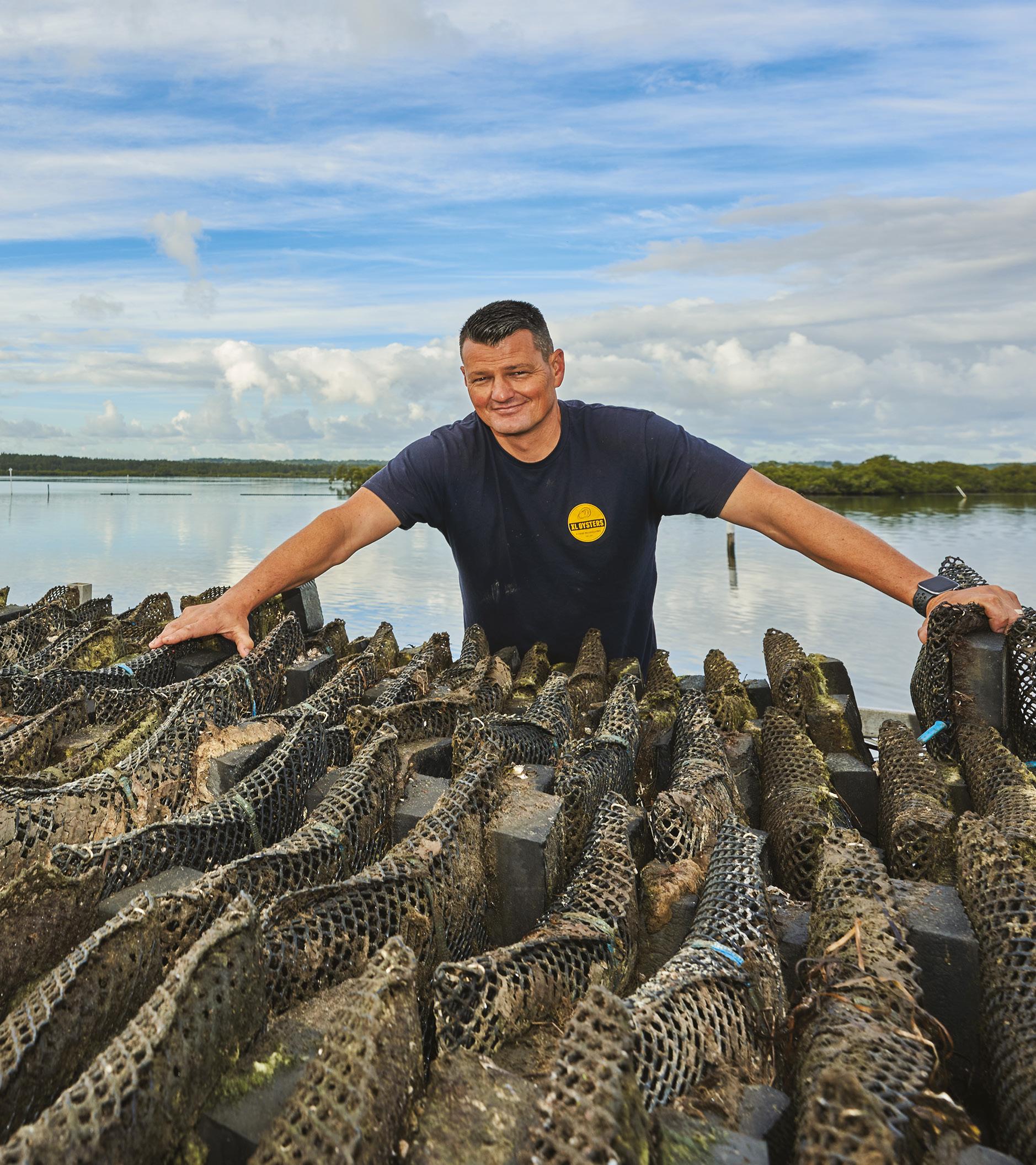
MAY - JUNE 2023 THE FARMER 27
Pacific oysters are resistant to QX, but they are susceptible to Pacific Oyster Mortality Syndrome (POMS) – a disease that has not been detected in Port Stephens’ estuaries�
“We believe the QX parasite outbreak in 2021 and 2022 was related to flooding and that fresh water hung around for so long, causing the oysters to have weak enough immune systems for the parasite to attack,” Matt explains
“On the back of that outbreak, we needed the Pacific oysters to come through as a win for us The industry was down to around 10 per cent of normal production by September last year�


“A lot of farmers had to get off-farm employment and were working a hybrid in the hope they could revive their oyster farming businesses ”
Matt said it was a risk given farmers had experienced the unexplained mortality event with Pacific oysters in 2013
“Spat from wild caught Pacific oysters has been performing much better since then, and with predictions of a cooler summer, we thought there would be a chance of getting a good crop through�”

Matt said he and other farmers were inspired by “unbelievable” growth rates from ‘teenage’ spat bought in from Tasmania
“We went away for Christmas thinking the
oysters are looking fantastic and we would get some income back in
“One farmer then said he started to see some mortality and it just snowballed from there with baskets of empty shells turning up everywhere�
“A lot of us were growing diploid Pacific oysters because they are the most robust against POMS Most of those did not survive, with some farms experiencing 100 per cent mortality
“We also had some triploids as well to split the risk, which seem to have fared better with survival rates of 30 and 40 per cent�”
DIVING INTO THE INVESTIGATION
NSW DPI Fisheries and University of Technology
Sydney (UTS) researchers have been hot on the trail investigating the cause Some farmers are pointing the finger at warmer water temperatures, while UTS research has discovered an unusual bacterium in some oysters
“The jury is still out,” said UTS Senior Research Fellow Penelope Ajani� “There is nothing out of the ordinary that we have found, except for some bacteria that was noted in the oysters�”
Penelope says bacteria was also found during water testing, but it cannot be blamed yet as the cause of the mortality
> THE BIG PICTURE
MYSTERY OUTBREAK Clockwise from left: NSW Farmers Hatchery Support officer Todd Graham; Matt Burgoyne and team; Richmond River Sydney Rock oyster spat.
“A lot of farmers had to get off-farm employment and were working a hybrid in the hope they could revive their oyster farming businesses.”
THE FARMER MAY - JUNE 2023 28
–MATT BURGOYNE Oyster farmer
Telstra
collaborating to help farmers stay efficient with smart water solutions
Farmbot is an Australian Agritech company that helps farmers manage their water assets through remote monitoring and control of water tanks, troughs, pipelines, rainfall and pumps.
Increased water efficiency using remote monitoring solutions takes out the need to manually travel to check water systems, making farmers more efficient and allowing them to use valuable saved time on other important jobs.
Customer profile:
Shandun, a mixed sheep and cropping operation south of Forbes in NSW, illustrates the benefits of Farmbot’s remote monitoring solutions. They use a mix of Water Level Monitors, Rain Gauges and Line Pressure Sensors to ensure its extensive water infrastructure is running efficiently.

With the climate getting hotter and dryer the security of stock and domestic water was becoming more and ore essential for Lindsay Baker. Manual water inspections were taking too long to identify faults, increasing concern around the availability of water for livestock.
“If there was a fault in the system it was taking too long to identify, which was running into the risk of livestock without water. We needed to know on a real-time basis how the water was working.”
Through researching and employing Farmbot technologies, Lindsay can now quickly identify faults in the mainline, with near real-time alerts and up to the minute data captured on MyFarmbot they are reducing the risk of large-scale leaks and increasing the properties water security.

Achieving cost-effective solutions:
With 65% of Farmbot customers using at least one 4G monitor that runs on the Telstra network, Farmbot is currently testing their devices on Telstra’s NB-IoT network which covers almost 95% of the NSW land mass allowing for more cost-effective solutions into the future.
Telstra is an investor and strategic shareholder of Farmbot. Along with its services that enable Farmbot to deliver its remote monitoring solutions, Telstra is well placed to support Farmbot as it continues to provide
cost-effective products for Australian farms to become more productive, efficient and environmentally friendly.
For more information on Farmbot
02 9030 4760
sales@farmbot.com.au
farmbot.com.au
and Farmbot are
information
More
“We are not sure whether the bacteria came in as a result of the oyster dying or whether it was already present, so we will be running some tests on the bacteria�”
STICKING WITH PACIFICS
Matt said they have not given up growing Pacific oysters and will test fattening older spat during windows of low mortality risk and lower water temperatures�
“Right now in Port Stephens, it’s a challenging business model to grow a Pacific or Sydney rock oyster from spat right through�
“We are hoping that the Richmond River oyster will be that new longer term business model for Sydney Rock production
“In the meantime, we were looking at window farming Pacific oysters when the risk of infection or mortality is low� That means bringing in spat that is 20 millimetres in size and around four months and having oysters all gone and sold by December�”
The triploid Pacific oyster spat was being sourced from hatcheries in Tasmania via oyster nurseries in eastern states, but Matt said that spat has also suffered high mystery mortality rates
“We had ordered 1 5 million oysters, but virtually all of them have died Luckily, we were able to source some other Pacific spat, but it is only 2mm in size and the opportunity for window farming is shut this year�”
Karuah oyster farmer Dean Cole started restocking his farm with two million baby spat sourced directly from Tasmania in late April
“We are hoping for the right Sydney rock oyster to come along, but we need to generate some income in the interim with Pacific oysters,” Dean said
Dean and brother Stephen run the family business Cole Bros Oysters, which was hit by a mortality rate of 95 per cent in its diploid Pacific oyster stocks� The QX outbreak in 2021 had already led to the closure of their popular Cole Bros Oysters shop in Karuah�
“Around 200,000 of the triploid Pacific oysters survived though, and we were able to sell some oysters this year
“Triploids are our best bet in the short term, particularly as more oysters with stronger POMS resistance become available�”
A naturally occurring QX-resistant oyster from the Richmond River could be a game-changer for the NSW oyster industry. The challenge now is to breed up mass amounts of spat.
The future of the Coles Bros Oysters shop is uncertain, but like Matt, Dean is resolute about reviving the family oyster business with the help of NSW Farmers Oyster Project officer Andy Myers and Hatchery Stock Support officer Todd Graham
“We have to focus on being farmers and not retailers as well, for the next 12 months Having the support of NSW Farmers, the oyster committee and people like Andy and Todd are allowing us to do that�
“We can’t walk away from this business� For a start, it would cost us around $300,000 to remove all the infrastructure, but it is mainly because the staff are all family, and we have the next generation keen to keep it going ”
COULD RICHMOND RIVER OYSTERS BE THE SYDNEY ROCK SAVIOUR?
A naturally occurring oyster from the Richmond River could be a game-changer for the NSW oyster industry, according to NSW Farmers Hatchery Stock Support officer Todd Graham�
Todd’s role is to work with farmers, hatcheries, nurseries and the NSW DPI to improve access to spat across the supply chain That includes facilitating the collective purchase of spat for small and medium sized oyster farms
“Oyster farmers right across the north coast are on the hunt for spat after flooding and disease impacts� Similarly, parts of the south coast are still in recovery mode too after floods and fires,” Todd says�
Todd is also an oyster farmer and is trialling the Richmond River oyster on the Macleay River, which has also been affected by QX disease
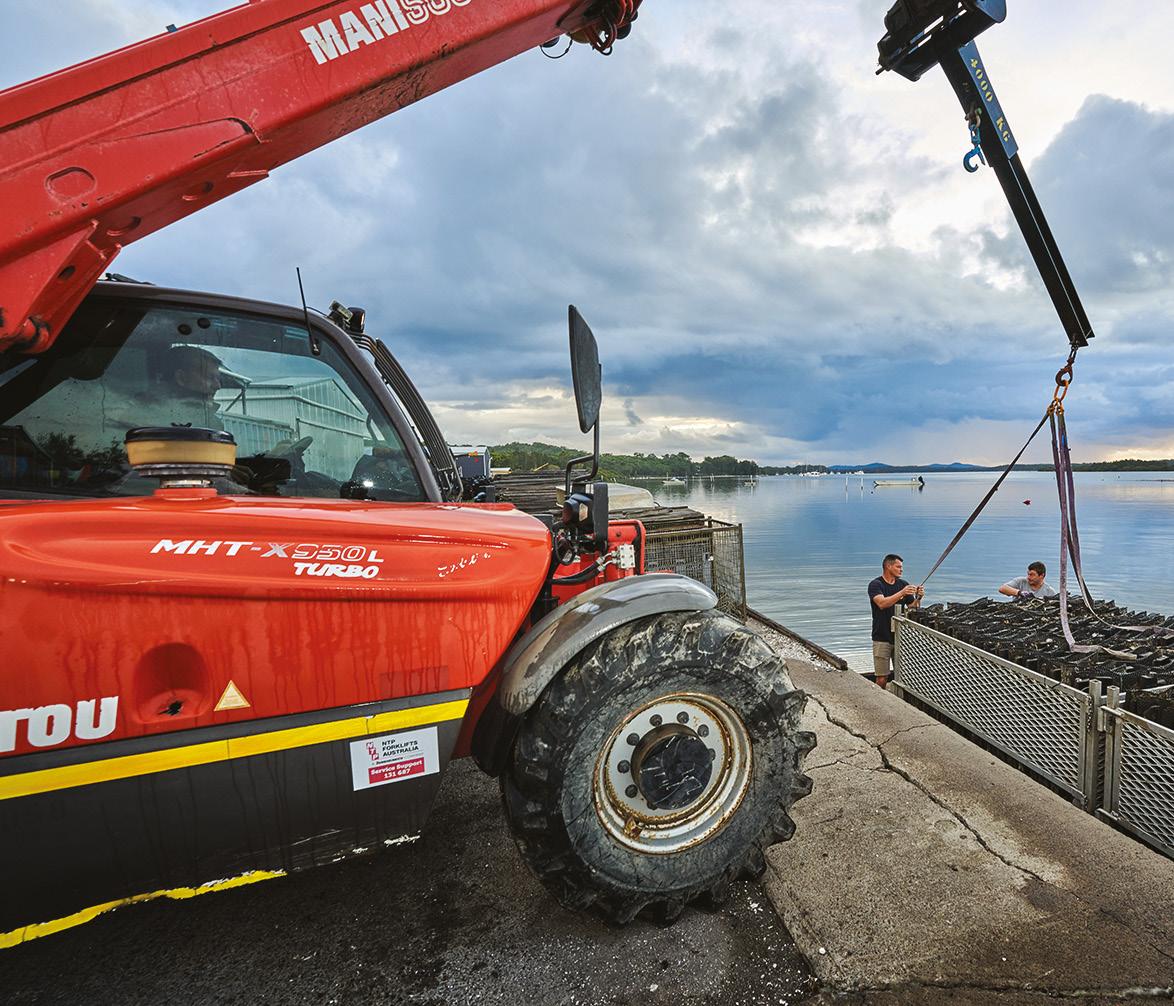
THE BIG PICTURE
“Oyster farmers right across the north coast are on the hunt for spat after flooding and disease impacts. Similarly, parts of the south coast are still in recovery mode too after floods and fires.”
–
TODD GRAHAM
NSW Farmers Hatchery Stock Support officer
SALTY SAVIOUR
THE FARMER MAY - JUNE 2023 30
“The Richmond River oyster family lines have a lot of oyster farmers excited It’s a naturally occurring QX-resistant oyster,” he says� “They also seem to perform well in poorer water quality conditions�



“All the wild caught oysters had disappeared from the Richmond River, then an oyster farmer found them again about five years ago ”
The challenge for the industry now is to breed up mass amounts of spat Attempts this year to fast track commercial production of spat for farmers in NSW have failed “The hatchery managers are on a learning curve with the Richmond River oysters� They seem to prefer cooler temperatures at the hatchery stage than other Sydney Rock oysters�”
Matt, who is chair of the NSW Farmers Port Stephens Oyster branch, and Cole Brothers Oysters are also trialling the QX resilience of the Richmond River rock oyster and early results are promising

LOOKING FORWARD
Oyster farming has been in Matt’s family for 67 years, and he, like Dean and Stephen from Cole Bros Oysters, is keen to keep it going with the support of NSW Farmers.
“Todd gave us some spat that we put in just after Christmas, so we are right in the middle of our QX infection period,” Matt says�
“They are performing well� We are also going to try a QX-resistant oyster developed by the DPI in May that will already be 15 months old� We will see how they go through an infection period and get them in condition for sale in 2024
“It’s a long play to sustain our family business –if we have oysters that survive, we can rebuild our business It’s something we want to do, as for us personally, we love farming oysters and it’s been in our family for 67 years�”
Footnote: The NSW Farmers Hatchery Stock Support officer role is funded through The Early Needs Recovery Program, which is part of the $150 million Primary Industry Support Package co-funded by the Australian and NSW Governments. l
MAY - JUNE 2023 THE FARMER 31

WFI are good people to know for insurance. As we head into June 30, it’s very timely to check your insurance to ensure you have adequate cover for any new machinery or property you’ve purchased, and to protect your existing assets. Contact NSW Farmers on (02) 9478 1042 or www.nswfarmers.org.au/wfi to find out more
The team at WFI understands that every farm is different, and that it’s important to have a range of different covers when choosing insurance. WFI’s Rural Plan offers an all-in-one policy for your domestic, farming and commercial needs.
Below we have listed some of the options available, but talk to us, and we can ensure you’re up to speed on any partnership benefits that may be applicable to you. Did you know, WFI and NSWF offer a membership rebate off next years NSWF Membership fees?

• Farm Property Damage has 15 additional benefits, with the option to increase the insured values on some of these benefits. These include – but are not limited to – costs to produce a written farm business plan, costs to safeguard property from the threat of fire, clearing of debris, fees incurred in connection with a tax audit.
• Farm General Property allows you to insure various items of property against accidental loss or damage, and theft. Items may be things such as augers, tools and farm produce.
• Legal Liability is an often-overlooked cover that is essential to any farming operation, and it has varying levels of indemnity for you to choose from.
• Farm Burglary and Theft has eight additional benefits, some of which extend to Burglary and Theft of employee’s tools, and equipment and property temporarily removed from the farm.

Plus many more options to cover you, your farm and assets this end of financial year and beyond.
Why choose WFI?
• Leading farm insurer with over 100 years of experience.
• Over 80 Area Managers across Australia.
• Flexible insurance options.
• Deal directly with an Area Manager who lives in, and understands your community.
• NSW Farmers members have access to a Rebate off their NSW Farmers Membership fees.

• Choose to deal with your WFI Area Manager face-to-face.

Disclaimer: Rebate amount will depend on your insurance policy premium. Insurance issued by Insurance Australia Limited ABN 11 000 016 722 trading as WFI. To see if a product is right for you, always consider the Product Disclosure Statement and Target Market Determinations available from wfi.com.au. If you take out a policy with WFI, NSW Farmers receives a commission from WFI between 5% and 10% of the value of the premium payment (excluding taxes and charges). PROUD PARTNERS
PROUD PARTNERS
The election was won in western Sydney, where there were significant swings towards Labor. But many rural and regional electorates remained out of reach, staying with the Coalition and independents, leaving a question writ large over the bush: What does this election result mean for them?
AS IT HAPPENED
The result was called early on election night with significant swings towards Labor in key seats across western Sydney. Initial projections had Labor forming a majority government, but, after a week of counting, that outcome never came to fruition. From one minority government to another, independents and minor party crossbenchers would continue to influence the state’s direction.
CROSSBENCHERS ARE KEY
The Greens maintained their lower house presence by retaining the seats of Balmain, Newtown, and Ballina, while the number of independents grew from three to eight. However, this total included three former members of the Shooters, Fishers and Farmers Party (SFF), Helen Dalton, Roy Butler, and Phil Donato, as well as former Liberal Gareth Ward – all of whom became independents after 2019 and retained their seats in this year’s election.
In a noteworthy trend, all rural independents gained supporters since 2019. Roy Butler had a 9.4 per cent swing in Barwon, Helen Dalton had a 13.2 per cent swing in Murray, and Phil Donato had a 6.7 per cent swing in Orange, while popular independents Greg Piper and Dr Joe McGirr had dominant wins in their respective seats.
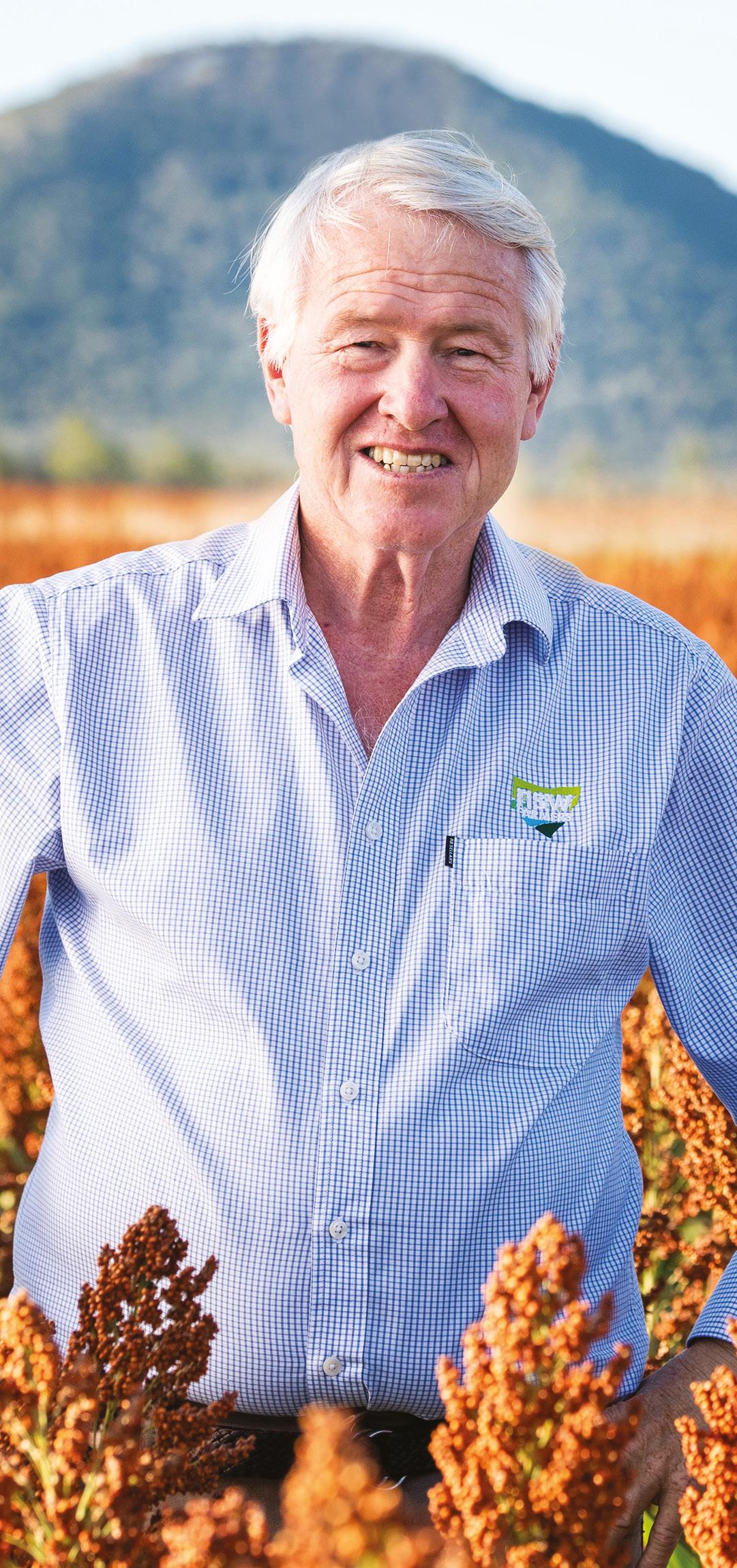
The so-called “teal wave” that came to define the 2022 federal election was not prominent in this election. There was only one teal win; Judy Hannan in Wollondilly, where the Climate 200-backed candidate was successful over Liberal Nathaniel Smith.
WHERE DO THE INDEPENDENTS STAND?
To swear in an interim ministry, Chris Minns obtained confidence and supply from the three longest serving lower house independents: Sydney’s Alex Greenwich, Wagga Wagga’s Dr Joe McGirr, and Lake Macquarie’s Greg Piper. These independents have indicated their intention to form a bloc on several issues, including gambling reform, some environmental issues, and government integrity. For Roy Butler and Phil Donato, regional health and infrastructure were priority areas, while Helen Dalton had a key policy to scrap floodplain harvesting regulation. >
THE BIG ISSUE ELECTION
THE FARMER MAY - JUNE 2023 34
STRONG OUTCOMES
NSW Farmers president Xavier Martin (pictured) is looking forward to working with the new Labor government to secure strong outcomes for agriculture and regional NSW.

A vote for change as NSW ushers in new era
New South Wales is the final mainland state to shift to a Labor government, after the Liberal-National Coalition’s 12-year run was ended on March 25. With a significant swing to Labor, minor parties making gains in the upper house, and independents reinforcing their popularity in regional electorates, the verdict is in – people have voted for change.
–
Word s EMILY SIMPSON Photography RACHAEL LENEHAN
MAY - JUNE 2023 THE FARMER 35
WHAT ABOUT THE UPPER HOUSE?
Minor parties have continued to expand their imprint on the upper house. The Liberal Democrats and Legalise Cannabis Party both gained places in the Legislative Council, building on the success of minor parties such as Pauline Hanson’s One Nation, the Greens, the Shooters, Fishers and Farmers, and the Animal Justice Party in the 2019 and 2015 state elections. But despite the diversity of parties in the upper house, progressive and conservative representation was split evenly with the result.
WHERE DOES LABOR STAND ON AGRICULTURE AND REGIONAL NSW?
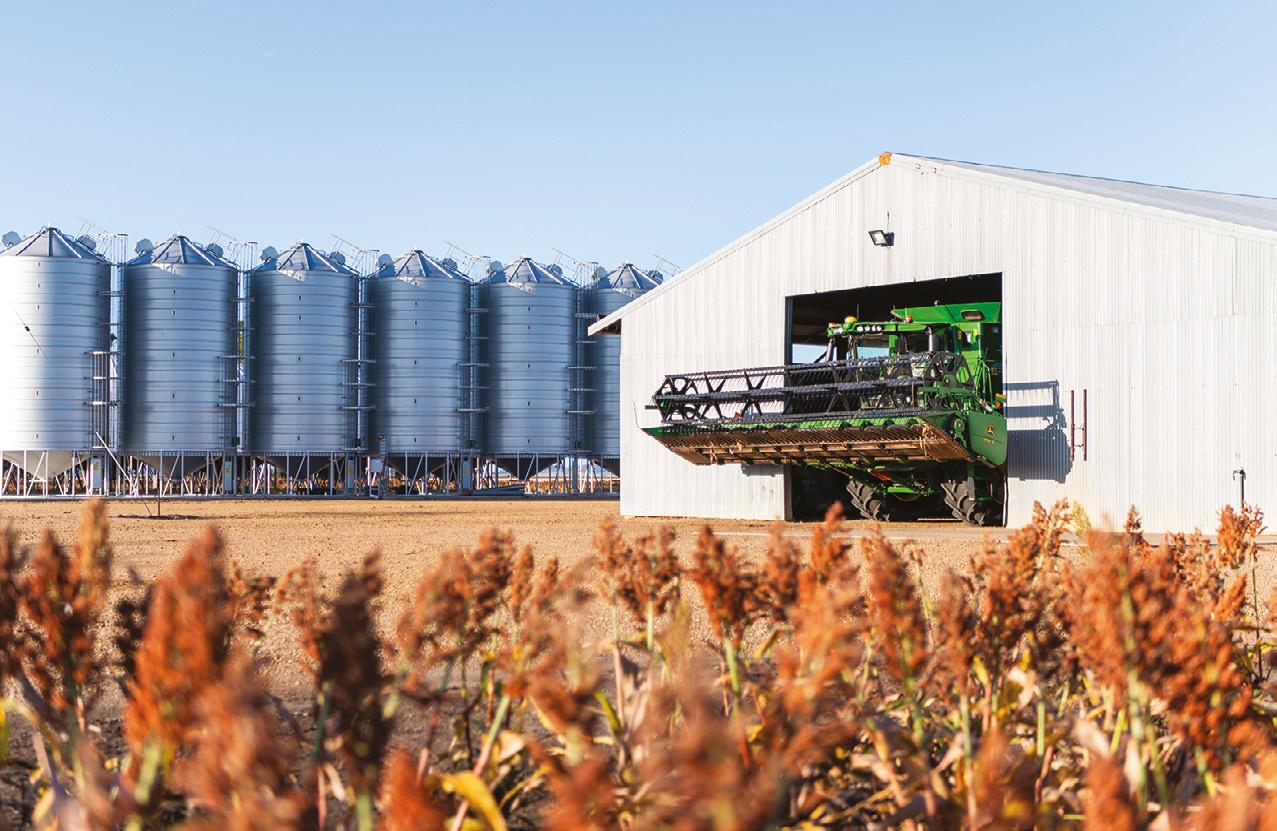
Prior to the election, NSW Farmers developed a fivepoint priority plan for the next state government. The Feeding the Future: A stronger outlook for farmers and the state document identified road and rail infrastructure, biosecurity, farm productivity, workforce, and land use pressures as areas the incoming government should focus on to build a sustainable agriculture sector.
A NEW ERA
Above: NSW Farmers President and grain farmer Xavier Martin and his wife Heather on their property near Mullaley. With Labor now in power in NSW, it is necessary for the state government to focus on building a sustainable agriculture sector.
The industry group also ran a Regional Debate series, which focused on the areas of environment, water, regional NSW, infrastructure, agriculture, land use and energy to explore the positions of the major and minor parties ahead of polling day.
Labor made several election commitments to agriculture and regional communities, including an independent Agriculture Commissioner. NSW Farmers chief president Xavier Martin said that while NSW Farmers was successful in securing an Agriculture Commissioner after the 2019 election, the group continued to call for the role to be truly independent to give agriculture perennial representation in government.
“The Agriculture Commission has a key role around land use planning, with renewable energy infrastructure going up across the state and potentially endangering the future use of productive land,” Xavier said.
The past year was plagued by biosecurity scares, with the detection of foot and mouth disease in holiday hotspots such as Bali topping the list for most farmers. Labor made several headline commitments to biosecurity, including a legislated and independent Biosecurity Commissioner.
Looking closer to home, an uptick in pests and weeds following three consecutive La Niña events spurred Labor to commit to a Good Neighbour Program for landholders adjoining public land, as well as 100 additional staff for the National Parks and Wildlife Service.

According to Xavier, NSW Farmers had urged the establishment of an independent Natural Resource Regulator to tackle growing numbers of feral pigs and deer, and outbreaks of weeds such as Hudson pear.
“The regulator would enforce the required management of public land such as National Parks and Crown lands, which over recent years has been dismally low,” he said.
“With more of the state being turned into National Parks, it is critical these public tracts of land are appropriately managed.”
THE BIG ISSUE ELECTION
“The Agriculture Commissioner has a key role around land use planning, with renewable energy infrastructure going up across the state and potentially endangering the future use of productive land.”
–
XAVIER MARTIN
NSW Farmers president
> THE FARMER MAY - JUNE 2023 36
STRATEGIC N TO BOOST FEED GROWTH
are still an economic way to produce additional feed.
WHICH PRODUCT?
Urea 46% N w/w
Urea is the most widely used high analysis granular nitrogen fertiliser. However, spring applications are prone to ammonia loss through volatilisation. Green Urea NV® 46% N w/w
Green Urea NV is granular urea coated with the urease inhibitor NBPT (N-(nButyl)-thiophosphoric triamide) and can reduce potential volatilisation loss by 70%.
EASY N® 42.5% w/v
After a wet harvest, low reserves of quality stored fodder and expensive hay prices, livestock producers are considering applying nitrogen to boost pasture growth.
Strategic applications of nitrogen to manage feed deficits are more efficient than a fixed rate of nitrogen. Before applying nitrogen there are some things to consider:
◆ Is the pasture actively growing?
◆ Can excess growth be conserved as hay or silage?
◆ Are there other nutrients or soil constraints that will limit pasture growth?
◆ What is the return from the additional feed grown?
Economics of N Application
Returns on nitrogen investment are influenced by moisture, pasture composition, soil fertility, grazing management, application rate and fertiliser product.
Trials results from Boorowa in 2022 showed applications of both 60 and 90 kg/ha nitrogen produced more dry matter than the control. But an early spring application of Green Urea NV®, at both 60 and 90 kg/ha of nitrogen, produced significantly more dry matter than urea.
When the cost per tonne of dry matter was calculated (Table 1), even at $700+ per tonne, urea and Green Urea NV
Easy N® is a high analysis liquid fertiliser present as urea ammonium nitrate (urea 50%, 25% ammonium, and 25% nitrate-nitrogen). The presence of nitrate-nitrogen means a faster response on cold soils. It can be applied by fertigation or surface application.
Timing and application rates
Pastures are most nitrogen deficient from late autumn to early spring when less nitrogen is being mineralised by the soil. Strategic applications in late autumn, before soil temperatures fall can provide additional winter feed.

The best dry matter response is generally to applications of between 25 and 50 kg N/ha. In this range, dry matter will accumulate as nitrogen rate increases. Beyond 50 kg N/ha, a positive economic outcome is more unlikely.
FURTHER INFORMATION
For more information or advice about boosting spring pasture growth, feel free to contact me on 0475 439 316 or clint.sheather@incitecpivot.com.au.

ADVERTORIAL
LATE AUTUMN EARLY SPRING ($/tonne DM) ($/tonne DM) 60kg/ha of N (Urea) $154 $41 90kg/ha of N (Urea) $177 $47 60kg/ha of N (Green Urea) $144 $46 90kg/ha of N (Green Urea) $133 $38
IPF Technical Agronomist, Clint Sheather.
Table 1: Cost per tonne of dry matter based on a urea cost of $700/t and Green Urea NV cost of $740/t.
MAY - JUNE 2023 THE FARMER 37
Flooding and ongoing wet weather conditions have driven many regional roads into ruin, and NSW Farmers called for a billion-dollar commitment to the repair and betterment of these roads. Labor committed to a $670 million Emergency Road Repair Fund, as well as an additional $390 million to the former government’s regional pothole fund.
Xavier said the funding commitments to regional roads were pleasing, but uncertainty around major infrastructure projects such as the Great Western Highway upgrade would cause concern among some NSW Farmers members.
Xavier also said it was unclear how Labor planned to fund innovation for the farming sector, and whether the new government had a clear workforce strategy.
“The Farm Innovation Fund and the Seafood Innovation Fund have been key resilience tools for farmers, and while Labor has committed to continuing the former there’s no dollar figure on it,” he said.

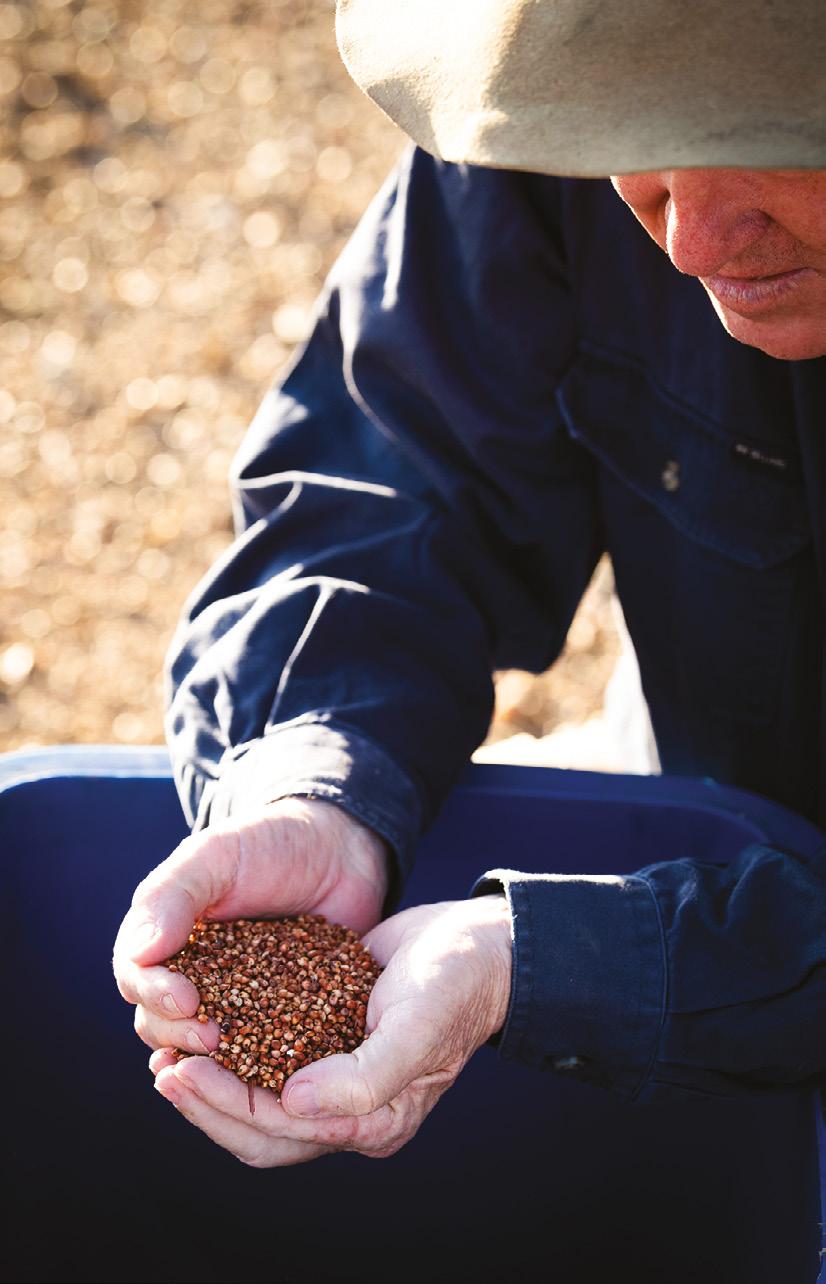

RURAL ISSUES
Xavier Martin, President of NSW Farmers, said he looked forward to working with Labor’s new Cabinet to secure stronger outcomes for agriculture and regional NSW, focusing on funding for infrastructure and innovation projects.
On the workforce issue, Xavier said farmers had been facing challenges for years and the government needed to have a strong plan to tackle it.
“Labor has earmarked a workforce roundtable in the first 100 days of government, but we already know what the problem is – now, we just need action and a clear plan,” he said.
“We also need to work from the ground up, starting with how agriculture is taught in the classroom.”
NEW CABINET
On Tuesday April 4, 2023, Chris Minns announced his new Ministry. Queanbeyan local the Hon. Tara Moriarty MLC was named Minister for Agriculture, Regional NSW and Western NSW. The Hon. Penny Sharpe MLC was given the portfolios of Energy and Climate Change, Environment and Heritage, and was made Leader of the Government in the Legislative Council. The Hon. Rose Jackson MLC was made Minister for Water, and the Hon. Jenny Aitchison MP Minister for Regional Transport and Roads.
Pete said he looked forward to working with the new Cabinet to secure strong outcomes for agriculture and regional NSW.
“Several ministers would be continuing their work from the shadow cabinet, and NSW Farmers has established relationships with many of them through their work in opposition,” he said.
“Our members heard from Penny Sharpe, Rose Jackson, Jenny Aitchison, and Jihad Dib during our Regional Debate series, and we look forward to working with them now as ministers.” l
THE BIG ISSUE ELECTION
THE FARMER MAY - JUNE 2023 38








Local Land Services
Competition not going with the grain
NSW Farmers has set its sights on improving competition and transparency in the supply chain for grain farmers. –
Words MICHAEL BURT
RISING COSTS
More than 80 per cent of respondents to a recent Grain Producers Australia survey said last year’s cropping production costs were ‘significantly higher’ compared with previous years.

THE FARMER MAY - JUNE 2023 40
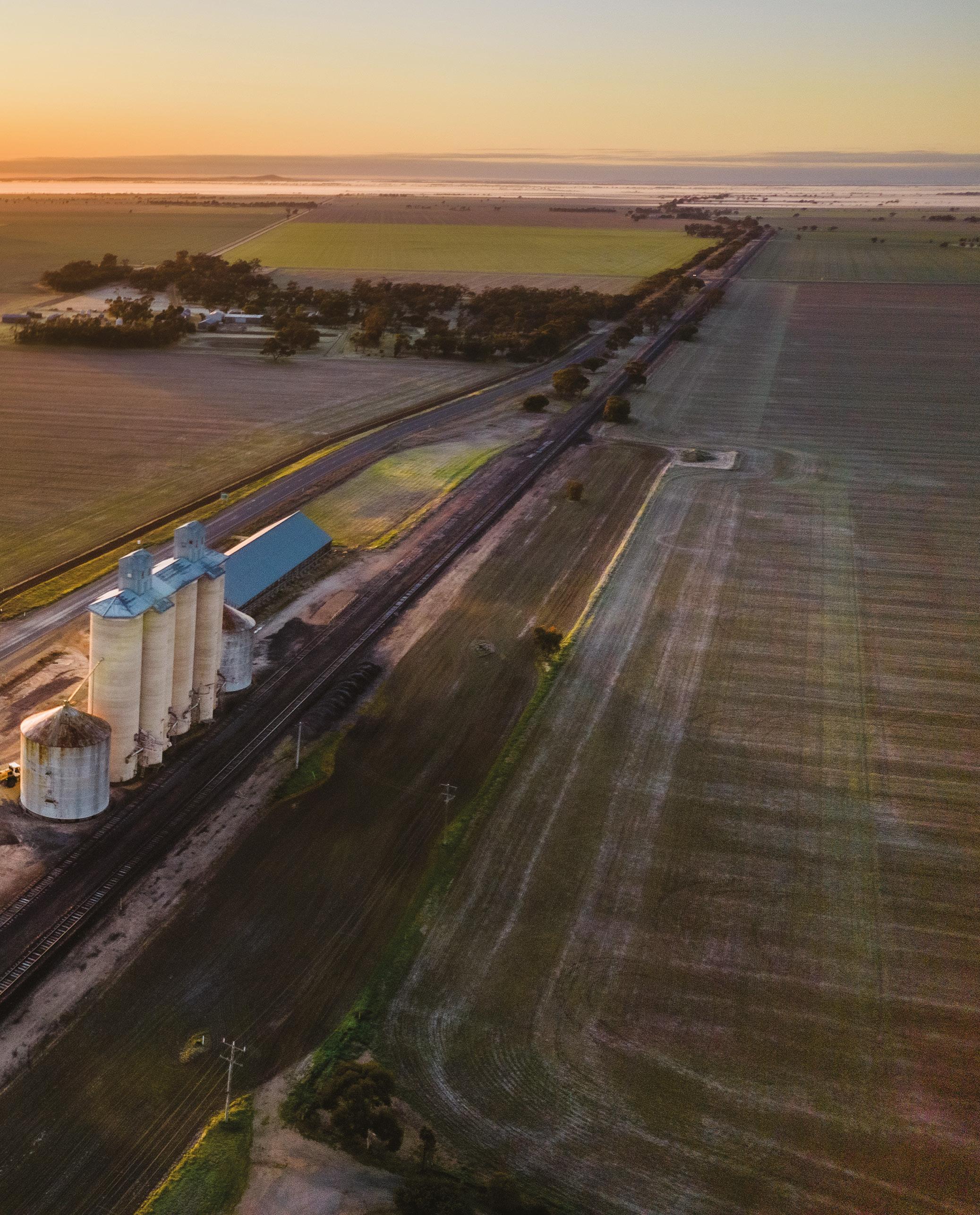
TRADE GRAINS MAY - JUNE 2023 THE FARMER 41
Australian grain farmers have produced an estimated 39.2 million tonnes (Mt) of wheat, 14.1Mt of barley and 8.3Mt of canola from the 2022-23 winter-crop harvest.

It’s a record amount of grain to sell, and farmers will need top prices to recoup a record investment into growing the crops. More than 80 per cent of respondents to a recent Grain Producers Australia survey said last year’s cropping production costs were ‘significantly higher’ compared with previous years.
NSW Farmers Grains Committee Chair, Justin Everitt, said growers are receiving higher prices for wheat compared to last year, but reports of farmers in other countries getting more bang for their buck continue to frustrate Australian farmers in 2023.
“We have been seeing international prices way above what we have been receiving. Canadian farmers were getting up to $150 per tonne more for canola last year,” Justin says.
“We have had some of the lowest prices in the world for the past two years for canola and wheat. Some of that is due to supply and demand and climatic factors, but there is definitely room for improvement in the efficiency of the supply chain in Australia.
“I know, for example, that they haul 15,000 tonne trains across Canada compared to the 5,000 tonne capacity trains here.”
Expansion of container grain exports at the Port of Newcastle and the Inland Rail project are tipped to improve the shifting of grain to market for farmers in NSW, but Justin said more work is needed to increase transparency across the supply chain.
“We need to work out where all the congestion is coming from in getting it from storage to port.”
INQUIRIES INTO THE INDUSTRY
NSW Farmers has asked Federal Treasurer Jim Chalmers to establish two inquiries to enable critical supply chain efficiency improvements and increased transparency for the grains sector.
The first is an in-depth ACCC inquiry into the Australian grains industry to address concerns raised by growers about the under-pricing of Australian grain when compared to those in other grain producing countries.
NSW Farmers economist Brendan O’Keeffe said there are market failures potentially occurring across the supply chain due to a lack of competition, but a lack of data exists to fully diagnose the extent of inefficiencies.
TRADE GRAINS
THE FARMER MAY - JUNE 2023 42
NO PAIN, NO GRAIN
Clockwise from top left: Canola fields; Grain being loaded onto ships in port; Trains transport up to 5,000 tonnes of grain in Australia compared to 15,000 tonnes in Canada.

“Monopolistic behaviour is potentially occurring due to large barriers to entry at the bulk handling stage, such as the high cost of rail access and significant capital investment required to set up facilities,” Brendan says.
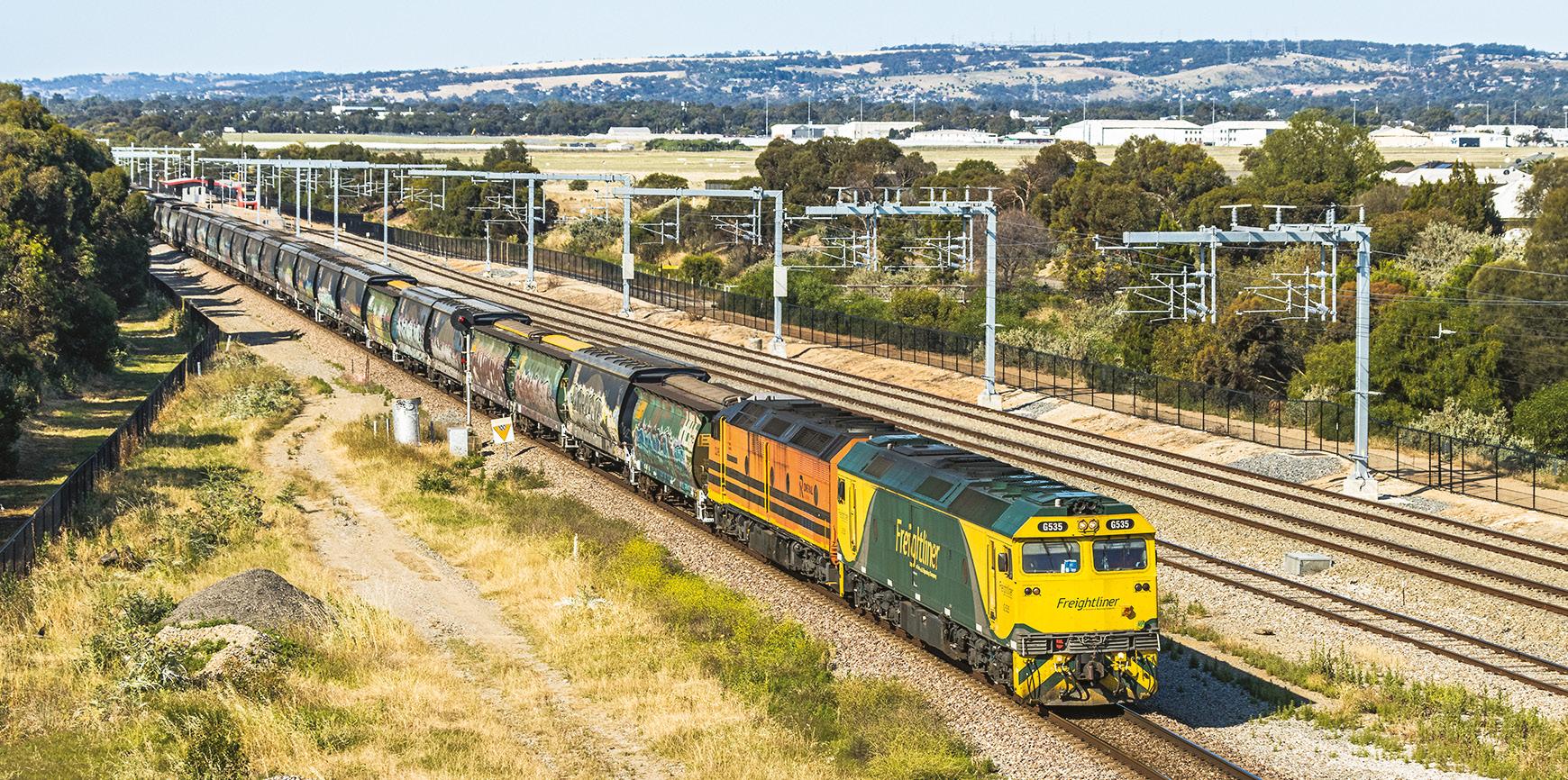
“Other issues leading to market inefficiencies include a lack of supply chain coordination, insufficient cost recovery of rail, and underinvestment in road infrastructure.”
Brendan said the ACCC should use their powers to compel businesses across the supply chain to provide cost and revenue data which would then show markups and therefore evidence of monopoly pricing.
“This could validate growers’ concerns that they are receiving prices lower than they would in an efficient market setting.”
CHECK OUT OUR WHEAT PORT CODE
In addition to the ACCC Inquiry, NSW Farmers has requested that a review of the Wheat Port Code be commenced at the same time.
The Wheat Port Code regulates the conduct of port terminal service providers and seeks to ensure that exporters of bulk wheat have fair and transparent access to port terminal services.
In May 2018, the ACCC’s submission to the
previous Port Code Review identified that exporters of all bulk grains should have fair and transparent access to port terminal services.
The ACCC also recommended that the code be extended to apply baseline regulatory access arrangements to vertically integrated upcountry storage and handling networks.
Recommendations like these from the first Code review have not been implemented, and the ACCC said in September last year that “the second Code review should commence as soon as practicable within the next 12 months”.
The ACCC has reported on bulk grain exports every year since the monopoly powers of the Australian Wheat Board (AWB) were removed in 2008.
The latest report showed a decline in the average number of exporters per port, while at the same time there is a growing number of new and smaller port facilities.
“While outside the remit of the Code, the ACCC notes that stakeholders continue to express concern around broader supply chains,” the ACCC said in a statement.
“The ACCC has reflected these concerns in its Bulk Grain Ports monitoring reports for several years.

>
MAY - JUNE 2023 THE FARMER 43
PORT EXPANSION
Expansion of container grain exports at the Port of Newcastle (top) and the Inland Rail Project are tipped to improve the shifting of grain to market for farmers in NSW, however more work is needed to increase transparency across the supply chain.

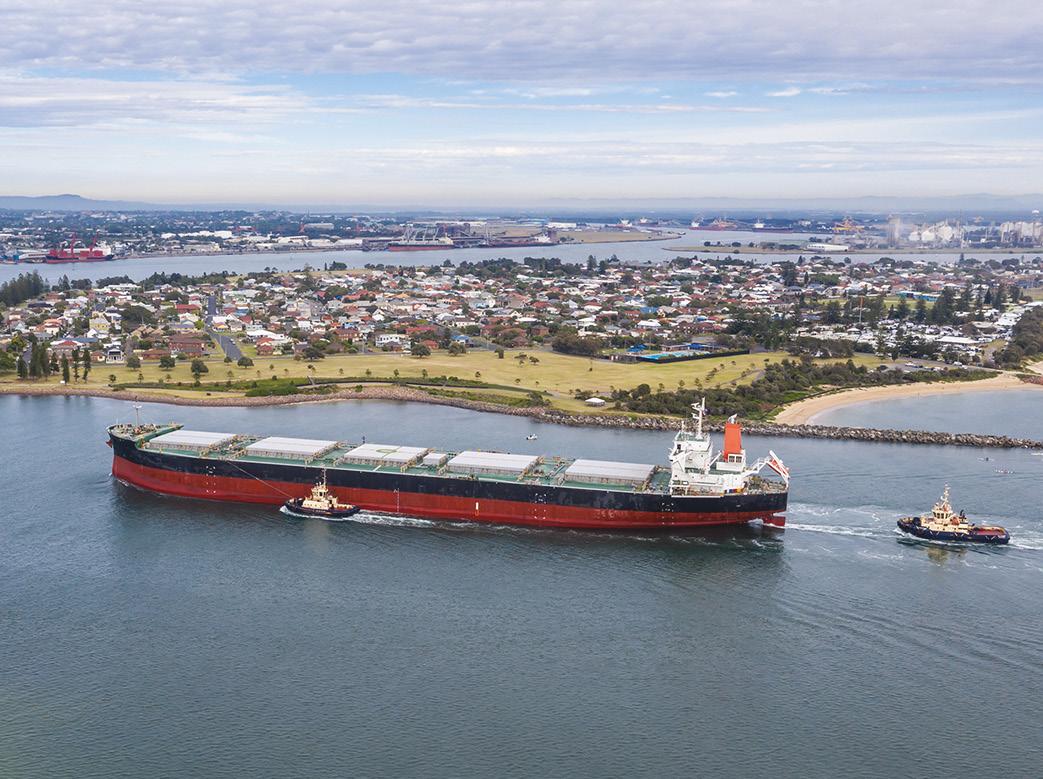
The ACCC considers that long-held stakeholder concerns, such as those in relation to broader supply chain issues, as well as emerging concerns should be considered as part of the second Code review.”
GRAINGROWERS CALL FOR INVESTIGATION
Research that estimates grain growers lost $2.6 billion in the value of their wheat in the 2021-22 marketing season has sprouted more calls for action on transparency in grain pricing.
GrainGrowers has requested a ‘in-depth investigation’ from the Australian Government in response to its research paper highlighting large pricing anomalies between Australian and international grain markets.
“Our research highlighted enormous anomalies
accepted by grain and oilseed growers in the winter cropping cycle for 2021-22,” said GrainGrowers CEO Shona Gawel.
“At face value, in wheat alone, the value loss to grain growers is approximately $2.6 billion. The enormity of this loss is not sustainable over the longer term should the issue re-surface, as it seriously impacts overall farm viability.
“Growers have been raising the issue for some time, and the report provides quantitative evidence supporting the need for government to perform an in-depth investigation.”
GrainGrowers has outlined a range of options for the government to consider, including backing the request from NSW Farmers for an ACCC pricing inquiry. Other options are a Senate Inquiry and independent review or a departmental review by the Department of Agriculture, Fisheries and Forestry.
“Given the issue’s importance, we believe it is appropriate for the government to decide and commence what it considers to be the most appropriate course of action to address the identified concerns.”
Shona said that unless the drivers behind these anomalies are better understood and addressed, they will continue adversely impacting growers and the wider industry.
“To get to the heart of the matter, we believe any investigation should include the end-to-end grains supply chain nationally, originating at farm gate through to export and domestic channels,” she says.
“The investigation is not a finger-pointing exercise at any individual market participants, but rather a much-needed review in the interest of all players in the value chain.
“A thorough investigation will reveal if there are any supply chain bottlenecks and other barriers for trade participants. This approach, in turn, will help inform the government on future nation building supply chain investment, increasing the capacity of industry to export larger grain crops in future.”
TRADE GRAINS
l
“To get to the heart of the matter, we believe any investigation should include the end-toend grains supply chain nationally, originating at farm gate through to export and domestic channels.”
–
THE FARMER MAY - JUNE 2023 44
SHONA GAWEL CEO, GrainGrowers
EXPERT-APPROVED TIPS FOR WATER COMPLIANCE
The most common topics we are asked about at our field days are:
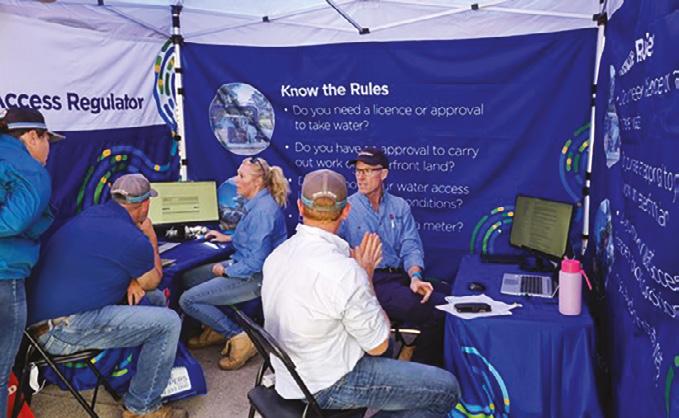
◆ licences & approvals
◆ basic landholder rights
◆ stock and domestic
◆ harvestable rights
◆ flood works and dams
◆ clearing your property after a flood event.
Did you know controlled activities, or works on waterfront land, continue to be the main compliance issue with the Far North Coast region? This offence makes up 46% of all Far North Coast offences since 2019.
The most widespread flooding in decades brings with it a new set of water challenges. Flood works, controlled activities and harvestable rights are an ever-increasing part of our everyday language at the Natural Resources Access Regulator (NRAR).

As the independent water regulator, NRAR enforces the water management laws in NSW. A firm but fair regulator with more eyes in the sky and boots on the ground than ever before. We take an educative and collaborative approach to our water regulation and want to answer
all your compliance questions. That’s why our officers will again be at Primex 2023 and can’t wait to offer visitors friendly advice, information, and tools needed to comply.
NRAR is coming to a field day near you
Find answers to questions you have about metering, basic landholder rights, water access licences, or the conditions of your work approval. Our friendly NRAR officers have the right information and fact sheets and can show you how to use handy e-tools to help you know the rules.
We know the rules around licenses, irrigation, meters, bores, are complex but with knowledge comes clarity. Lean on our water experts to bring calm to your compliance. We can even show you how to access your licence online and help you find answers to specific questions about your property.
NRAR is monitoring your area, so as responsible water users, it’s important you know the rules before we arrive.
Come say hello to us at our Primex 2023 stand or visit our website at nrar.nsw.gov.au for more information.
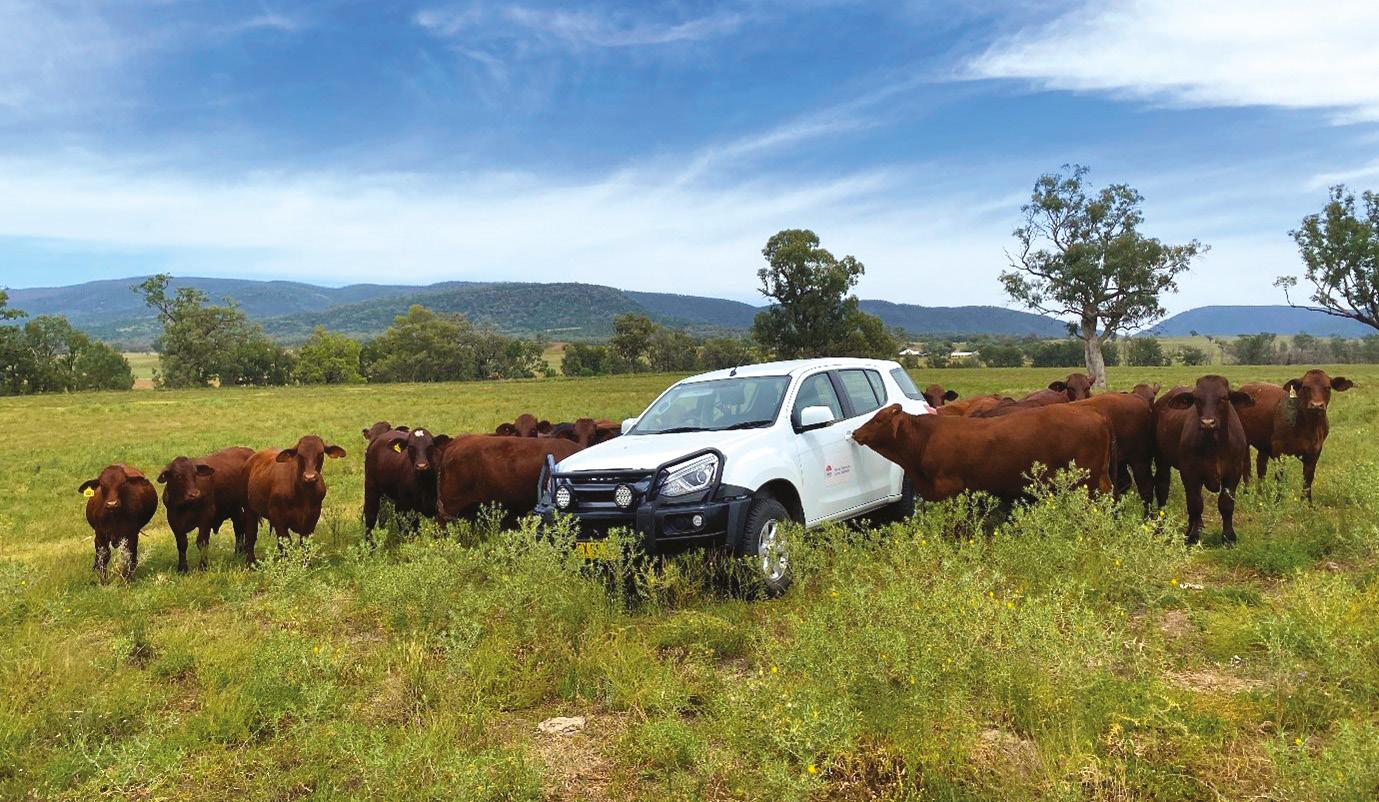
ADVERTORIAL
Natural Resources
Regulator nrar.nsw.gov.au | nrar.enquiries@nrar.nsw.gov.au | 1800 633 362
You can find NRAR at: Primex Field Days in Casino, 11-13 May at site G24b Mudgee Small Farm Field Days, 7-8 July Learn more about NRAR
Access
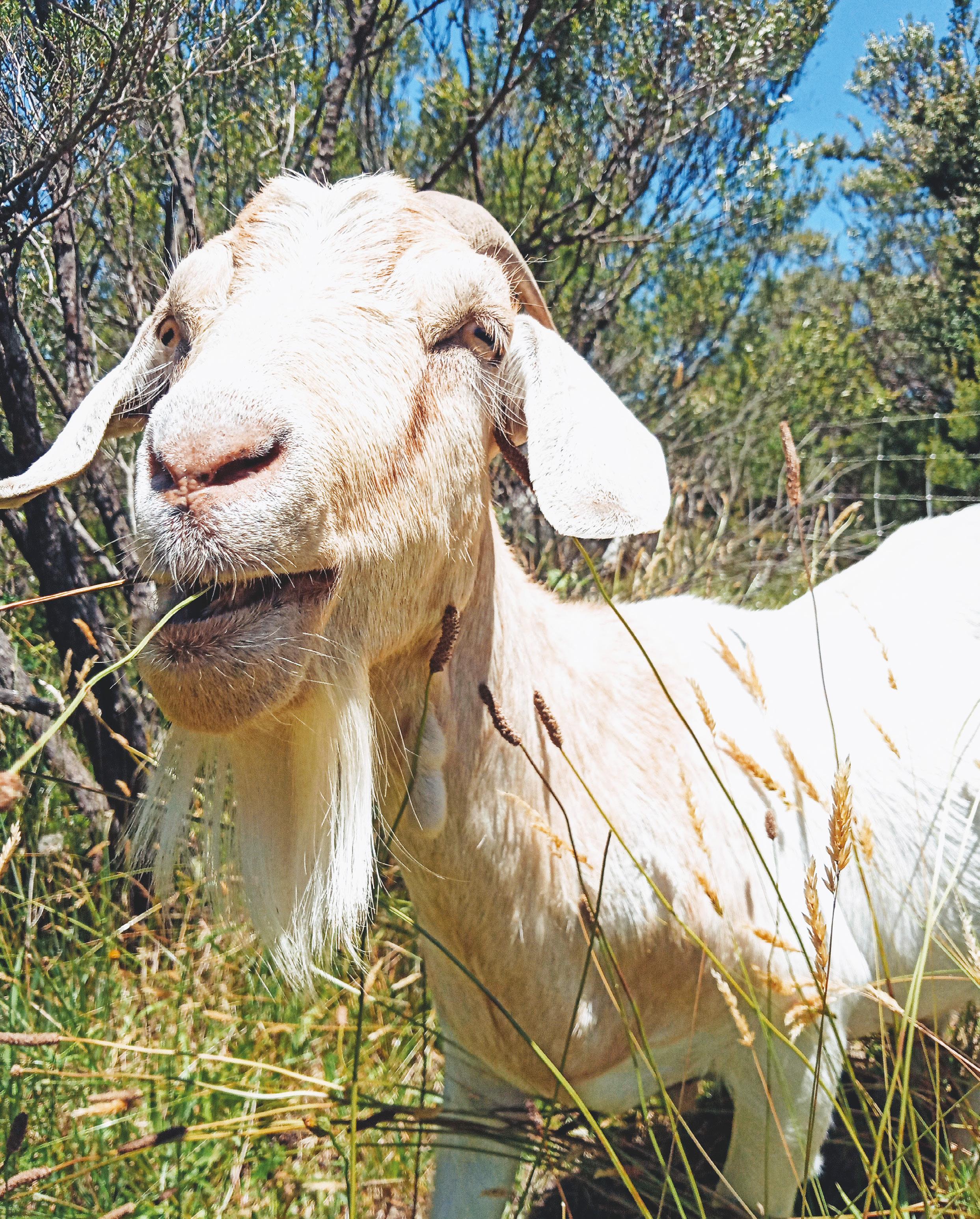
THE FARMER MAY - JUNE 2023 46
NO KIDDING
The goats of Dry Creek Farm
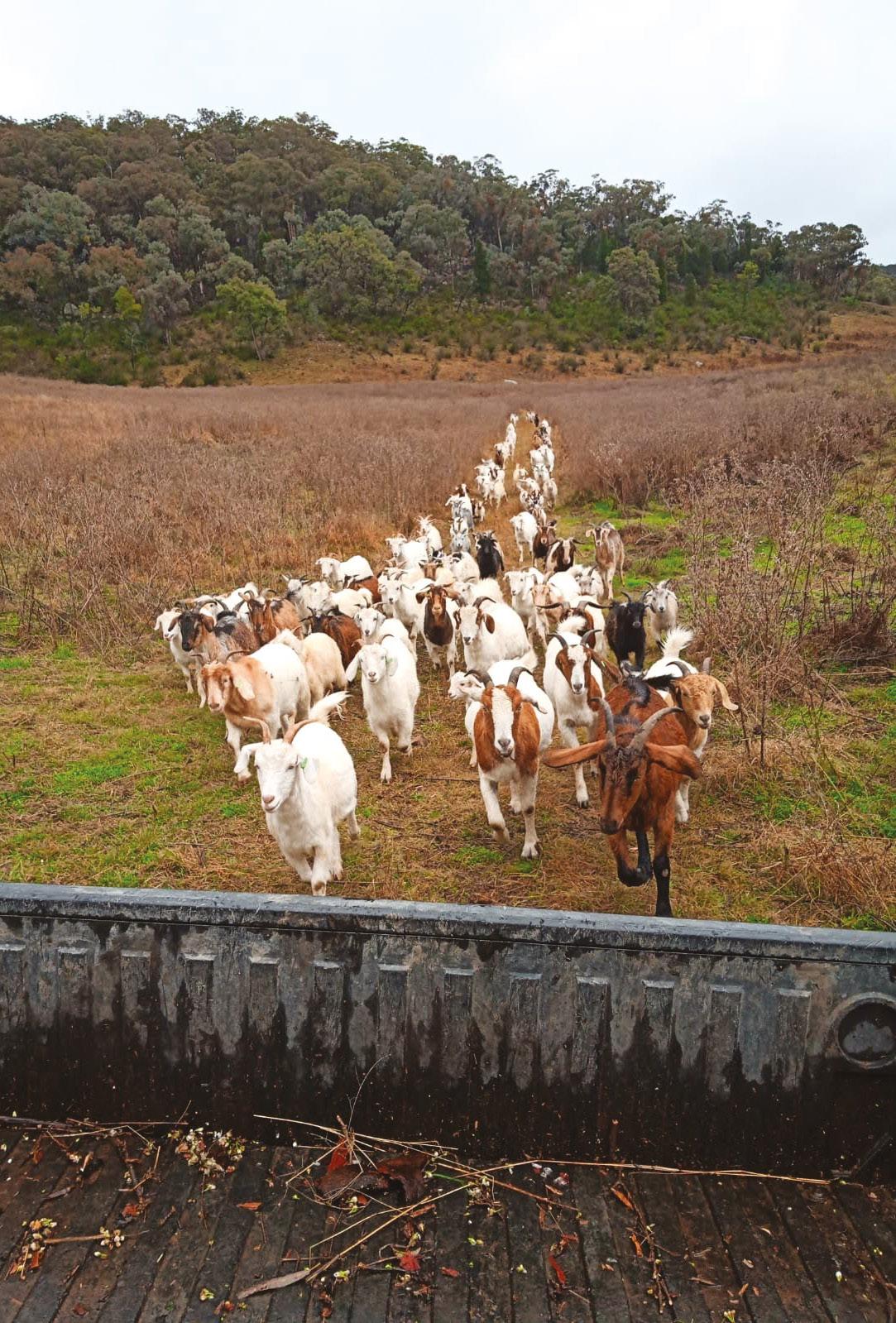
Michael Blewitt and Billie Johnstone started out as treechangers but are now leading the charge on utilising goats and permaculture for managing noxious weeds and assisting the RFS with wildfire control.
Michael and Billie bought Dry Creek Farm, 45 kilometres northeast of Mudgee, in 2013 even though it was covered in blackberries. Their solution: get a herd of goats to eat all the noxious weeds. They were so successful that they now hire their goats out to other properties as well as to the Central West Rural Fire Service for a very effective, non-chemical weed control and fireprevention solution.
Michael and Billie wanted to move to the country to raise a family more than a decade ago, and started looking around for a place that was not too far from Sydney. They had no farming background but had completed a course in permaculture. Their price range put them in the Mudgee region and when they found a farm surrounded by stunning sandstone cliffs, they were sold.
“It was the last property at the end of the road, and we would own the whole valley,” says Michael. “It was so quiet and peaceful and surrounded by bush. With 105 hectares, we would have enough land to do something interesting. Sure, it had its issues – access was difficult with the last five kilometres on a 4WD track, and there were blackberries everywhere, but we shared every tree changer’s idealistic dreams and had grand plans for self-sufficiency.”
A ROCKY BEGINNING
They bought the property at the end of 2013 and started planting trees and vegetables. However, 2014 was a very dry year and the farm was like a dust bowl. “There was no ground cover, the topsoil was gone and we killed everything we put in the ground,” says Michael.
But that wasn’t their only problem. After they bought the farm, the local council’s weed inspection team paid a visit and ordered them to remove all the blackberries growing along the creek line. Even after they cut out much of the blackberries, when the
BUSINESS GOATS
–
Words SUSAN GOUGH HENLY
>
MAY - JUNE 2023 THE FARMER 47
Michael and Billie have 160 goats in total on Dry Creek Farm, with 80 working on the road for fire hazard reduction and 80 at home rotating through paddocks to encourage grass regeneration.
HERD MENTALITY
Michael and Billie have developed quite a reputation as early adopters of goat herding for weed control. “It seems more than valuable to consider alternatives, especially if they solve a noxious weed problem and offer a product at the end (goat meat) versus spending a lot of money and degrading the environment,” says Michael.
council re-inspected, they found enough of the noxious weed on the property to threaten to hire a contract spraying company which estimated it would take five ten-hour days – at $100 an hour plus the cost of chemicals – to solve the problem. Apart from the fact that they opposed a chemical solution, Michael and Billie simply did not have $5,000 to spare.
They had to find another way.
“One of the key ideas of permaculture is that the problem is the solution,” says Michael. “Our problem was not too many blackberries but not enough animals to eat them. We had too much of a resource and no way to use it and any resource in excess becomes waste.”
So, they decided to buy a small herd of 14 goats.
“In the first 10 minutes, the goats broke out and got away. That’s what goats do,” he laughs. “We learned pretty quickly about moving the herd with feed and we started using three 50-metre electric net fences around the blackberries. We moved them around like this for 12 months and they ate all the blackberries at least once.
“We had this light bulb moment that since the goats were so successful for us, maybe it would be an interesting sideline business,” says Michael. “A few years later, it turns out that it’s our main business. It’s what we do.”
They set up a website in early 2018, as well as Facebook and Instagram accounts, to advertise their goat herds as an alternative to spraying.
It turns out that the Local Land Services (LLS) office will tell you to go and engage a sprayer or look up a list of local sprayers, but staff won’t give any information about a company that provides an alternative solution because they cannot promote an individual business.
“It seems more than valuable to consider alternatives, especially if they solve a noxious weed problem and offer a product at the end (goat meat) versus spending a lot of money and degrading the environment,” says Michael.
Michael and Billie’s typical clients are new to farming with hobby blocks in the Mudgee area or those with residential properties in the Blue Mountains where vegetation grows profusely.
A NOVEL SOLUTION TO FIRE HAZARD REDUCTION
Two years ago, their focus changed when they were approached by the Rural Fire Service (RFS) in the Cudgegong area to participate in Australia’s first trial using goats as an alternative hazard reduction tool. The trial came about because of the independent inquiry into the Black Summer bushfires which recommended expanding grazing as an additional fire mitigation strategy. The LLS in Mudgee was very helpful and worked closely with the RFS to facilitate the trial.
“We’ve had 80 goats moving along a corridor around Lue, between Mudgee and Rylstone, for about 18 months, and the RFS is collecting data on their efficacy,” says Michael.
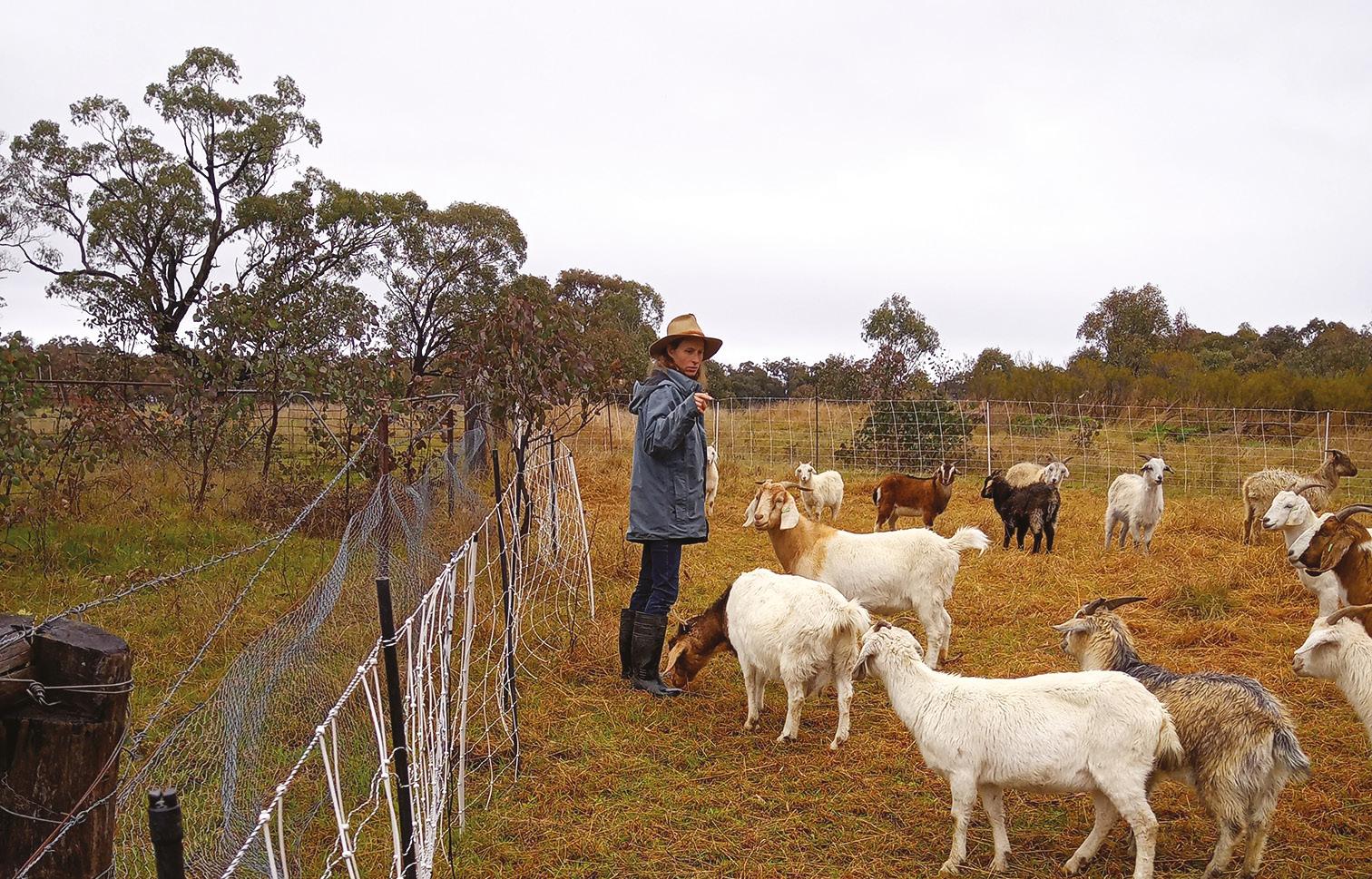
BUSINESS GOATS
THE FARMER MAY - JUNE 2023 48
Goats not only eat a wide variety of vegetation but they also eat into weedy, woody plants, which is useful in areas that have not been rotationally grazed regularly. It’s these woody environments that are particularly fire prone.

The RFS has complex regulations regarding burns. Meanwhile, goats can reduce a lot of woody growth to stop fire getting into shrubs and canopy. They turn the woody growth into manure which makes the soil more fertile and less susceptible to weeds. They also work well in difficult sites, such as along train lines cutting through gorges, on steep hills or where there is old refuse in areas near schools, hospitals, townships
FIRE FIGHTERS
Two years ago, Michael and Billie’s focus changed when they were approached by the Rural Fire Service (RFS) in the Cudgegong area to participate in Australia’s first trial using goats as an alternative hazard reduction tool.
and along main roads where it is problematic to do burns. And they work year-round rain, hail or shine. As a result, they can completely change the fire hazard.
Michael and Billie have developed quite a reputation as early adopters of goat herding for weed control and fire hazard reduction in Australia. And they have consulted with the RFS as they expand the goat program to six more locations around NSW. It turns out that using goats for vegetation control is not a new thing. They’ve been employed for quite some time in the USA, Canada, Portugal and Spain. It’s commonplace, for instance, for Lee Hazeltine and Laura Gunderson of Integrazers – trailblazers in systems-managed grazing in California – to run herds of hundreds and thousands of goats and sheep to undertake vegetation control on a larger scale.
PERMACULTURE PARADISE
Today, Michael and Billie have 160 goats in total, with 80 working on the road and 80 at home rotating through paddocks to encourage grass regeneration. They keep most of the girls – who are generally better behaved – and eat any boys that are troublemakers.
Now, they also have a few beef cows as well as a dairy cow, and are on the way to developing a fullyfunctional permaculture farm with swales covering wood chips and hay bales to create an effective water harvesting system, a prolific multi-species orchard, nitrogen fixing plants supporting productive plants in raised wicking garden beds, and flowering shrubs attracting pollinators and birds.
“When you take the goats out for weed control you have conversations with new hobby farmers about what else they can do to improve their soil fertility and water harvesting capabilities and hence the productivity of their farm,” says Michael. “We’ve started sharing some of the lessons we’ve learned along the way and now offer permaculture design and implementation (including earthworks) as well as advice on regenerative agriculture as part of our business.”
They consider the overall farm plan working backwards from the house, so that native bush is furthest away, then establish the location of the animal systems (ideally with rotational grazing to manage weed growth and encourage soil health). Then it comes to what to do with fences and roads, where to put dams and how to set up watering points, where to build contour structures to passively harvest water, and then where to set up orchards, vegetable gardens and ornamental gardens that encourage pollinators around the house.
It’s been quite a journey but, as recent adopters of permaculture principles, Michael and Billie have certainly proven that the problem can also offer the solution. Since goats could be considered a key component of a natural ecosystem, they may just become the leaders in a goat-led approach not only for managing noxious weeds and regenerating the land, but also for reducing fire hazards on our increasingly hot and dry continent. l
“It seems more than valuable to consider alternatives, especially if they solve a noxious weed problem and offer a product at the end (goat meat) versus spending a lot of money and degrading the environment.”
–
MAY - JUNE 2023 THE FARMER 49
MICHAEL BLEWITT Owner of Dry Creek Farm
Domes of hope and happiness
A farming family turned to tourism following the 2018 drought to preserve their farming heritage and start a new business.
 –
Words SUE WALLACE
–
Words SUE WALLACE
THE FARMER MAY - JUNE 2023 50
An on-farm tourism venture was not on the cards for farmers Belinda and Jaime Munsie, who run beef and sheep on their northern NSW property Willunga, near Warialda. But the 2018 drought changed all that.
Jaime, who is a third-generation farmer, watched his family livelihood collapse as they were forced to destock on their 3,642 hectare property. Like so many others, they felt despondent and unsure of their future during what was described as the driest conditions in 100 years.
Their daughter, Kate Boshammer and her husband Nick, have an Angus stud at Chinchilla in Queensland. Kate says selling all the stock greatly affected her whole family including her brothers, who all work on the farm.

Belinda knew they had to find something that was not solely dependent on the weather to generate income in order to safeguard the future of their family operation for generations to come.
AGRITOURISM INSPIRATION
On a trip to the US in 2016, Belinda and Jaime noticed lots of Airbnbs and on-farm accommodation, which later inspired them to research what they could do on their property to boost farm income.
Belinda says they saw many ranches being utilised for tourism, which brought
additional economic benefit to the farming operation, while also attracting tourists to different regional areas. So, they thought, why not give it a go?
“Also, during our travels throughout Canada and Alaska, we were surrounded by tourists, who had never travelled outside metropolitan areas and were seeing wildlife for the first time,” she says.
“This was a foreign concept for Jaime and myself, who have wildlife on our doorstep every day. We then realised the great potential for more tourism opportunities in Australia, particularly on farming properties.”

Belinda considered all different types of accommodation and wanted a distinctive style that was easy to construct, financially viable and offered a unique experience for visiting guests.
“We wanted accommodation that gave city residents an opportunity to visit the real Australian outback, not just the hinterland of coastal towns or the scenic rim of major cities. It was the perfect time for mum to put her idea into action to help deal with the extreme drought conditions being experienced throughout Australia,” Kate says.
Belinda discovered a geodesic dome structure while researching the market and noted that dome structures were becoming popular around the globe and being used in various climates.
She settled on the geodesic dome
>
BUSINESS FARAWAY DOMES
DOME SWEET DOME
MAY - JUNE 2023 THE FARMER 51
The Munsie family (L-R): Digby, Sam, EmmaRose, Jaime, Fergus and Belinda Munsie with Kate, Willa and Nick Boshammer.
structure, covered with a fire-rated thick PVC cover. This structure is rated as being the strongest framed structure known to mankind, which has proven its worth by standing up to all the elements the harsh Australian climate has thrown at it. From this, their business Faraway Domes was born in 2018.
A FAMILY AFFAIR
The property is located in the North West Slopes and Plains region about 600km north west of Sydney and 30 minutes from the small town of Warialda. Since the drought, the land has regenerated and there’s lots of green bushland surrounding the two domes.


“Enormous efforts have been made to reduce the dome’s impact on the environment including the establishment of the eco-friendly wastewater system and off-the-grid power supply,” says Kate, who is the CEO of the enterprise.
“Now Faraway Domes is a thriving business. On top of the farming operations, which are in full swing again, everyone is keeping very busy,” she says.
“For us it is all about first-class comfort with minimal carbon footprint in a truly unique and private environment.”
Belinda adds that although the drought conditions took a toll, the dome project – which involved a lot of red tape initially and took a year to gain approval –brought their family together at one of the toughest times in the history of the property.


BUSINESS FARAWAY DOMES
“Guests literally have 3,642 hectares to themselves while watching native birds flying overhead and cattle, sheep, goats and kangaroos grazing below.”
THE FARMER MAY - JUNE 2023 52
–KATE BOSHAMMER CEO, Faraway Domes
“It’s also provided a good distraction from the dry conditions and gave everyone hope for the future with lots of work,” Belinda added.
It is very much a family-run business, according to Kate.
“My father and brothers Will and Sam built the deck and erected the domes. The biggest hurdle was all the red tape that my mother had to deal with in the construction phase,” she says.
“Our entire family all played a part in producing our first dome with one sister-in-law being an interior designer and stylist; another sister-in-law is a journalist and my background is marketing and PR, so it really has been a big family effort.”
A DOME AWAY FROM HOME
Three years later, after receiving a swathe of tourism awards and finding the geodesic accommodation consistently booked, the Munsies added a second giant dome.
The domes sit 140 metres apart and out of sight of each other for ultimate privacy. Both domes have
sweeping views of rolling hills and grazing livestock, and each have their own private driveway.
“Guests literally have 3,642 hectares to themselves while watching native birds flying overhead and cattle, sheep, goats and kangaroos grazing below,” Kate says.
“We have such a beautiful region and we’re really excited to showcase this to visitors interested in escaping to the country and connecting with nature. We hope to lure guests from all over Australia and around the globe to experience a uniqueness second to none.
“The district has so much to offer, and we are confident a visit to Faraway Domes will leave an indelible mark on anyone who stays.”
The self-contained domes each sit on a four-metrehigh deck, accommodate two guests and feature a king-size bed, open-plan living and kitchen area, a private bathroom and a private outdoor bath and plunge pool that overlooks the spectacular outback views. The additional dome is perfect for couples visiting with friends, with the option of renting out both domes at the same time.
“The result is unlike anything the region has seen before,” Kate adds.
A SLEW OF AWARDS
The award-winning retreat has been dubbed ‘one of Australia’s most unique experiences’ with capacity rates currently at an all-time high from travellers wanting to explore regional Australia in style.
The family have been well rewarded for their hard work and foresight, taking out gold for the Best New Tourism Business at the NSW Tourism Awards in 2019, nine months after they opened.
Judges acknowledged the Munsie family’s commitment to creating an experience for all visitors to reconnect with regional Australia.
SWEEPING VIEWS
The self-contained domes each sit on a fourmetre-high deck around 140 metres apart. They both accommodate two guests and feature a king-size bed, open-plan living and kitchen area, a private bathroom, outdoor bath and plunge pool that overlooks the spectacular outback.
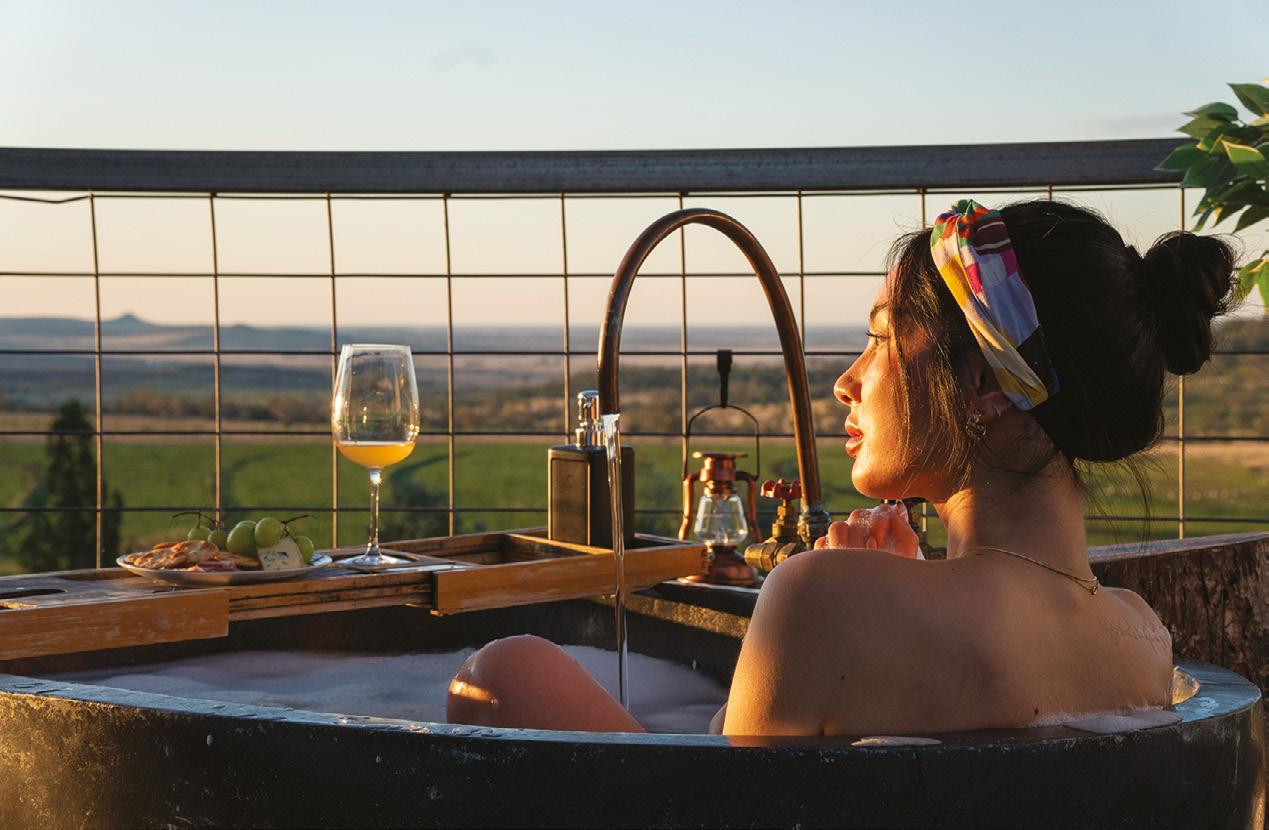
“We felt so honoured to be recognised with this prestigious award so early in our journey. It’s such a credit to the hard work my family has dedicated to the project,” Kate says.
Belinda says it was an exciting time to expand Faraway Domes with so much to offer to those looking for a private retreat as their next getaway.

“It’s been so rewarding to see how many people want to travel to outback Australia and experience what we have here,” Belinda said.
“We’ve had guests stay from all over Australia and around the globe including Sydney, Brisbane, Melbourne and Canberra as well as Canada, the UK, China, the US and Switzerland.”
Kate says as a business venture it has worked better than they ever expected and sits well with their agricultural pursuits. It has been an ideal add-on.
“It’s been a great transition and although the business venture wasn’t in anyone plans, it has opened our eyes up to how many people want to experience the bush,” she says.
Jaime adds: “We are just farmers, and had no idea we were capable of doing this to add more income to the farm. It has been extraordinarily rewarding for all.” l
MAY - JUNE 2023 THE FARMER 53
CONNECTIVITY DRIVING EFFICIENCY AND PROFITABILITY
Remote farm monitoring, enabled by connectivity is driving efficiency, improving operation effectiveness, increasing profitability and providing peace of mind for Australian farmers.
 –
Words DARREN BAGULEY
–
Words DARREN BAGULEY
of the NSW land mass and will provide a more costeffective solution that uses less power.”
This is an example of Telstra’s commitment to agriculture, by innovating to give farmers connectivity options through a mix of mobile, IoT and satellite networks and now also extends to their recent investment in Farmbot.
Luke Harwood, Head of Innovation & Managing Director of Telstra’s early-stage investment arm, muruD, said this latest investment aligns with Telstra’s commitment to support connectivity and innovation in rural Australia.
“Maximising connectivity and digital innovation in rural and regional Australia is a big priority for us. We’re excited by the opportunities of technology to transform the agricultural industry and contribute to a more efficient and sustainable sector. Investments like this will also help achieve the National Farmer’s Federation’s vision to see farmgate output reach $100 billion by 2030.”
Farm automation is an increasing trend. As technology gets better and cheaper and labour becomes more expensive and harder to find, the return on investment for technology such as remote monitoring and control becomes increasingly compelling. For many farmers connectivity is perceived as an obstacle, however, agtech vendors are directly addressing the issue with a variety of solutions, according to Farmbot’s Head of Marketing, Elizabeth Cameron.
MIX OF CONNECTIVITY SOLUTIONS PROVIDE NATIONWIDE COVERAGE
“With our solution, farmers don’t need additional connectivity [to deploy it]. Our satellite services cover the entire country. We are also working closely with Telstra to develop solutions for their NB-IoT (Narrowband internet of things) Cellular Low Power Wide Area Network which now covers almost 95%
GETTING CONNECTED
Remote monitoring technology such as FarmBot can provide up-to-the-minute reporting, allowing farmers to optimise both their time and resources. And best of all, as a satellitefirst solution, farmers don’t need additional connectivity to deploy it.
“With Australia’s largest mobile network, leading technology solutions and regional customer base, we see a unique role for muru-D and Telstra to help Farmbot’s continued growth,” said Mr Harwood.
Even though connectivity is improving, many of the issues farmers continue to be faced with are only too familiar. Farmers are struggling to find labour and constantly looking for productivity improvements to boost their bottom line. While the east coast of Australia has just come off its third La Nina event in a row, stock water remains a constant issue for farmers, particularly on larger properties.
TIME, LABOUR AND VEHICLE COST SAVINGS
“One of the main things that we constantly hear from farmers is they don’t have enough time. By giving farmers remote visibility of tank levels, trough levels, and control of their pump, we’re giving them time to be able to do other jobs around the property. Instead of spending hours a day driving to check stock water, they can do it all with a touch of a button from their phone.”
SPECIAL REPORT CONNECTIVITY
THE FARMER MAY - JUNE 2023 54
While there are obviously cost savings tied into labour there are other costs associated with that activity. Wear and tear on a vehicle, fuel, which has gone up in price and supply chain issues with sourcing new vehicles and parts. “That’s where it all comes back to operational effectiveness and increasing profitability” says Elizabeth.
VALUABLE INSIGHTS PROVIDED BY MINUTE BY MINUTE MONITORING
Systems such as Farmbot allow for up-to-the-minute changes in water consumption to be reported, providing valuable insights into stock behaviour and water usage patterns which further drives operation efficiency. Farmers can use this information to optimise their time and resources, such as knowing when to muster, check their cattle or when to fill water storages.

“A new technology we’ve just launched is a Pump Control. Most tanks come with a pump next to it and being able to automate and turn on off a pump based on water level [allows farmers] to be more efficient
PEACE OF MIND
Elizabeth Cameron, Head of Marketing for FarmBot (pictured above), says one of the great benefits that systems like My FarmBot can provide farmers with is peace of mind; Examples of My FarmBot graph and map interface (below).
with their use of water, but again without having to drive out to turn something on and off.
“Then last of all, something we constantly hear from our customers is peace of mind. Farmers spend hours each week driving to check water, if their livestock don’t have water, their growth rate reduces substantially, and livestock health can be endangered. It’s not on all farms, but many have pumps that are unreliable, pipelines that have been there for a long time and being able to monitor water remotely gives farmers the peace of mind to go away for the weekend or just drive into town and watch the footy with their mates. This is especially the case with our real time alerts that can be programmed to send a message to the farmer if there is a sudden drop in water level in a tank level or if a pump needs switching on.”
ROI SOLID BUT TIME TO UNDERSTAND TECH STILL A BARRIER
As remote monitoring solution capabilities expand companies like Farmbot, which has over 10,000 units installed with 4,000 farmers using the platform, the return on investment is clear. This Savings Calculator simply breaks down the costs and ROI (https:// farmbot.com.au/savings-calculator/). Nevertheless, Elizabeth acknowledges there are still barriers to farmers adopting technology.


“The main one that I see is time, which is so interesting, because what we’re doing is providing atime saving tool. But farmers are always saying, ‘I don’t have time to look into this and learn it.’ There is a perception technology is complicated, but it’s not. Farmbot has been designed as a simple out of the box solution [to address those barriers]. Everybody that starts using our product just can’t believe how simple it is and says they wish they installed it sooner.
“An additional barrier is changing behaviour. It isn’t always easy, changing a process that you’ve always done, especially the process that’s been ingrained in your operation. It can be particularly difficult for family farms that don’t put a monetary value on their own time. They don’t factor in their labour cost for manual tasks like checking water. Whereas larger operations with paid employees are thinking great, I can upskill this employee and use their time to add value to the property itself.” l
“Instead of spending hours a day driving to check stock water, they can do it all with a touch of a button from their phone.”
MAY - JUNE 2023 THE FARMER 55
–ELIZABETH CAMERON Head of Marketing, FarmBot
PREPARING FOR THE NEXT DROUGHT
With La Niña officially over, what do the weather patterns ahead of us hold, and how can farmers be prepared for what might unfold next?
 –
Words IAN NEUBAUER
–
Words IAN NEUBAUER
THE FARMER MAY - JUNE 2023 56
On March 10, the National Oceanic and Atmosphere Administration placed farmers across the nation on notice when it announced in its monthly analysis that La Niña has ended.
The phase of the eastern Pacific Ocean that typically brings rain and floods to eastern Australia, La Niña’s demise after three consecutive years means the weather is returning to a near-average state of cloud and rain. It also means the door is now open for the Pacific’s opposite phase, El Niño, which can bring drought to eastern Australia. The question on everyone’s lips, then, is how long have we got to go until the next big one?
“It’s such a complicated question,” says Hugh McDowell, a senior climatologist at the Bureau of Meteorology in Sydney. “Drought depends on soil moisture, the health of river systems and so many variables, so we don’t forecast drought. What we do is report on rainfall deficiencies. The NSW Government then studies our reports and decides if it’s drought or not.
“Our longest-range forecasts,” Hugh explains, “are three or four months. Right now, we’re forecasting unusually dry conditions for June and July. We’re already starting to see spots of serious to severe rainfall deficiencies and below average rainfall in northeast NSW, and below average soil moisture in those areas.
“Our long-range forecasts for unusually dry conditions are about 60 per cent to 70 per cent accurate and they’re getting more accurate over time,” he explains. “But we still can’t tell you anything about how much rain we may or may not have next summer, as we don’t forecast that far ahead. So, if a farmer asked me when is the next multi-year drought, I would tell them I don’t know. But I would also tell them it’s inevitable at some point. So, it’s best to start preparing now.”
With that advice in mind, we spoke to three senior researchers at the CSIRO’s Drought Resilience Mission looking for new ways to reduce the impacts of drought on agriculture. We asked them one basic question: how can farmers start preparing for the next drought now?

GENETIC SELECTION FOR DESTOCKING
“Our overall message is that you prepare for drought outside of drought, because nearly anyone who has a plan, regardless of how good it is, will be in
a better place when it’s dry than those who are just doing what they have always done,” says Dr Sabine Schmoelzl, group leader at the CSIRO’s livestock and aquaculture program, who has been studying livestock reproduction for the past 10 years.
“A lot of people say: ‘I’m too busy to make changes’, but the reality is that drought is a really stressful time for farmers, especially livestock farmers who do not want to see their animals suffer or have to make a lot of tough decisions and being prepared for that is essential.”
Sabine says livestock systems are so complex no two drought resilience strategies are the same. “For many farmers what works well is being very conscious about how much feed they have and how much livestock they can carry, and as soon as that changes to start destocking,” she says.
“Destocking brings an influx of capital that farmers can use to set up their property to be more efficient for feeding the animals they keep, or as a stash to buy back better animals when the drought breaks and improve the genetic value of their herd. That’s what we are currently exploring. Our team is collecting data and modelling different destocking scenarios, looking at the consequences of strategy and comparing the data to different approaches.”
Most livestock farmers in Australia still can’t access the information needed to select animals using genetics. But that is quickly changing, Sabine says: “In recent years, new genetic selection tools have become available that are specifically geared towards commercial producers and are not too complex to use. All you need to do is collect a skin sample and send it away. The cost has to be taken into consideration and it is still not available for every single breed. But it gives you so much more information than you had before.”
THE SWEET SPOT IN YOUR SOIL
Dr Lindsay Bell, a principal research scientist at the CSIRO’s agriculture and food program, is conducting a series of long-term experiments on different cropping strategies at seven different grain farms across northern NSW and southern Queensland.
“One of the key things we have learned is that knowing the amount of water in your soil should be a critical element of decision-making for your cropping system,” he says. “If a crop does not have enough
>
ENVIRONMENT DROUGHT
“If a farmer asked me when is the next multi-year drought, I would tell them I don’t know. But I would also tell them it’s inevitable at some point. So, it’s best to start preparing now.”
–
HUGH MCDOWELL
MAY - JUNE 2023 THE FARMER 57
Senior climatologist, Bureau of Meteorology
moisture available in the soil, it will not convert that water very efficiently into grain. In other words, you need a minimum amount of soil water to successfully turn water into grain. So, if our certainty of getting rain in the next season is going down, it gets far more important to understand how much water is in the soil before we plant a crop.”
There are several ways farmers can measure soil moisture, Lindsay says, starting with simple DIY probes and apps that can give you a “good” measure, to more sophisticated sensing technologies that are installed permanently or specialist service providers who visit your farm and present detailed reports.
The challenge for most farmers, Lindsay explains, is to get more water into their soil. You can’t achieve that by pumping water into it: “The only way to accumulate soil moisture is to follow your soil with the residue of your last crop for longer periods – but not for too long.
Our research shows there’s a sweet spot. If you fallow for too long and wait for a great deal of water to accumulate, the result will be less efficient and you lose moisture to evaporation. But if you are too aggressive with your planting, the result will be less efficient as well. It’s about finding the sweet spot and most of our research shows you need 100mm to 150mm of soil moisture for most crops. Summer crops are at the top of that range – you want 150mm for wheat, and around 100mm is around the right height.
“Ultimately it’s about understanding how much moisture is in your soil before you plant, and creating a reservoir of soil moisture you can bank on that is less vulnerable to seasonal conditions like drought,” Lindsay says.
AN ONLINE CRYSTAL BALL
“We know farmers can’t prepare for everything, but we also know it’s more likely to be drier than average in South Australia in the future. By preparing for drought, you are stacking the odds in your favour,” Dr Graham Bonnett, interim leader of the CSIRO’s Drought Resilience Mission.

Graham has spent much of the past two years overseeing the development of Climate Services for
Agriculture – a new online tool that allows farmers to ‘explore their climate future’. A prototype is already live at climateservicesforag.indraweb.io/explore.
“It’s a way for farmers to look ahead at what the future may bring by showing representations of future climate predictions under various scenarios,” he explains. “And we’ve designed it in such a way so that you can look at particular aspects of the climate in their locality and see how it might their enterprise.
“It also shows historical weather patterns for the last two 30-year periods. So, if you are growing wheat, you can see how rainfall has changed in the past and how it might change in the future. And it’s not just for crops but for animals, too.”
Graham also spoke of an interesting new drought solution called water banking.
“We’re working with scientists at various demonstration sites across northern NSW to see if this is a good way to manage drought,” he says. “The idea is to take water in wet years when it is in abundance and store it underground.
“One of the main reasons it hasn’t been done in Australia yet,” he says, “is legislation. In NSW, above-ground and below-ground water are managed
SOIL SOLUTIONS
Dr Lindsay Bell, a principal research scientist at the CSIRO’s agriculture and food program, says that creating a reservoir of soil moisture will keep your farm less vulnerable to seasonal conditions like drought, which can exacerbate bushfire risks.
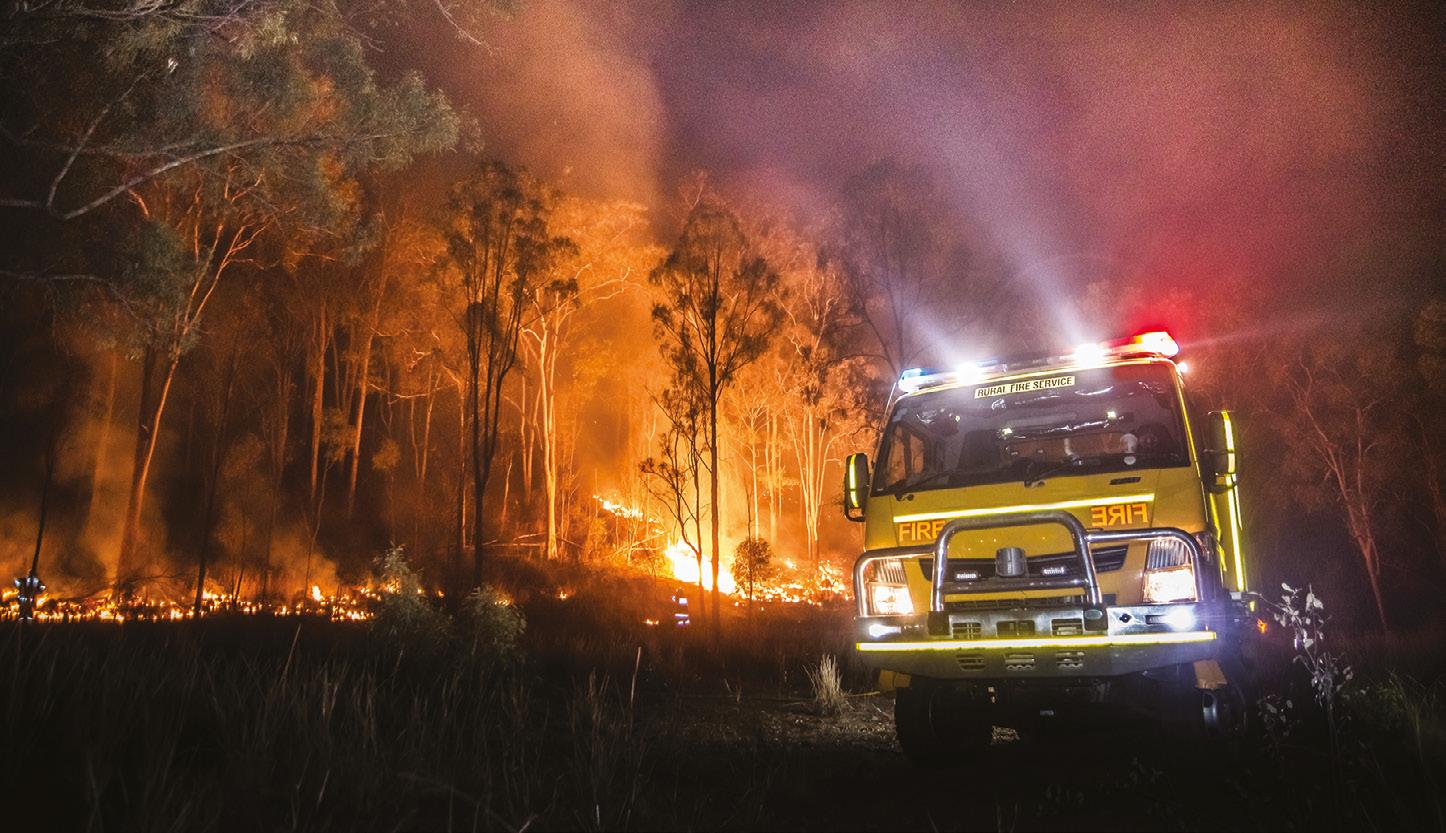
“Where I think we could be more innovative is on the financial side, and the ability to commercialise weather risk at wholesale rates for weather derivatives or weather certificates.”
–
XAVIER MARTIN
THE FARMER MAY - JUNE 2023 58
NSW Farmers President and grain farmer
separately, so you may not have the rights to it if it’s underground. It’s one of the many things that needs to be worked on.”
Graham has a final piece of sound advice: “Our predictions may not be right every season, but they’ll be right the majority of the time. That means if you plan accordingly, you’ll end up making the right decisions most of the time.”
BETTING ON THE WEATHER
NSW Farmers President and Mullaley grain farmer
Xavier Martin said farmers have learned to be more innovative in drought preparedness on the farm, thanks to the work of research groups like the CSIRO.
“Farmers have had to get better at it, not only to sustain their family businesses but to meet societies expectations that our herds and flocks will be fed,” Xavier said.
“We are volunteers in the landscape. We are trying to harness the weather and the soil to produce food and clothing, and we do a very good job at that.
“Where I think we could be more innovative is on
WEATHERING THE STORM
NSW Farmers President and Mullaley grain farmer Xavier Martin says that farmers have learned to be more innovative in frought preparedness thanks to research groups like the CSIRO: “Whether you are growing grapes, milking cows or harvesting a sunflower crop, you can tailor your weather risk.”
Did you know?
Farming accounts for nearly 70 per cent of all the water consumed in Australia.
Australia’s average annual rainfall of 470mm is well below the global average of 900mm.
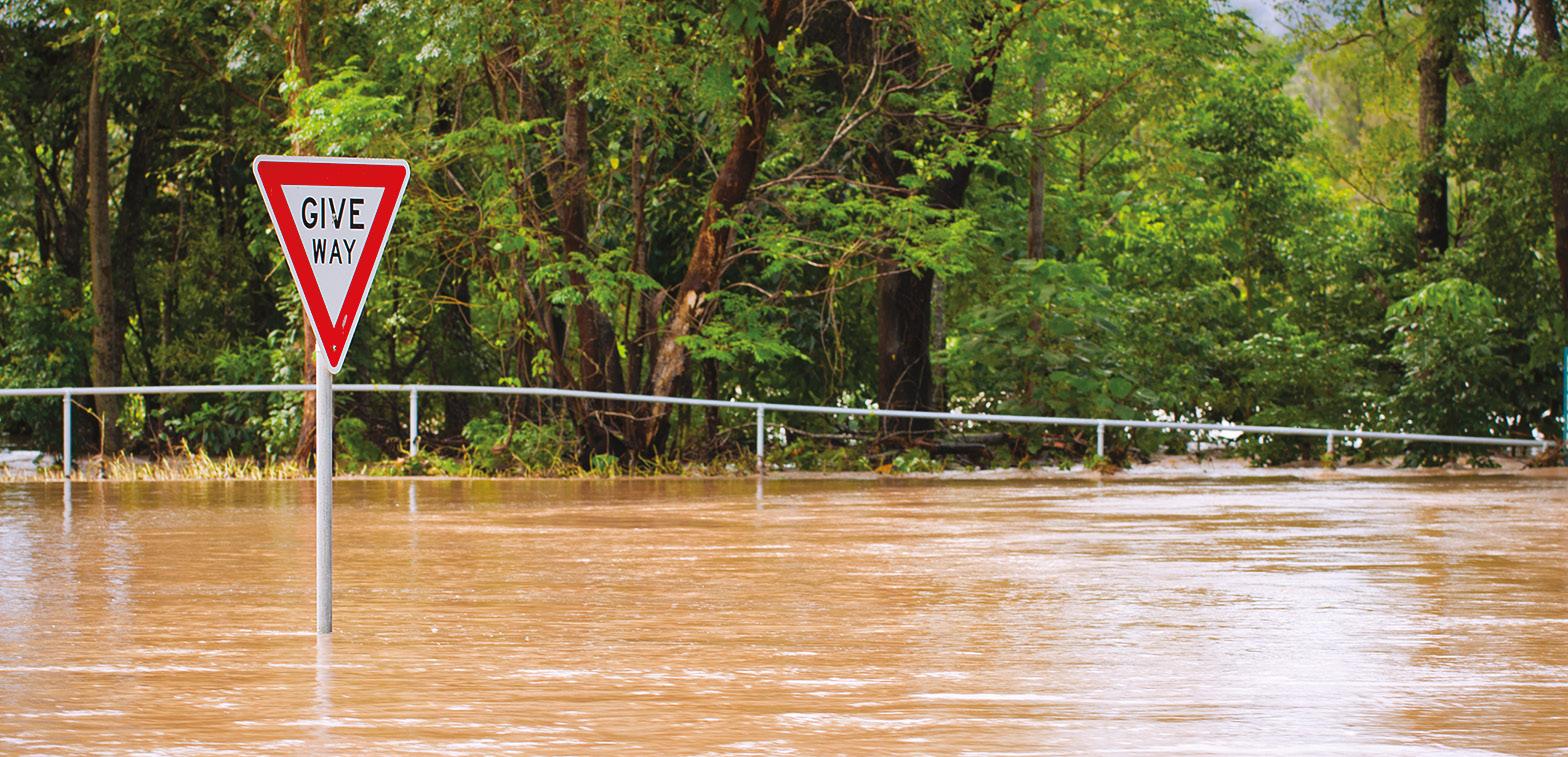
the financial side, and the ability to commercialise weather risk at wholesale rates for weather derivatives or weather certificates.”
Weather derivatives are financial products that derive their values from other more basic variables, such as temperature, precipitation, wind, heating degree days and cooling degree days.
They differ from insurance, in that insurance requires a demonstration of loss, whereas weather derivatives require no demonstration of loss, but rather provide protection from the uncertainty in normal weather or climate.
Xavier said they effectively transfer risk from those who are involuntarily exposed to unwanted risk to those who voluntarily trade in risk management.
“Whether you are growing grapes, milking cows or harvesting a sunflower crop, you can tailor your weather risk.”
“While current retail options might not look like they are cost effective, there are options to promote a wholesale scheme for nation like Australia that has dry risk.” l
SpraySMART is a Registered Training Organisation (RTO – 40867) and leader of Face to Face, Online, Zoom ( Live) , Zoom (pre-recorded) and In-House Chemical Accreditation Training throughout Australia. SpraySMART works with all Industry Sectors to provide training and Industry accreditation for users of Agricultural and Veterinary Chemicals (AgVet)

SpraySMART is Nationally recognized and provides Training in the following units of competency:
1. AHCCHM307 Prepare and apply chemicals to control pest, weeds and diseases
2. AHCCHM304 Transport, handle and store chemicals
10% Discount to NSWMembersFarmer
ENVIRONMENT DROUGHT
872 462 | training@spraysmart.com.au | www.spraysmart.com.au
1800
TF JF23_TPH Spraysmart_74x194.indd 1 19/12/2022 12:09 pm MAY - JUNE 2023 THE FARMER 59
Agritourism options have developed beyond normal expectations. Tiny homes can now be bespoke designed: from a weekend getaway to a two-storey building with balcony and spa, or even a spare bedroom or yoga room at the end of the pool deck.
The prolific range of options has developed in response to land use changes that enable NSW landowners to offer farmstay accommodation and camping, as well as value-adding to farm businesses.

The options available have gone beyond a few renovations to the old shearing shed or stables to make them usable as overnight accommodation.
The expansion of industry work-from-home options has also lent itself to bespoke ‘tiny homes’.
It extends into buildings that can be used for cellar doors, restaurants, cafes, events and visitor information centres – or home businesses such as hairdressing salons, yoga rooms or art studios.
Last year, NSW Farmers successfully lobbied the state government to develop policy that enabled the growth of agritourism activities on farms.
Farmers who want to set up a simple nine squaremetre roadside stall that is secure against pests and the elements and is on their property, can do so.

Up to six buildings can be used for tourist accommodation, with guests staying a maximum of 21 consecutive days.
Each council area will have different requirements and should be consulted before putting down footings on your new venture.
Biosecurity issues should also be identified and a risk-management plan developed.
CAMPING OR GLAMPING ON THE FARM
In 2022, Rod and Desley Bailey of Homegrown Organic Farm at Rolland Plains added camping to their business model, offering bookings through Hipcamp.
Desley said the family began their agritourism venture with two camping sites in one of their
>
SPECIAL REPORT AGRITOURISM THE FARMER MAY - JUNE 2023 60
FARMER WANTS A TOURIST
Forget shows like Farmer Wants a Wife, farmers in New South Wales are courting tourists instead.
TINY LIVING
Above and below: Roadside farm stall, Byron Bay; Elsewhere Pods are prefabricated pods built as tiny homes or outdoor studios.

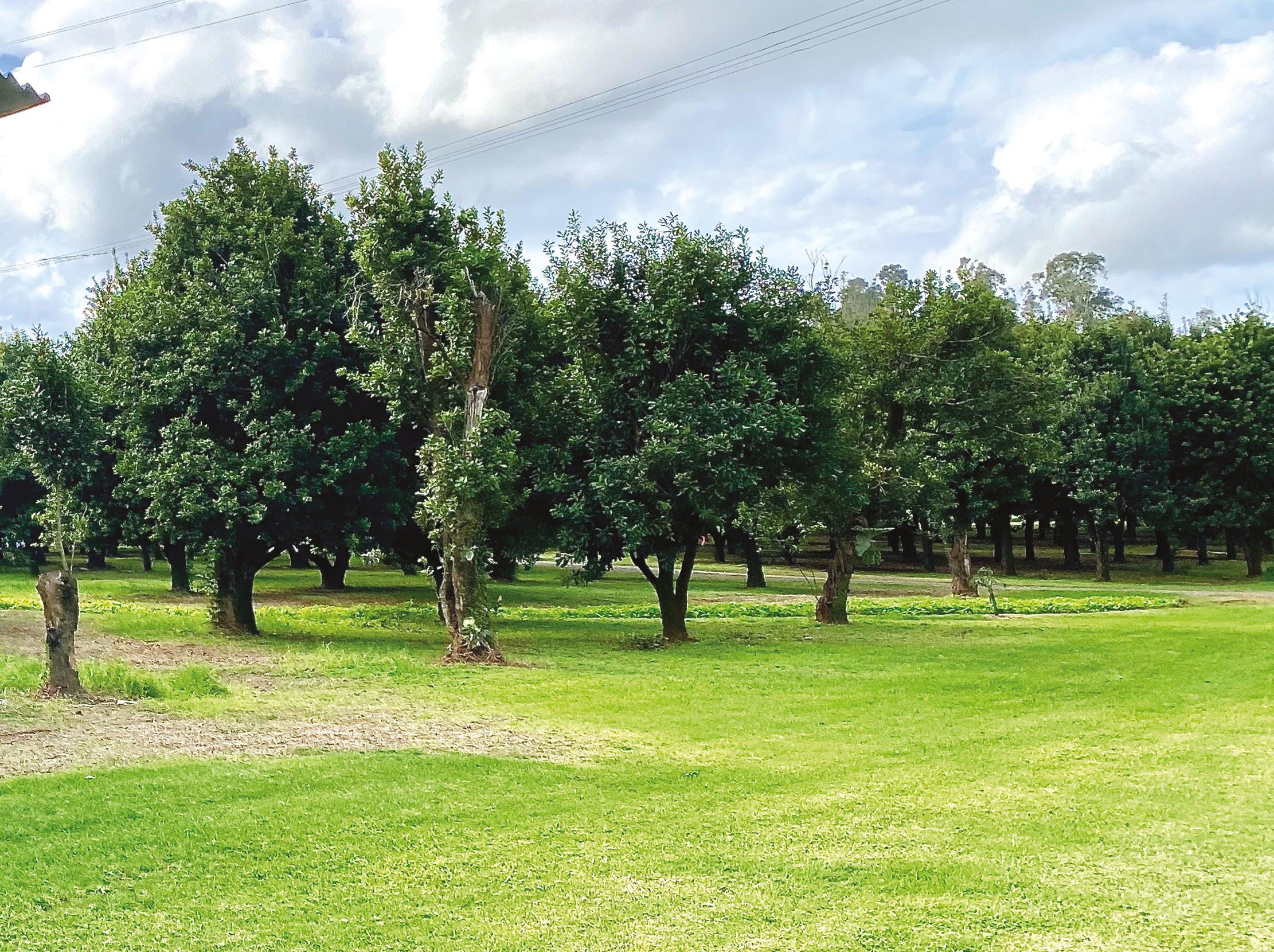
–
JEANETTE SEVERS MAY - JUNE 2023 THE FARMER 61
Words
paddocks. They are planning to expand to four sites, including a more rugged camping experience.



Many of their campers enjoy the farm experience and extend their holiday activities into the surrounding district, including bushwalking, swimming and visiting local waterfalls.
Kenneth Sauer of Hipcamp said the organisation wanted to be the partner of choice for farmers wanting to offer camping options on their land.
After changes to the planning system in December last year, over 100 farms have registered with Hipcamp.





“Hipcamp creates new revenue streams for farmers,” Kenneth said. “This is money farmers can invest in fences, machinery, revegetation along creeks and waterways.
“They also build friendships with their campers. Farm stays include paddock camping, caravan and RV sites and cabins. Farmers provide the venue and identify what type of experience they want to offer; and Hipcamp gives them the tools to easily manage their bookings.”
Insurance and customer support is built into every booking made through Hipcamp. Farmers list their properties according to the experience they want to offer and what is available. Dale Brook farm in Western Creek offers campsites without amenities, so campers know they need to be self-sufficient.

Higher Ground Retreat at Shark Creek in the Clarence Valley is an off-grid property that offers onsite glamping tents, a homestead to rent, and a variety of camping and caravan site options. The owners also provide a camp kitchen as well as a composting toilet and shower amenities for guests.
FARMSTAYS ARE A GLOBAL MOVEMENT

Camping pods, bunkhouses, camping and caravan sites with and without amenities – these and more are all options available through outdoor accommodation specialists Pitchup.com, in their collaborations with farmers and landowners. There are sites in 67 countries registered on the Pitchup website, with many on working farms.


SPECIAL REPORT AGRITOURISM
NEXT LEVEL CAMPING
Interior of a standard Elsewhere Pod; Farmers often offer tourists farm animal petting experiences; Elsewhere Pod concept drawing.
Pitchup has helped hundreds of farmers in the United Kingdom to host camping holidaymakers – and has extended that offering to many other countries, including Australia and particularly NSW following a change in planning rules.
When the NSW government simplified its planning rules for agritourism, this became a huge opportunity for farmers to create a new income stream, said Pitchup founder Dan Yates.

“Bookings in NSW on Pitchup.com have grown 191 per cent in the past 12 months compared to the previous year,” he said.

“Farmers have a huge opportunity to recoup lost revenue through diversification.”
So long as the properties are ‘working’ farms, at least 15 ha and zoned for primary production or a rural landscape, the owners qualify to host campers under the NSW planning rules.

One popular NSW site on Pitchup.com is Cardiff Alpacas on a sugarcane farm in Clarence Valley. Campers can choose a powered or unpowered site – with the option of a full cooked English breakfast delivered to their RV or tent.
Within the Illawong Nature Reserve is a more upmarket offering for adults – luxury self-contained private cabins near Broulee and within a 10-minute walk to a long sandy beach.. >

DESIGNED TO INSPIRE
Elsewhere Pods prefabricate and install a range of stunning tiny home style eco-tourism accommodations. We empower client s to rethink modular building and design, connecting occupants with their environment seamlessly and comfortably. Elsewhere Pods are delivered flat pack direct to your site where our team completes installation within 5 days. Elsewhere Pods will inspire you to imagine the possibilities; whether its luxury eco-tourism accommodation, or a stylish and customisable home studio or once. Our affordable prices and leasing options mean that almost anyone can go tiny with Elsewhere Pods.

Phone: 0405 037 900 Email: info@elsewherepods.com Website: elsewherepods.com
A HOME AWAY FROM HOME, ON THE FARM
Peter Biddulph, the owner of Affordable Container Homes Australia, is a builder whose business is constructing kit and bespoke houses for farmstays, weekenders and permanent accommodation.
Upgrades include floating floorboards, 900mm vanities, sliding doors up to four metres wide, and Hardiplank cladding in bushfire overlay areas.
But this is on top of standard 75mm-thick insulated exterior walls, double-glazed windows, 2.9m ceilings, modwood decking, and kitchens with quartz stone benchtops, dishwasher, oven and rangehood.
“People ask for modifications. My last client wanted an island bench and a food pantry,” Peter said. “One client wanted the shower room built but to do the plumbing and fit-out themselves. People ask for compostable toilets. We can create any modifications, including dongas.
“We have standard floorplans but they can be custom designed for the client’s needs. It doesn’t cost too much extra to move walls around.”
This includes building homes that are off-grid. One of Peter’s clients wanted a house with solar panels and water tanks built on their 300-acre property in the Lachlan Valley.

“It was set up as a weekender originally, but now they live there and work from home, and only go to Canberra for work when they need to,” he said.
ECOTOURISM EXPANDS THE FARM EXPERIENCE
From luxury eco-tourism accommodations to stunning and practical tiny homes, Elsewhere Pods are designed to inspire.

CEO Matt Decarne describes Elsewhere Pods as a new type of prefabricated and customisable tiny home which creates a seamless connection to the natural environment. The designs are visually striking with double glazed glass panels surrounding almost the entire structure.
“We’re seeking to create a premium eco-tourism experience for our clients” Matt said. “With growing popularity of cabin stays and glamping, Elsewhere Pods provides a luxury option to encourage mass market adoption.
“By providing dedicated eco friendly accommodation in regional and tourist areas, we hope to alleviate pressure on housing affordability, by reducing the demand for traditional homes on short stay platforms.”
Tiny home models are 2.4m wide and range in length from 6m to 12m. The width can also be doubled to 4.8m.The frame is constructed with a titanium magnesium alloy making it extremely strong and lightweight.
The Elsewhere Pod can be secured in place with
ON THE FARM
Top left then clockwise: A completely off-grid weekend-stay house that has become a fulltime residence for the owners (Image: ACH Australia); Farmstay accommodation hosts registered with Hipcamp can help their campers interact with their farm animals; Elsewhere Pods render; Hipcamp offers farmstay and farm camping options for families.
eco-friendly screw piles or installed on a trailer for customers who require flexibility.
They can also offer off-grid connections, including solar power, water collection, composting toilets and grey water systems.
“And some minor retrofits mean our products can comfortably satisfy most BAL rating requirements,” Matt said.“We’ve had customers use the pods for ecotourism accommodation, as working from home office spaces, studios and even small homes.”
Last year, a concept model was selected as an award winner with Airbnb’s OMG! Fund beating out over 10,000 competing designs in the international competition. The cantilevered ‘Kangaroom’ model is a multi-storey, mirror glass pod system being built in Daylesford and will enable guests to view native wildlife, while minimising their footprint.
AGRITOURISM GROWS AFTER POLICY CHANGE
On December 1 last year, the NSW government agritourism policy commenced, enabling farmers to value add their income streams, with diversified

SPECIAL REPORT AGRITOURISM
THE FARMER MAY - JUNE 2023 64
business offerings that included tasting rooms, produce stores, visitor information centres, event organisation, onsite accommodation and camping.


“We’re making it cheaper and easier for our farmers to diversify their income by starting, running and growing agritourism experiences, such as farm stays [and camping], cafes, cellar doors, retreats, roadside stalls, fruit picking and small wedding venues,” said Deputy Premier, Paul Toole, at the time.
“Farmers who want to innovate and share a taste of their region with visitors [should be supported by] clear definitions and new planning pathways that allow these activities with either faster or no planning approval.”
Craig Huf, chair of the North Coast NSW Farmers branch, welcomed the changes and said farmstays provide opportunities for farmers to control access to their land while creating a new income stream.

NSW Farmers was a significant influencer in the policy reforms that have enabled landowners to diversify into agritourism, including hosting camping and farmstay guests. Agritourism is expected to grow the NSW economy as part of gross national production. The NSW government estimates that agritourism will grow the Australian economy to $18.6 billion by 2030. l
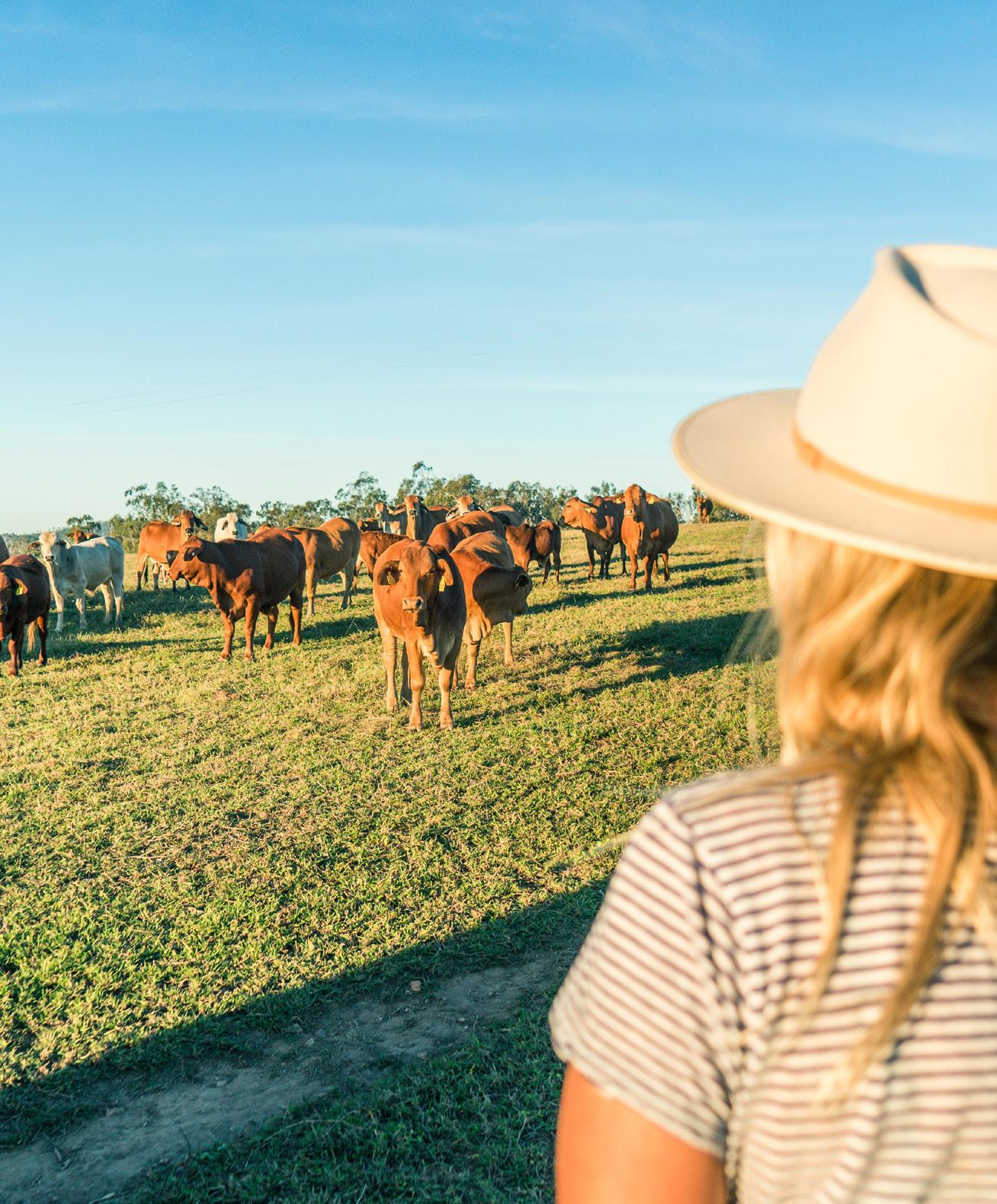
Own or operate a farm in NSW? Kickstart your agritourism business with Hipcamp. Earn money from your land. Start building an income stream through agritourism by welcoming guests, with Hipcamp. Hipcamp is Australia’s largest provider of unique outdoor stays, from campsites, glamping, cabins and more. It’s free to list your land. You set the rules and host when you want, all with Hipcamp’s $10 million insurance coverage behind you. START HOSTING TODAY host.hipcamp.com/nswfarmers or speak to Lisa Barnes Host Experience Manager 0488 856 706 lisa@hipcamp-land.com
Crying for Argentina
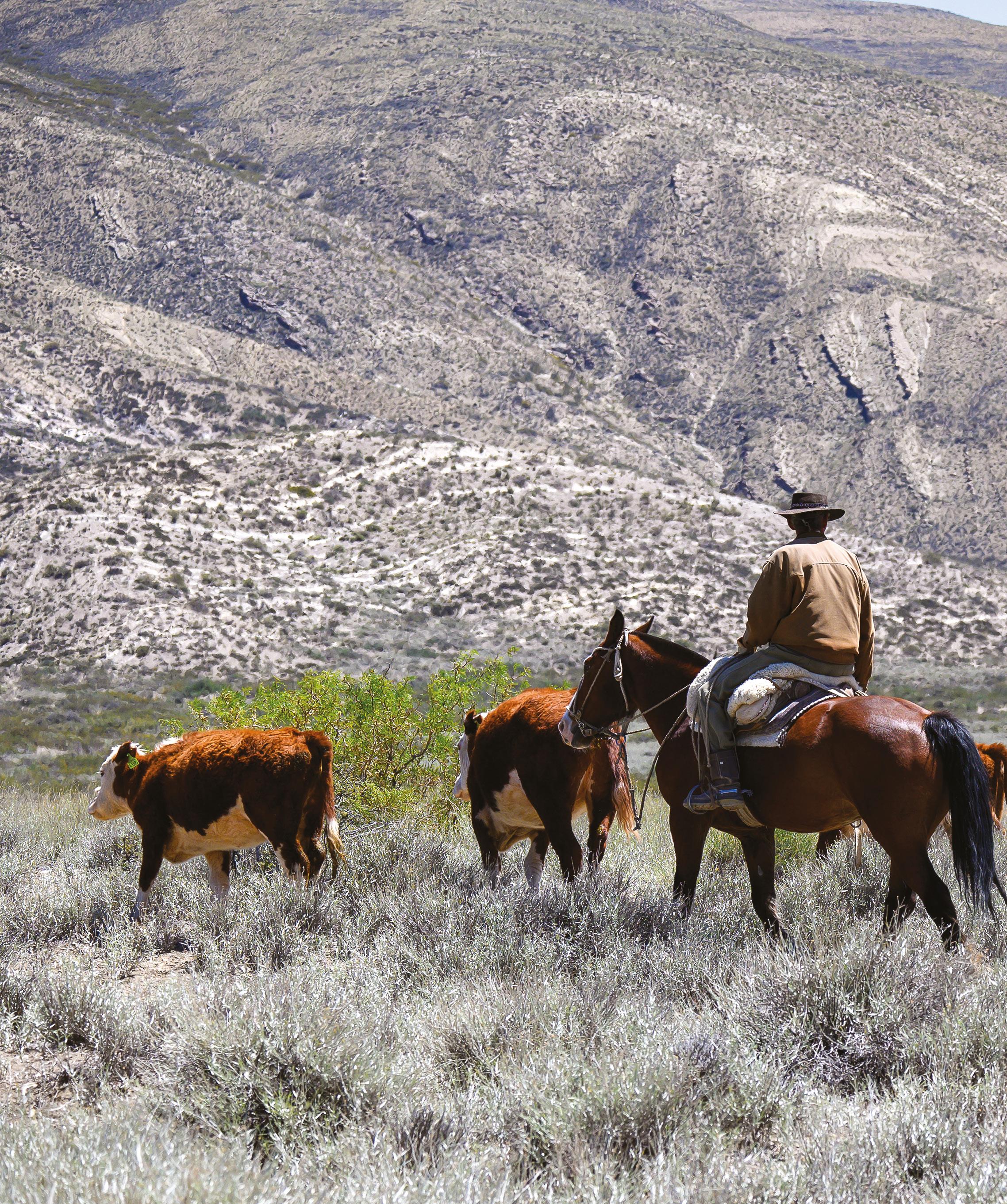
INTERNATIONAL
THE FARMER MAY - JUNE 2023 66
INFLUENCE ARGENTINA
Words IAN
Alongside Argentina’s broader economic crisis caused by decades of fiscal mismanagement and entrenched corruption – which saw inflation hit a three-decade high of 95 per cent last year – the drought is projected to erase 2.2 per cent of GDP this year, according to the Rosario Stock Exchange.
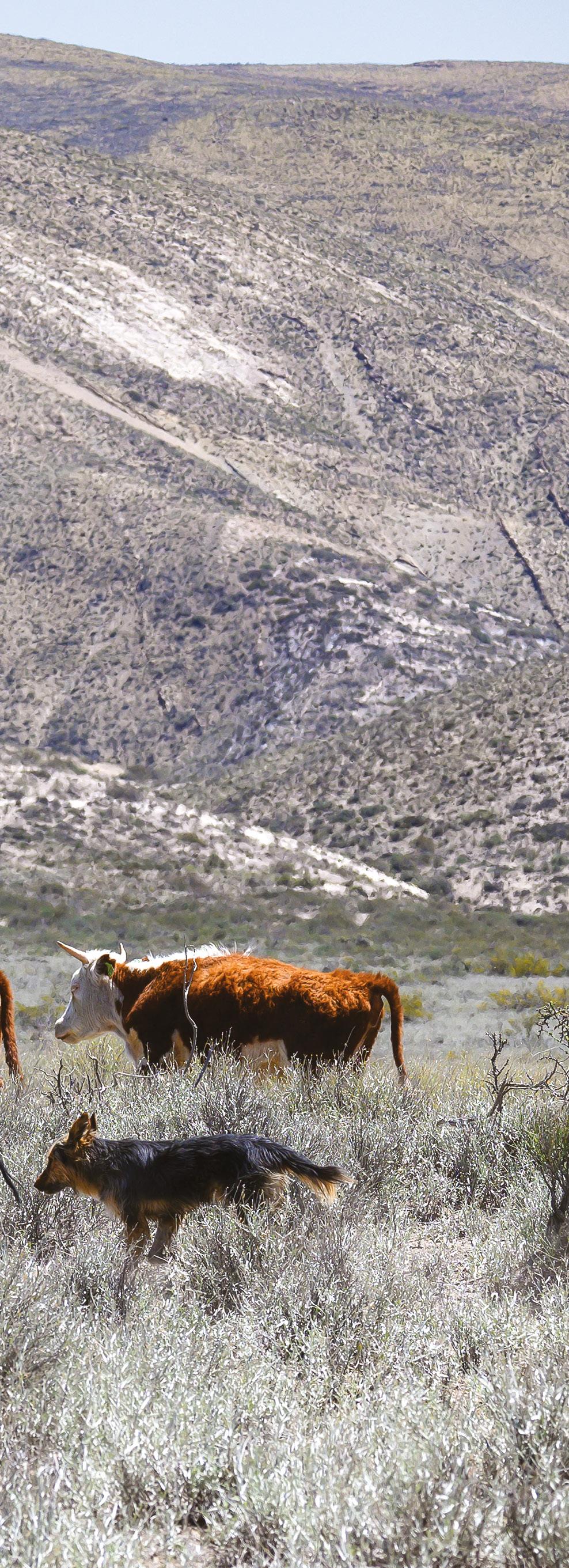
That translates to $21.5 billion in lost agricultural export earnings compared to 2022, when Argentina earned $86 billion in farm exports, predominantly from grains. Argentina is, or was, the world’s largest exporter of soybean oil and meal, the secondlargest exporter of corn and the seventh-largest exporter of wheat, lemons and limes.
In the ‘Pampa Húmeda’ (Humid Pampas), Argentina’s breadbasket, half of the soybean crop has already been lost due to drought. And while a fortnight of rains in late January will help limit losses, at least half of this region remains in drought as ongoing above-average temperatures unbalance the effect of rains.
“I am 48 years old, and this is the worst drought I have seen in my life,” wheat farmer Christian Olaizola
told Germany’s DW News . “We have seen precipitation levels decrease and decrease over the past three or four years, every year a little less. We had to farm our wheat with practically no water, maybe 5 or 7 millimetres of rain, not more,” he said, adding that he expects the harvest on his 80-hectare property to come in at one-third of usual levels this year.
Cristian Russo, head of estimates at the Rosario grains exchange, added in an interview with Reuters: “We have to prepare for the worst scenario for the last 20 years in this grain campaign of soy and corn. We are at a point where things look very complex.”
GOVERNMENT RESPONSE
Agriculture is one of the few bright spots in Argentina’s broken economy, accounting for nearly two-thirds of export earnings. As such, it is too important to fail. The government has introduced a raft of measures to ensure farmers will still have a roof over their heads when the drought finally breaks. Argentina’s central bank is offering farmers more flexible terms on the non-payment of loans and subsidised lines of credit. It has also opened a small relief fund worth $38 million for farmers, and announced the suspension of advance income tax payments in
As farmers in Australia deal with three successive years of La Niña, farmers in Argentina are grappling with the opposite: a triple serving of El Niño that is generating some of the hottest temperatures and driest periods the South American country has recorded in 60 years.
>
NEUBAUER
“That’s why they introduced export bans in the first place. Beef is such an important part of their culture that the population would not bear any significant price rises.”
–
MAY - JUNE 2023 THE FARMER 67
ANDREW COX General Manager for international markets at Meat & Livestock Australia
(MLA)
addition to tax exemption for beef farmers who undersold cattle due to a lack of affordable feedstock.
But at the same time, it is also making things harder for farmers by extending a partial ban on beef exports to ensure continuity of inexpensive domestic supply.
According to the US Department of Agriculture, Argentina is the sixth biggest beef producer in the world, accounting for 5.19 per cent of global production. Australia, in eighth position, accounts for 3.28 per cent of global supply. However, most of our beef is produced for export (72 per cent) whereas in Argentina, 71 per cent of beef is consumed domestically.
It’s not because they have a population nearly double the size of ours. It’s because Argentinians eat more red meat than any other country on the planet: 39.9 kilograms per person per year, compared to 19.2 kilograms in Australia.
“That’s why they introduced export bans in the first place. Beef is such an important part of their culture that the population would not bear any significant price rises,” explains Andrew Cox, General Manager for international markets at Meat & Livestock Australia (MLA).
Introduced in May 2021 as a blanket embargo on a quarter of total beef production exports, the bans had an immediate negative impact, with exports dropping by 36 per cent. Yet the following month, it was announced that only certain cuts would be banned and that restrictions would not apply to highquality cuts destined for the EU, nor to quotas set for the US and Colombia. In October that year, the export cap was lifted for China, which accounted for more than two-thirds of exported volume the year before.
HUNG OUT TO DRY
Three successive years of El Niño has produced some of the driest conditions Argentina has ever experienced in an already struggling economy. Efforts to reduce pressure on farmers include a tax exemption for beef farmers who undersold cattle due to a lack of affordable feedstock.
The current ban, which has been extended until the end of 2023, applies to seven cuts popular with the domestic market, as well as whole and half carcasses.
NOTHING TO SEE HERE
Most economic changes produce winners and losers, and that maxim also applies to changes in trade. This begs the question: is there an opportunity for Australian farmers to help fill gaps in the global markets created by Argentina’s drought and export bans?
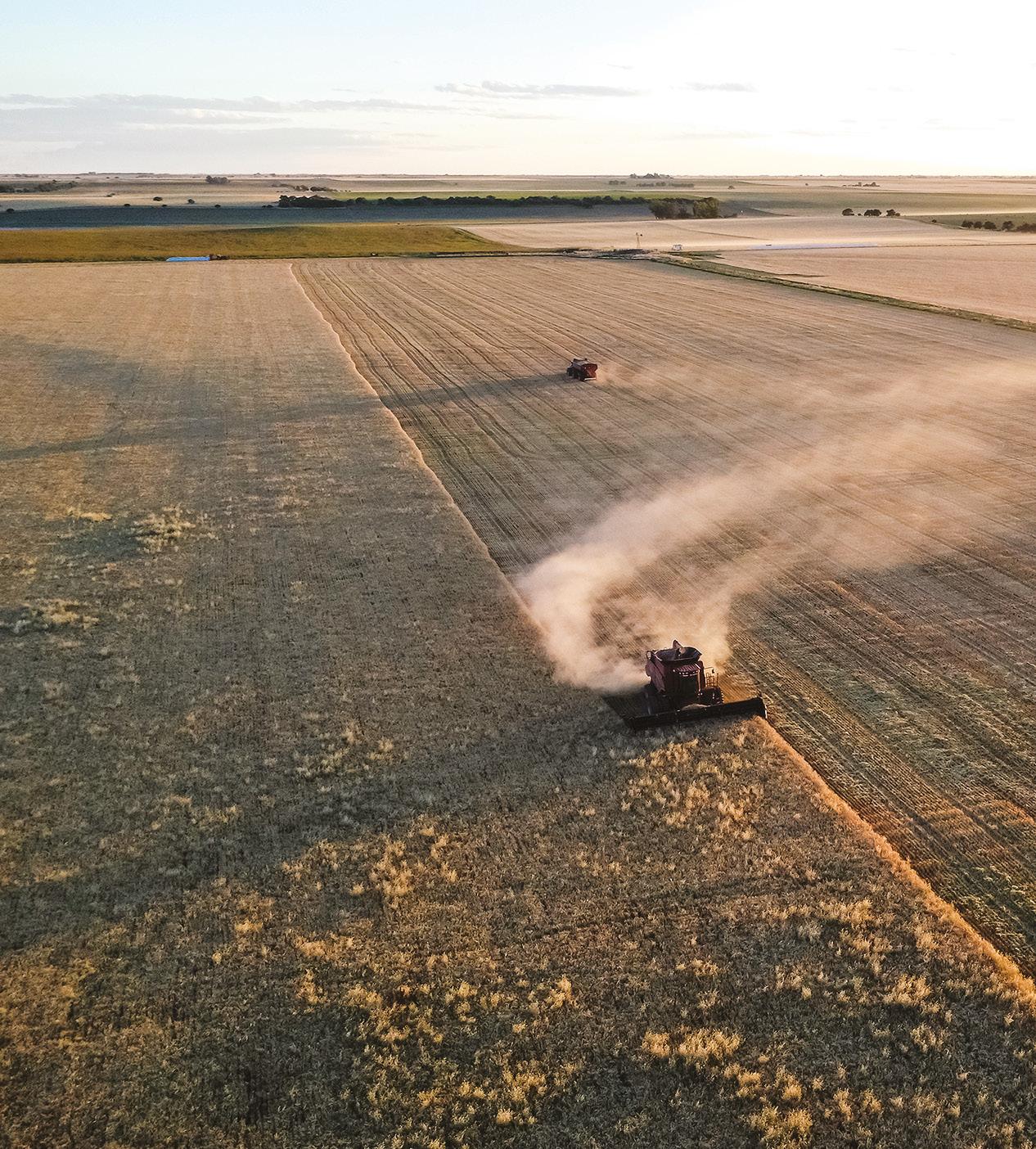
The short answer is no, and you only need to look more closely at two major Argentinian commodities to see why.
“The total size of the global soybean market is about 360 million odd tonnes per year, and Argentina and Brazil account for about 100 million tonnes between the two of them,” CEO of the Australian Oilseeds Federation, Nick Goddard, says. “Australia only grows 50,000 tonnes, so when you put us in the global context, we don’t even register.
“Most of the soy we produce are varieties suited to foods like soy milk, tempeh and tofu – and
INTERNATIONAL INFLUENCE ARGENTINA
THE FARMER MAY - JUNE 2023 68
“Also keep in mind that Argentina exports most of its beef to China, and even then it’s just a drop in the ocean. Let’s not forget the political environment in China has seen suspensions put on several major beef producers in Australia. In the last two years, our exports to China have shrunk and they’re unlikely to grow until the political issues are resolved.”
nearly all of it is consumed domestically. We do have opportunities to grow soybeans for export into Southeast Asia where we have a good point of difference as our soybean is purely non-GM.

“But at the end of the day,” he explains, “it’s an opportunistic crop for us. If the price of sugar is low, sugar cane farmers in the Northern Rivers region will plant some soybeans as it works well as a rotation crop because the price of water there is currently low. But when water becomes more expensive, it will make more sense to plant cotton or rice.”
“What is happening now in Argentina,” he says, “is because of seasonally dry conditions. And as soon as it gets wet over there it will become dry here. So I do not see any real opportunity for Australia to become a major exporter.”
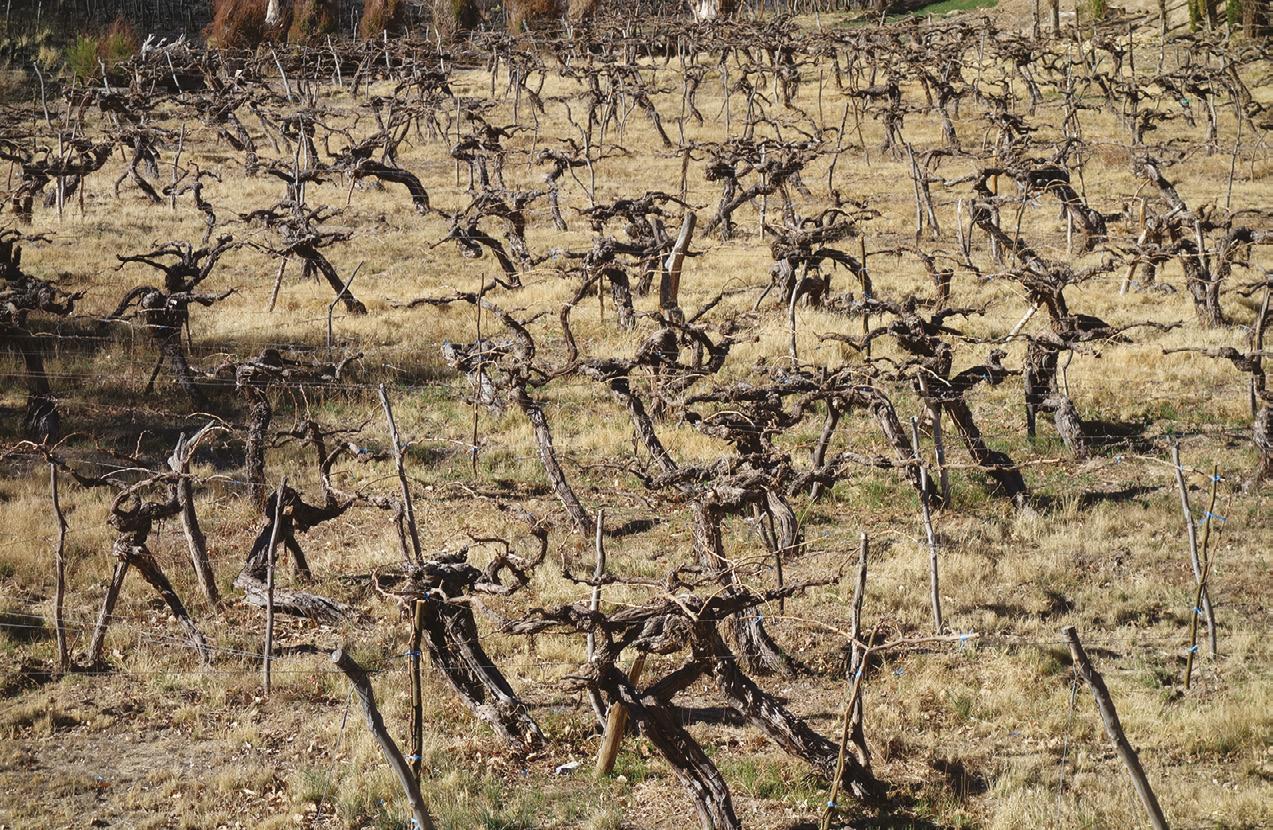
But what about selling the world some of the beef that Argentina cannot – a trade Australia excels in?
“Given the type of product Argentina exports and the price it sells it for, the gap in the market would be picked up first by other South American producers like Brazil,” says Andrew.
“Also keep in mind that Argentina exports most of its beef to China, and even then it’s just a drop in
GAP IN THE MARKET
Argentina’s export ban on beef production for 2023 means there is now a gap in the global market. However, Australia is in no position to fill it due to a focus on diversifying our exports and avoiding overreliance on any single market, such as China –Argentina’s main export market.

the ocean. Let’s not forget the political environment in China has seen suspensions put on several major beef producers in Australia. In the last two years, our exports to China have shrunk and they’re unlikely to grow until the political issues are resolved.”
Even if that were not the case, the MLA doesn’t believe it makes good business sense to sell more Australian beef to China.
“The story for the last couple of years for Australian agriculture has been about diversifying our exports to avoid over-reliance on any single market like China,” Andrew says. “Australian beef exports have already been well-diversified compared to other commodities like wine and barley. Our focus is growing markets like India, South Korea and Japan, and the MLA has now got people on the ground in Saudi Arabia, Vietnam and Thailand. So, I do not see how events in Argentina will result in any large quantifiable opportunities for Australian beef.”
l MAY - JUNE 2023 THE FARMER 69
Co-investing in
NSW Farmers has put the Farm Innovation Fund (FIF) in the spotlight as a key measure in building drought resilience through co-investing with farmers in farm infrastructure and natural resource management.
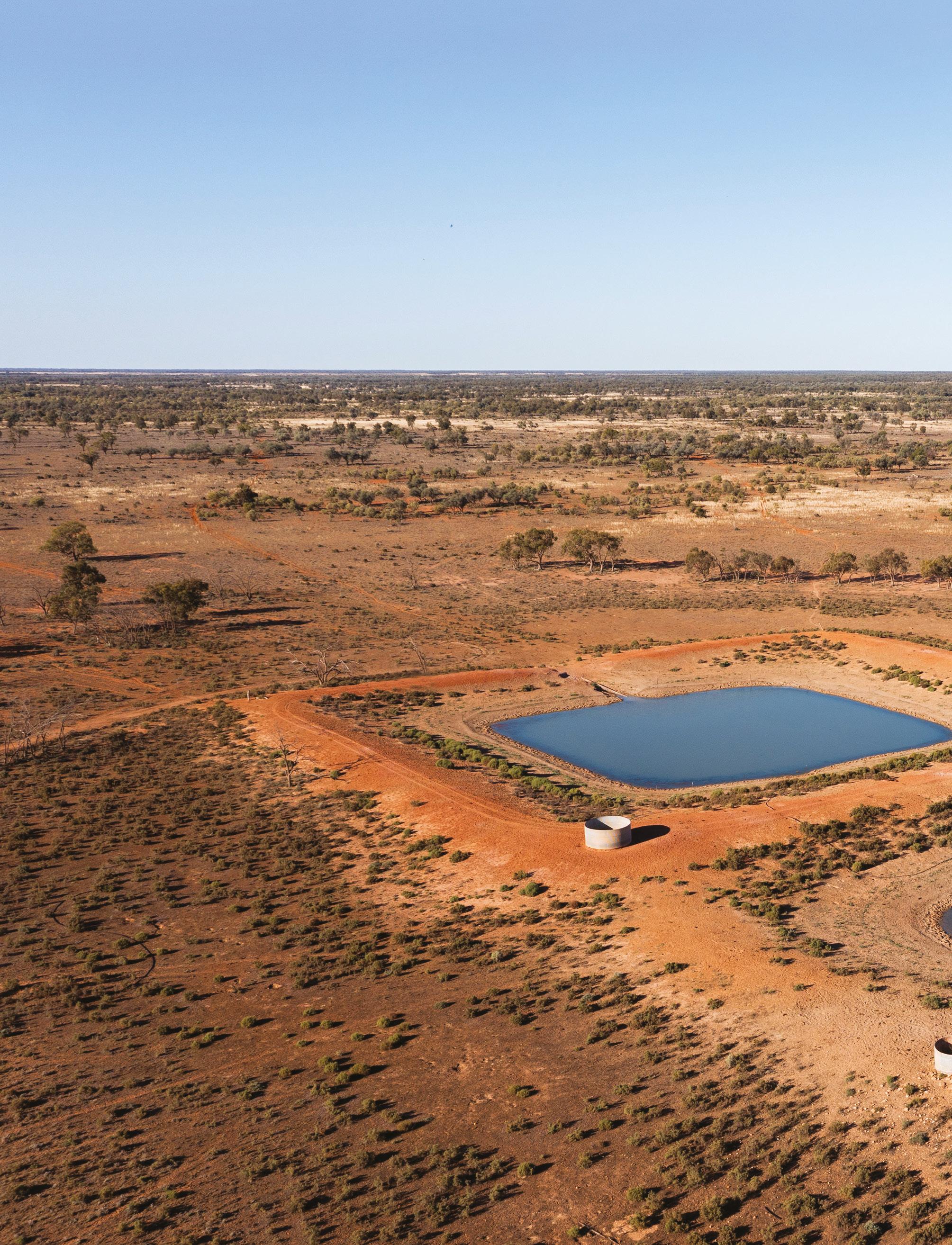
The new Labor government did commit to supporting the FIF during the campaign, but have not provided any pledges yet to bolster its balance, which is $169,622,050.
The fund, which is managed by the Rural Assistance Authority (RAA), was last boosted in 2020 with $350 million following NSW Farmers’ advocacy, making it into a $1-billion-dollar fund.
The RAA has issued $840 million to farmers and seafood producers since the fund’s inception in 2014.
NSW Farmers Policy Director Kathy Rankin said farmers had used the FIF to identify and address risks to their farming business, improve permanent farm infrastructure, and adapt to changes in seasonal conditions.
“Farm businesses need to be profitable to survive, but they are abnormally exposed to external factors such as climate variability, high energy and input costs, and labour availability – many of which have come to a head over the past year,” Kathy said.
INNOVATION
FARM INNOVATION FUND
> 70 THE FARMER MAY - JUNE 2023
farm innovation
The new Labor government will be hearing a lot from the NSW Farmers team about the importance of the Farm Innovation Fund when it comes to feeding the future of the state.
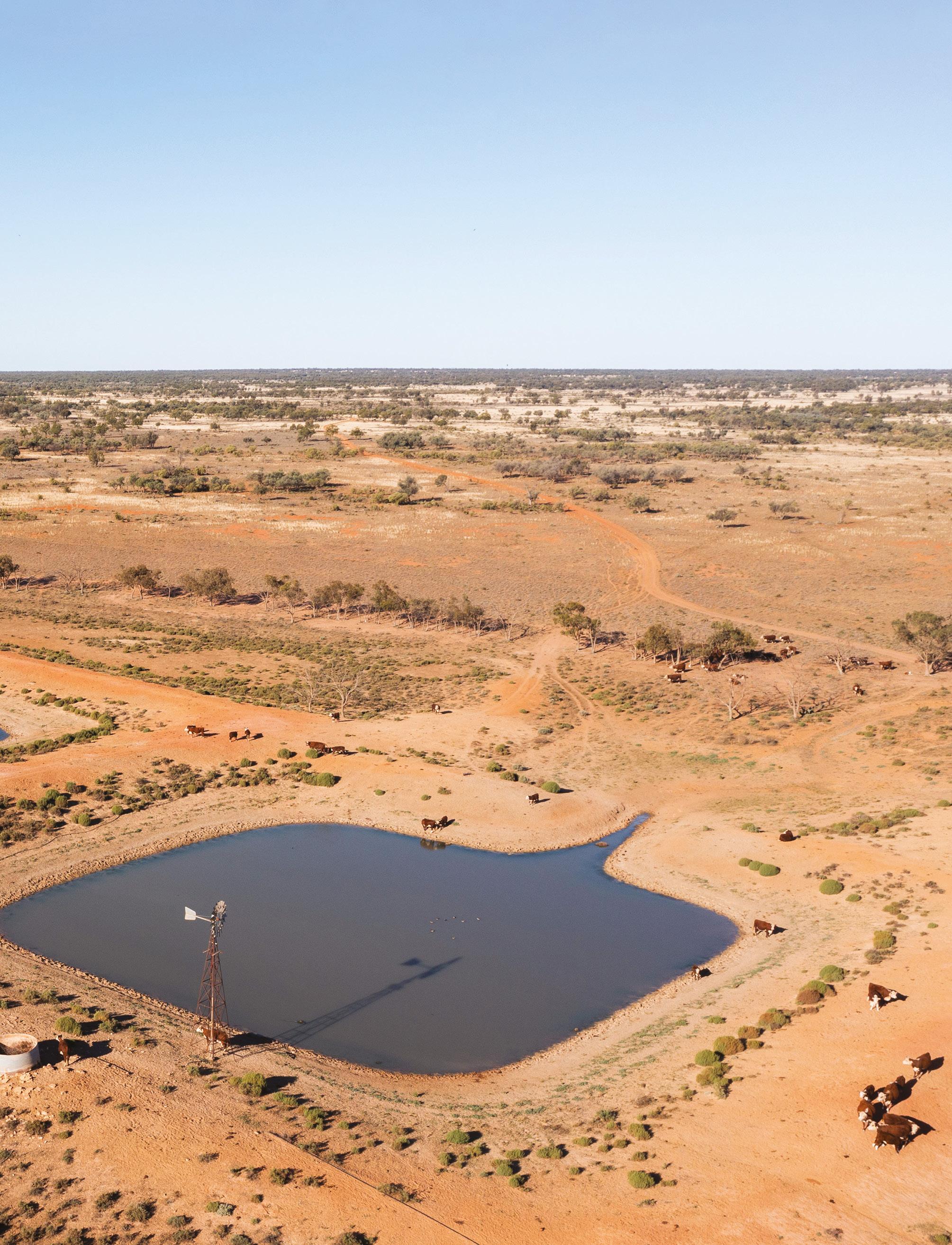 –
Words MICHAEL BURT
–
Words MICHAEL BURT
MAY - JUNE 2023 THE FARMER 71
INNOVATION NATION
The Farm Innovation Fund is a long-term, low interest rate loan scheme for NSW farmers for permanent on-farm infrastructure. The new Labor government committed to supporting the FIF during the campaign, but have not provided any pledges yet to bolster its balance, which is $169,622,050.
“The fund is about government partnering with industry to strengthen their farm business operations and growing the food and fibre that feeds and clothes us.
“Allowing for small improvements to cut costs or to expand key operations will improve productivity, efficiency and supply chain management.
“We know that every dollar invested in boosting farm productivity delivers a dividend of $12 for the economy.”
WHAT IS THE FARM INNOVATION FUND?
The Farm Innovation Fund is a long-term, low interest rate loan scheme for NSW farmers for permanent on-farm infrastructure.
Farmers can borrow up to a maximum of $1 million per project, with a total of $1 million outstanding at any one time to build on-farm infrastructure
to improve farm business resilience and natural resource management.
The repayments currently stand at an interest rate of 2.5 per cent, and can be repaid over a maximum of 20 years, depending on the applicant’s ability to pay. All works must be completed within 12 months of the loan approval.
It has four main categories for eligible projects: drought preparedness, environment, farm infrastructure and natural resources.
Eligible projects under the drought preparedness include stock and domestic water supply, capping and piping of bores in the artesian basin, refurbishing ground tanks and planting of perennial species.
TAPPING INTO WATER SECURITY AT HAY
Hay district sheep producers Mark and Michelle Schiller used a co-investment with the Farm Innovation Fund to install a drought-proofing pipeline and stock watering system.
The Schillers produce wool and lamb from Merinos and Dorpers on their 12,000-hectare property, Woolamie, 50 kilometres west of Hay. The generational family farm is on a floodplain and traditionally used a channel scheme off the Murrumbidgee River to fill eight dams once a year.
More than 25 kilometres of poly pipe installed in 2020 has transformed the property and vastly improved livestock water security and confidence to face the next drought.
While there has been water aplenty in the last two years with above-average rainfall and floods,

INNOVATION FARM INNOVATION FUND
“We would normally run about 2,500 Merinos and 5,000 Dorpers, but we had to reduce carrying capacity to 2,500 Dorpers and 500 Merinos due to the impact of drought.”
THE FARMER MAY - JUNE 2023 72
–MARK SCHILLER Sheep farmer, Hay
Mark said the project was a must for the farm’s long-term sustainability.
“We went from full-on drought to having two floods in the last two years. It’s been frustrating, but we’re getting through it,” Mark said.
“We would normally run about 2,500 Merinos and 5,000 Dorpers, but we had to reduce carrying capacity to 2,500 Dorpers and 500 Merinos due to the impact of drought.”
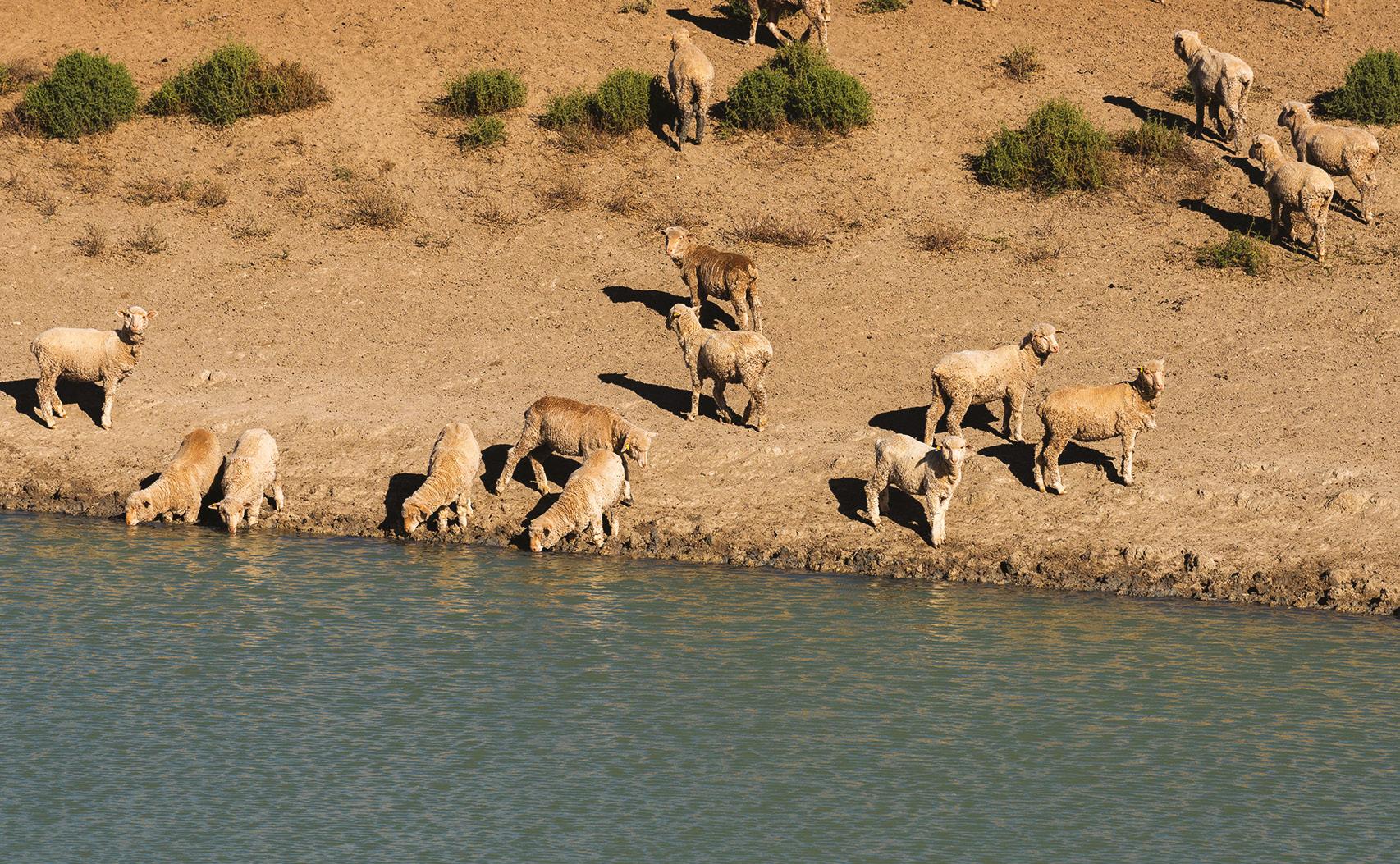
Floods in the last two years held back Mark’s flock rebuilding phase, but he says numbers are now back up to 3,000 Dorpers and 2,500 Merinos.
“It has been hard to find fresh paddocks for the sheep,” Mark added. “We moved sheep up to near Adelong on the Lachlan, and then it flooded up there
RESILIENCE AND REASSURANCE
Mark and Michelle Schiller used a co-investment with the Farm Innovation Fund to install a droughtproofing pipeline and stock watering system, which will help with farm efficiency and drought resilience. One of the main benefits it has brought is reassurance.
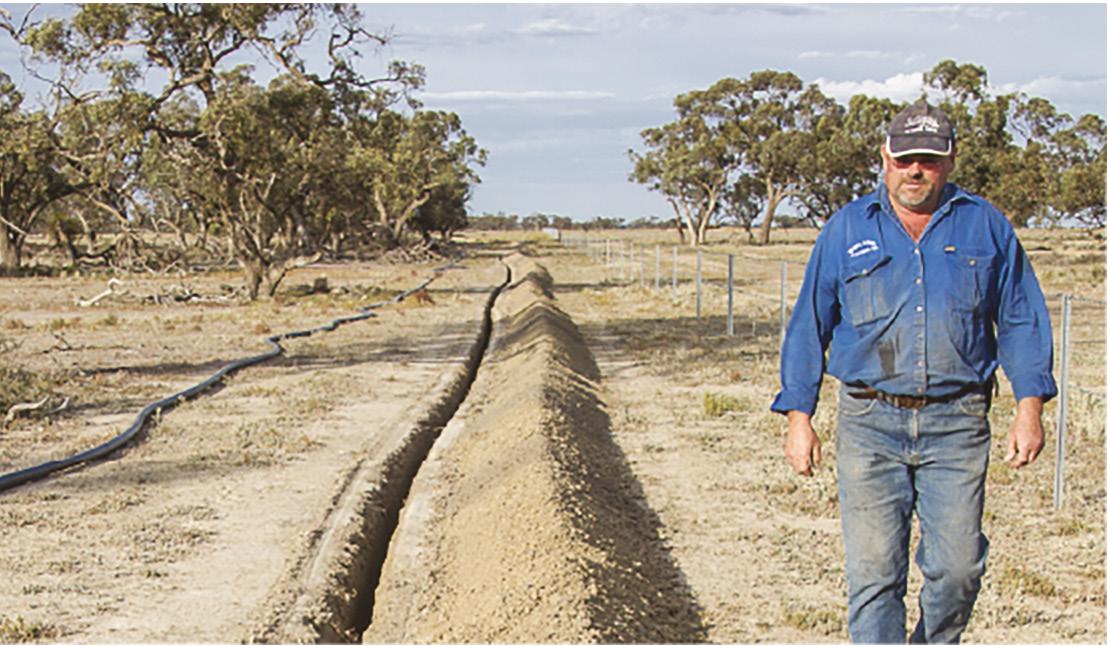
too, so we had to bring them home.
“Now we have a tonne of feed. We also had a lot of summer rain – which we don’t like – but it finally warmed up and the dams are still sitting at 80 per cent.”
The third-generation farmer said the $150,000 Farm Innovation Fund loan used to purchase the pipeline and watering system would more than pay for itself through improved farm efficiency and drought resilience.
“Security of water supply will be the key benefit,” Mark says. “With the addition of solar pumping, it’s nearly foolproof in knowing that you can get water into the dams anytime.
“If there is no stock in the paddock, we don’t need water, and if there is stock, we can make sure water is available. It’s a very reassuring feeling, and it means we don’t have to move or sell stock because of a lack of stock water in a paddock anymore.
“At least next time we don’t have to panic as much. With the pipeline, stock and domestic water is always available.
“We can also manage our grazing system the way it should be managed, without being disrupted by any stock water shortages.”
The Schillers have also invested in a small on-farm feedlot to finish lambs and capitalise on a strong market for sheep meat. They also diversified into growing barley last year.
“It has been viable to finish lambs with grain,” Mark says. “It has worked out well in helping the farm business recover from the drought.” l
MAY - JUNE 2023 THE FARMER 73
Looking up in Cowra
These three farmers from the Cowra region have survived years of significant rain, Covid-19 restrictions, and skyrocketing interest rates and inflation. So, what are they are doing now to prepare for the future?
Words NANNETTE HOLLIDAY

COMMUNITY LOCAL FARMERS
–
THE FARMER MAY - JUNE 2023 74
FORWARD PLANNING
The Amos family have been farming in Cowra for 103 years.
“We’ve added to my great grandfather’s original property, ‘Rockdale’, and today, along with my children, we own 1400 hectares, lease 250 hectares and operate share farming on another 100 hectares,” says fourth-generation farmer Gary Amos.
Gary grows wheat, oats, barley, canola and lupins and runs 2,500 sheep and 100 head of cattle on his property ‘Yurilla’. But there’s no irrigation. Yurilla has two dry creeks that only flow with persistent heavy rain.
“During the last three years, we’ve replenished our hay supplies for the next drought, as they always come around. The early 1980s and 2019 are the worst I’ve experienced. In 2019, the crops weren’t worth harvesting and the paddocks were bare earth. We let the sheep eat off the crops.”
Gary has always planned six to 12 months ahead and stores all the grain on the property. It was their savour in 2019. During 2020, he constructed three underground silage storage units into the hills on the property. Over 1,000 big bales are now stored there. That’s a lot of feed when you compare it to a semi-trailer which holds 40 bales.
“We still have our above-ground hay sheds, but the silage stock is safe from floods, fire and mice plagues,” says Gary. “I’d always wanted to build silages, and now we’re ready for the next big drought.”
The family also uses their equipment for contract work on neighbouring properties and sells all the canola they grow.
“Canola yields were astronomical in 2021/22, and prices were at an all-time high. When Covid-19 closed fertiliser factories or minimised production, our fertiliser costs doubled. Machinery and parts were also affected. Now our hurdles are interest rates and inflation. But somehow, we survive. For our family, it’s always been forward planning and being ready.”
WATER SAVING LINES
Born between Yass and Goulburn, Peter Hinds was the last of six children. Ineligible for the family property, he moved to Canberra and established a building company. But the ties to the land were too strong. Between 1975 and 1996, he bought several adjoining properties halfway between Cowra and Boorowa.
Today, it’s all named after the last property he bought – ‘Bonanza’. Combined, it’s a 1300-hectare sheep and cattle property.
Peter Hinds (below) running repairs on Bonanza’s granite hill country. The 1,300-hectare property was originally bought by the Cartwright family after a lottery win, which is where it got its name.
>
 A BIG WIN
A BIG WIN
MAY - JUNE 2023 THE FARMER 75
“Bonanza was originally owned by the Cartwright family, who bought it after a lottery win,” says Peter. “But those old enough think its name is a play on the television show.”
Peter says the most significant hurt, along with other earnest sheep farmers, was the government’s removal of the Reserve Price Scheme in 1991, which provided guaranteed wool prices.
“It worked well during the 1980s. But when they stopped the program abruptly, prices dropped almost 80 per cent. The government then imposed a levy on us to pay off the debt. I reintroduced cattle and have continued to run both using super application and pasture improvement programs across the property since.”
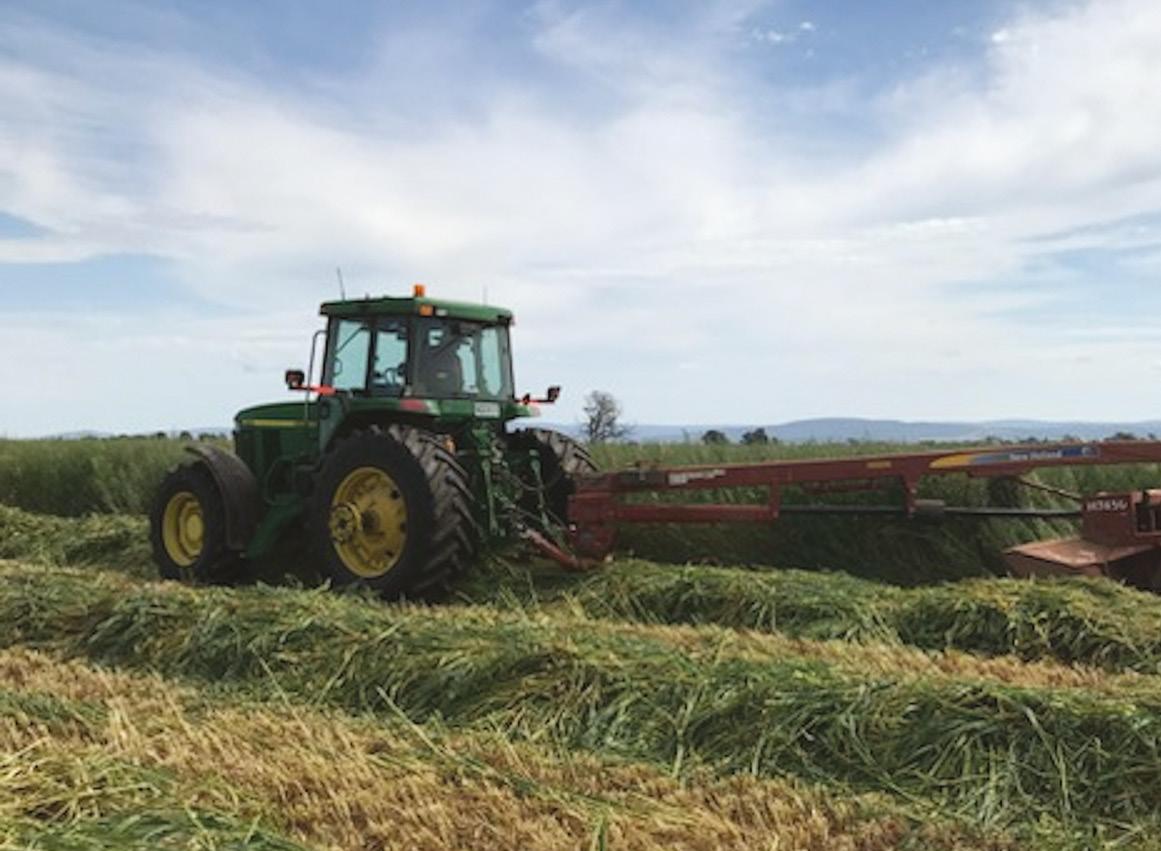
While Peter lives on an acreage closer to Canberra, he remains firmly hands-on at Bonanza, running 3,000 merino sheep and 400 Angus Hereford Black Baldy cross cattle. It’s granite hill country down to the Boorowa River flats with a license to pump water.

“My building business has always supported property improvements and infrastructures. After the early 1980s drought, with only a tank left in the bull yard before the rains came, I vowed to fix that problem.
“Over time, I bought an excavator and installed over 14 kilometres of pipeline and 35 troughs because most of the ground is porous. I’ve now got dual water in all the paddocks. It’s a vastly different property from what I bought.
“The property and waterlines can even be divided into two properties and still work successfully if my two sons don’t get along when they take over in a few years.”
INGENUITY AND FLEXIBILITY
After owning a 2,025-hectare property running 5,000 sheep in Barraba near Tamworth for 25 years, Richard and Florence Statham wanted a complete change and a property with a reliable water supply. Along with Florence’s parents from France and their two sons, they established ‘Rosnay’ – a certified organic farm and winery – in 1995.
Situated between Cowra and Canowindra on the Belubula River, they planted 20 hectares of vineyards, 2,500 olive trees and 110 fig trees. They also operate a cellar door, farmstay and glamping accommodation and, through the ingenuity of their son Sam, created the River Road Organic Farms project, a subdivision of 10 privately owned, community-titled farms.
“It took four years before the first block sold,” says Sam. “Most owners come from non-farming backgrounds, and we provide all sorts of assistance to each other. It’s created a wonderful community spirit and assisted us in developing the winery and planting more wine grapes, olives and figs.”
Today, their organic, solar-powered property has two houses, a workshop, strawbale winery and cellar door, all connected to a solar and battery microgrid. They produce chardonnay, shiraz, rosé,
COMMUNITY LOCAL FARMERS
“Most owners come from non-farming backgrounds, and we provide all sorts of assistance to each other. It’s created a wonderful community spirit and assisted us in developing the winery and planting more wine grapes, olives and figs.”
–
SAM STATHAM
THE FARMER MAY - JUNE 2023 76
Creator of River Road Organic Farms
fortified wine, as well as dried and bottled olive and fig products sold online and through the cellar door.
“We made the fortified wine from the 2020 bushfire smoke tainted rosé. It’s extremely popular,” says Sam. “The fires were 200 kilometres away. Fortunately, nothing else was affected. During the 2010 and 2019 droughts, our bore kept us going.”
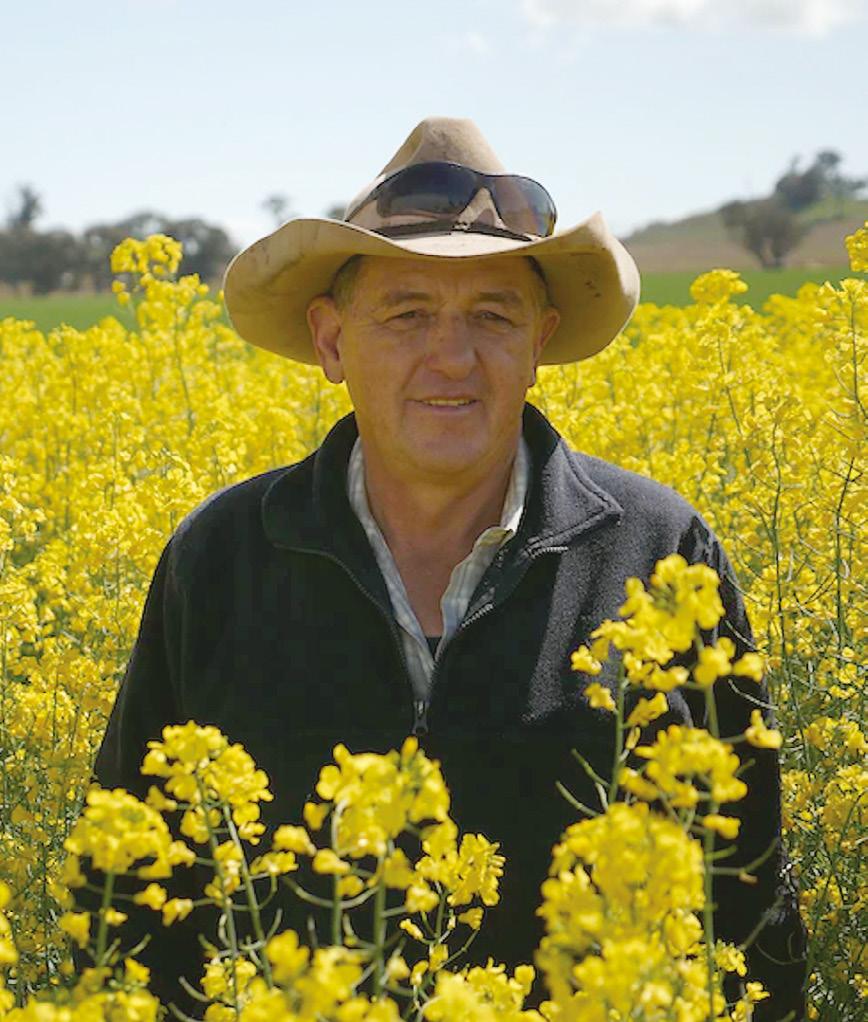
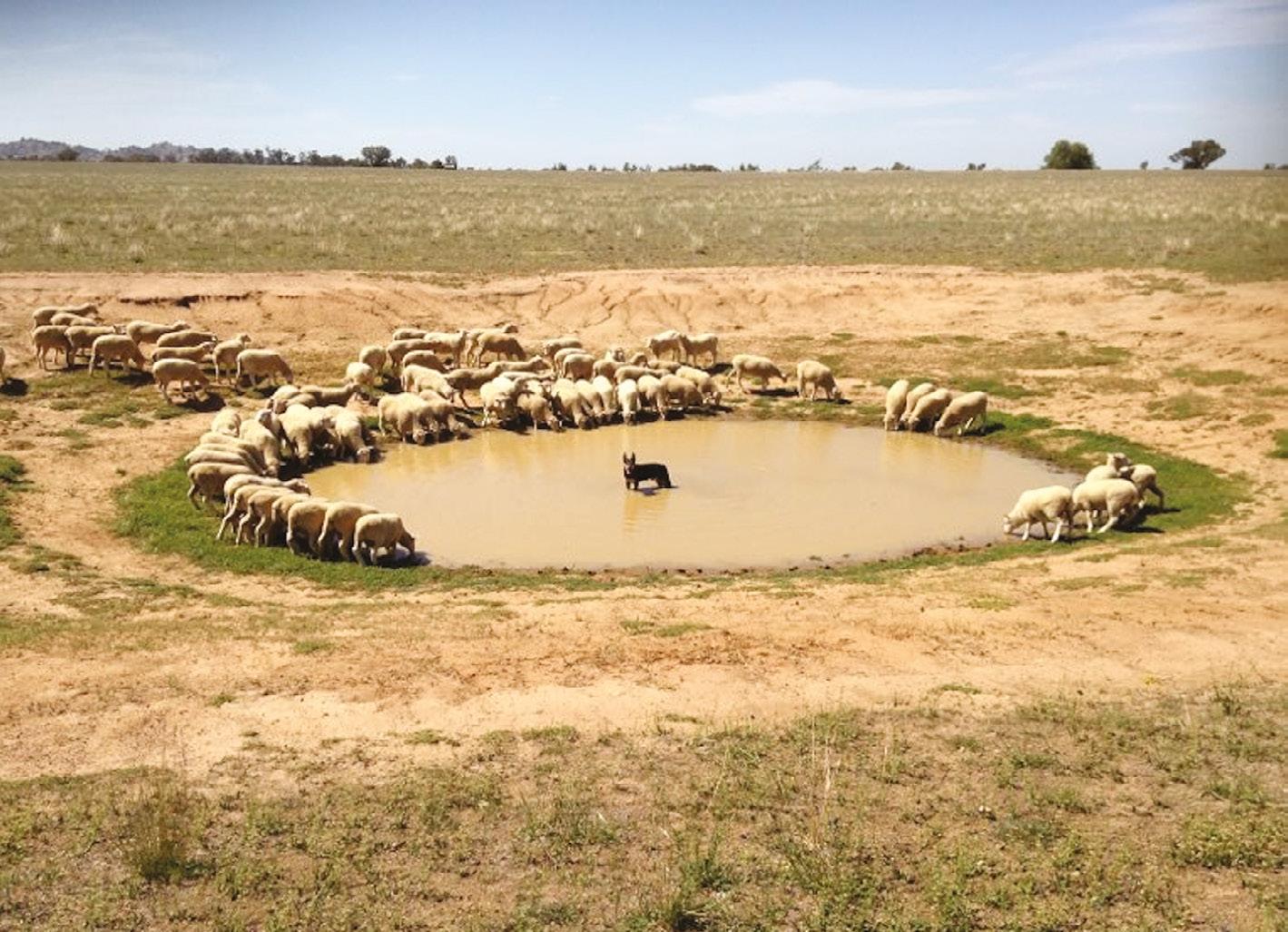

When Covid-19 halted accommodation and cellar door operations, they used the space for production storage. When tourism activities resumed, they turned the 1970 workshop shed into the new cellar door.

“It’s better than before, with sweeping views, strawbale walls and recycled timber adding to its
FARM LIFE
Top left then clockwise: Cutting oats for silage bales at Yurilla; (L-R) Simone Statham, Shaun Lawlor, Mark Gardner and Sam Statham at Rosnay (Image: Stuart Walmsley); Gary Amos in his canola fields; Sheep at manmade waterhole at Yurilla; Cattle grazing at Bonanza.
aesthetics. There’s a dedicated tasting room, and the space is ideal for events, art exhibitions, concerts and more,” Sam says.
However, the effects of inflation and interest rate rises on the community are hitting them harder.
“While online product sales are steady, we’ve had few visitors since Christmas. People are tightening their spending. Businesses in Orange are experiencing the same. So, we’re focusing on exporting wine, establishing a wine rewards program and more events.
“It’s a case of remaining flexible. With our next generation growing up, we’ll see what they want to do too.” l
MAY - JUNE 2023 THE FARMER 77
WATER AND WALNUTS
Peter and Katherine Herrmann are forging another century of farming in the Riverina for their six sons through innovations in water-use efficiency and a bold move to plant 135,000 walnut trees.
Peter’s family has farmed in the Yanco and Murrami district since the Murrumbidgee Irrigation Area (MIA) was established in 1912. Their farming journey started with rice cropping, which continues to this day alongside cereal cropping and a 4,000-strong flock of Merino cross sheep.
With the help of their six keen young farmers, the Herrmanns continue to invest in improving rice, wool and lamb production as staples in the farming mix.
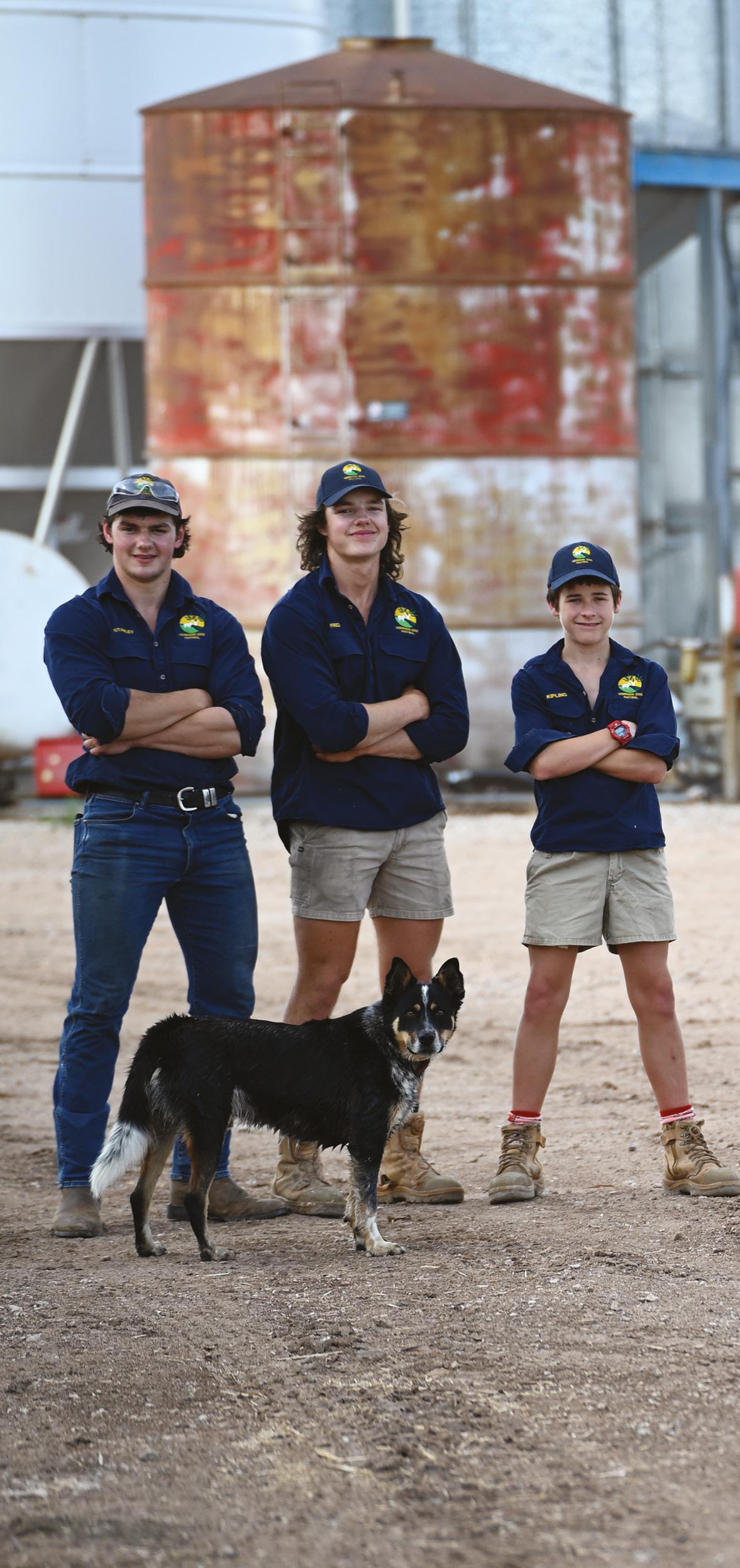
Peter said Australian rice had become increasingly important for overseas markets in a world still reeling from inflation and supply chain issues.
“The world wants our rice,” Peter says. “We exported rice to California last year. Our markets in the Middle East and Europe are also calling for our rice, and the strong rice price reflects that demand.”
Peter, who is President of the Ricegrowers Association, said despite the wet conditions last year, Riverina farmers are tipped to meet that demand with a bumper harvest in April.
“We sowed 80 hectares of rice on our farm in the first week of October. The weather conditions precluded us from putting in more within the planting window.
“It’s a medium grain variety and despite the late start, the crop looks terrific, and it will be a good harvest. We are pinning our hopes on an above average harvest of up to 14 tonnes per hectare.
“The varieties that we have available to us now means rice is one of the few summer crops that can take advantage of later sowing windows.”
COMMUNITY NEW GENERATIONS
Walnuts are the latest addition to the local food and fibre mix that is feeding the future of farming for the Herrmann family at Murrami.
Words MICHAEL BURT
>
Photography JESSICA VANT
BOYS WILL BE BOYS
The Herrmann family (L-R): Stanley, Fredrick, Kipling, Peter, Katherine, Barney, Indigo, Oswald and Wilson the dog.
THE FARMER MAY - JUNE 2023 78
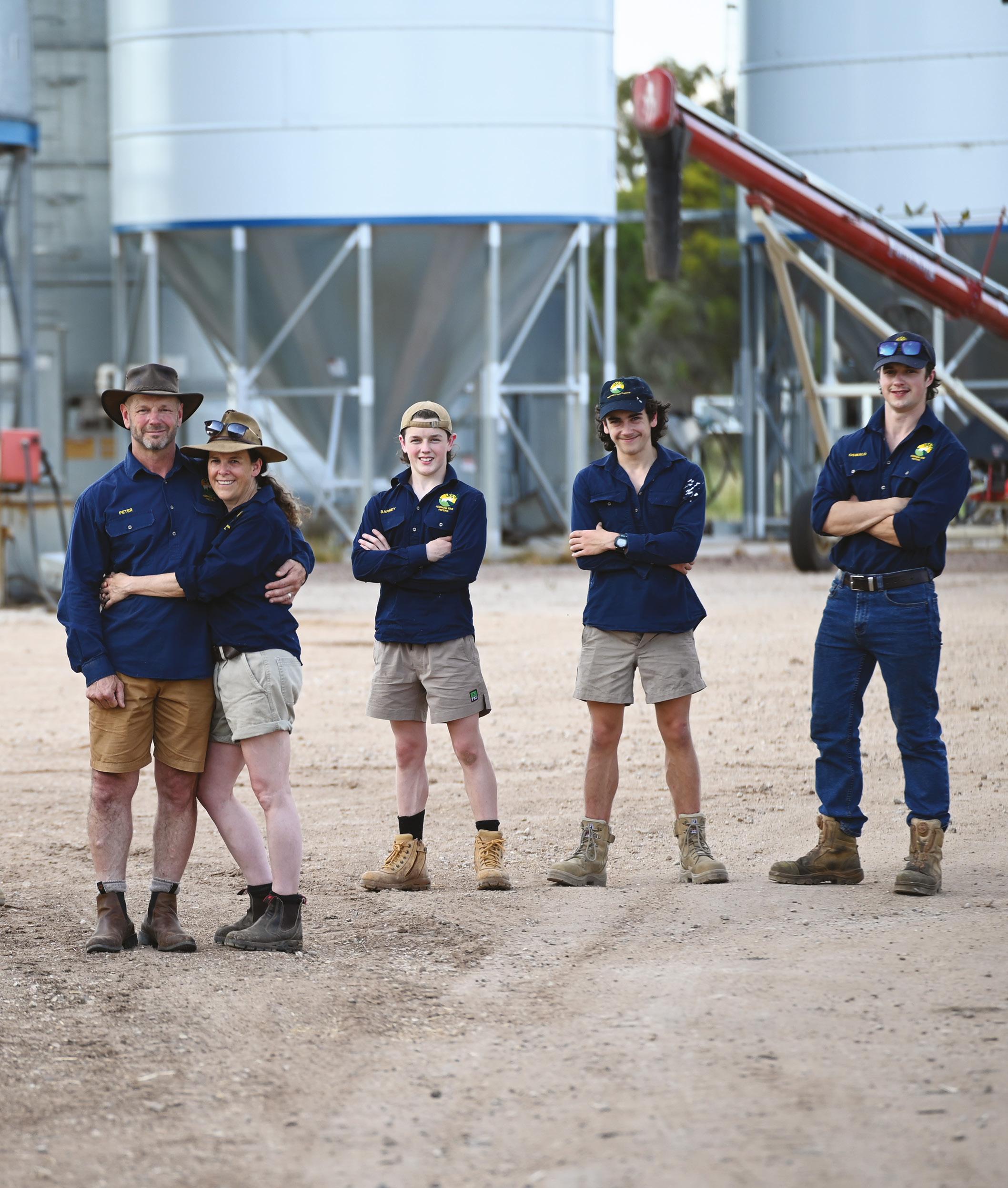
“There were a lot of unknowns when we started. It has been a real team effort to get it to where it is today, and found lifelong friends along the way.”
MAY - JUNE 2023 THE FARMER 79
Peter Herrmann
A BIG FRIDGE AND WALNUTS
Raising six sons meant having a big fridge and a plan to diversify the farm business to secure a sustainable future of local food and fibre production.

The fridge was affordable, but Peter and Katherine’s idea to venture into a commercial walnut orchard in 2015 required outside capital and investors.
“Katherine and I explored a number of options to diversify the farm business, keeping in mind that it had to be the best and most efficient use of our water,” Peter says.
“Walnuts came out on top. They don’t need a pressurised irrigation system and respond to a surface capillary irrigation system.
“It’s particularly effective with walnuts and their type of root system in our country. It’s all gravity fed, so we are also reducing our carbon footprint in terms of energy use.”
The Herrmanns undertook soil amelioration with cropping regimes and gypsum before planting the trees. The orchard’s soils are regularly topped up with chicken manure from nearby poultry farms and gypsum.
Peter said the trees have flourished and produced their first commercial crop of walnuts in 2021, yielding 130 tonnes.
There are now 135,000 trees spread across 580 hectares that Peter hopes will yield 3,000 tonnes annually when in full production, making it the second-largest walnut orchard in Australia behind one of their neighbours, Stahmann Webster.
Peter said a secure and efficient water supply has been key to the success of the Duxton Nuts plantation.
“We needed a modern irrigation system that was recordable – so we can pull out a spreadsheet and say, here’s what’s been applied and how.
“We also needed benchmarks and institutional-grade reports on our walnut production to provide to investors.”
The Herrmanns partnered with Murrumbidgee Irrigation (MI) to develop the reliable, recordable, and controllable supply of water to the walnut trees, and introduced automated irrigation technology.
“It is mostly operated remotely. The technology and equipment we have today really maximises water use efficiency.
“We are one of the few horticultural enterprises that operate on this type of irrigation system.”
MI worked with the family to address the odd-shaped blocks dating from soldier settlement days, resuming MI easements and unused channels.
Almost 40 Australian Family Offices
are invested as ‘Duxton Nuts’. Peter and Katherine remain the largest shareholders, are Operations Managers and Directors in a professional team.
“It’s impossible to offer production security without that reliable supply of water. We had to be investor-ready for the family businesses that were buying into our business.”
“The investors are real people with real families who have a vested interest in what we are doing, and that has allowed us to grow. It’s something we are very proud of.”
Peter said the investors and a marketing partner have added a bunch of new skills in running a diversified farm business.
“Our nuts are all for import substitution and sold domestically. We have a fantastic offtake partner who is a food manufacturer.
“Some of the business planning and decisions needed that next level of professionalism to look at risk versus rewards. We have come up with things that we never dreamed would be achievable.
“There were a lot of unknowns when
> COMMUNITY NEW GENERATIONS
“It’s impossible to offer production security without that reliable supply of water. We had to be investorready for the family businesses that were buying into our business.”
HARVEST TIME AT MURRAMI
THE FARMER MAY - JUNE 2023 80
Peter Herrmann, who is President of the Ricegrowers Association, said despite the wet conditions last year, Riverina farmers are tipped to meet that demand with a bumper harvest in April.
Local Land Services is teaming up with NSW Farmers to deliver four face-toface foot and mouth disease Information Sessions in May 2023.
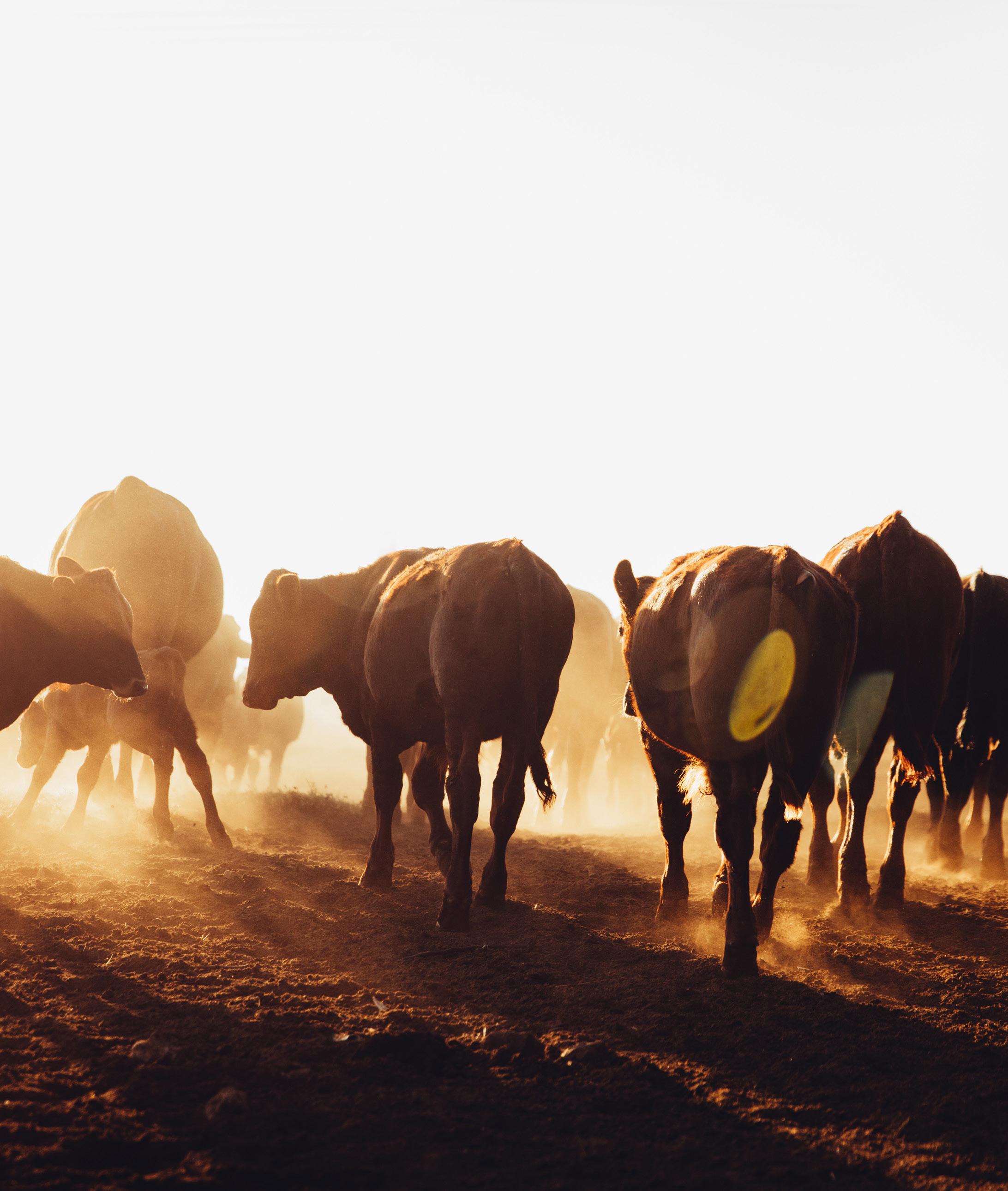
The forums will cover:


• How to identify foot-and-mouth disease and know what to do if you suspect a case
• Finding out what you can do on your farm
• Hearing what Local Land Services does to prevent Emergency Animal Diseases
• Hearing about the work of Local Land Services in pest animal control.
Tuesday
Tuesday
Tuesday
Tuesday
Tamworth Wagga Wagga Casino Dubbo West Tamworth Leagues Club Wagga Wagga RSL Club RSM Club Casino Dubbo RSL Club
9th of May
of May
16th
May
23rd
of
11am
11am
11am
Scan to express your interest in attending
30th
May
– 1pm
– 1pm 11am – 1pm
– 1pm
we started. It has been a real team effort to get it to where it is today, and we found lifelong friends along the way.”
Katherine said it is exciting to add a fledgling horticultural crop in Australia to the mix of more traditional Riverina farming products like rice and wool.
“Adapting walnuts into our climate, the genetic material we are working with and the innovations that have gone with it have made it a really exciting journey,” Katherine said.
“Like any new crop, there are growing pains in getting to scale. There were some barriers to getting into the industry, but we partnered with a wholesale nursery to get the right varieties.
“The trees spoke for themselves after that. We could see the trees had the will to grow, so we put everything we had behind it. You do cross your fingers and toes for the first four or five years waiting for the first crops.
“Now they are thriving, thanks in big part to the irrigation system and chicken manure.”
With almond plantations going nuts in the Riverina, Katherine said it was tempting to enter a more established industry with quicker returns.
“The walnut is a more interesting tree. It can last for over 100 years compared to 15 to 20 years for an almond tree. It’s one of the oldest food sources for humans and the nuts are really good for our gut flora.”
Australia’s walnut farms accounts for less than 1 per cent of global walnut supply, with US and China dominating production. With global demand increasing, Katherine said there is a growing need for year-round supply from counter-seasonal regions in the Southern Hemisphere.
The walnut harvest does clash with the rice harvest, which makes for busy times on the Herrmann’s farm in April.
“We love an autumn harvest. It’s a spectacular time of year in the Riverina.
“For the walnuts, most of the hard work is done in preparing for harvest through pruning and irrigation. There is a lot of work involved in the early years getting the tree structure right with pruning. It’s like raising children – get it right early on and they become self-sufficient quicker.”
Walnut harvesting is mechanised at Duxton Nuts and involves shaking the trees and sweeping the nuts up.
Adding a more labour-intensive crop to the farm business was a risk, but Katherine said a “shared vision” with employees has developed a secure workforce and a harmonious working environment.
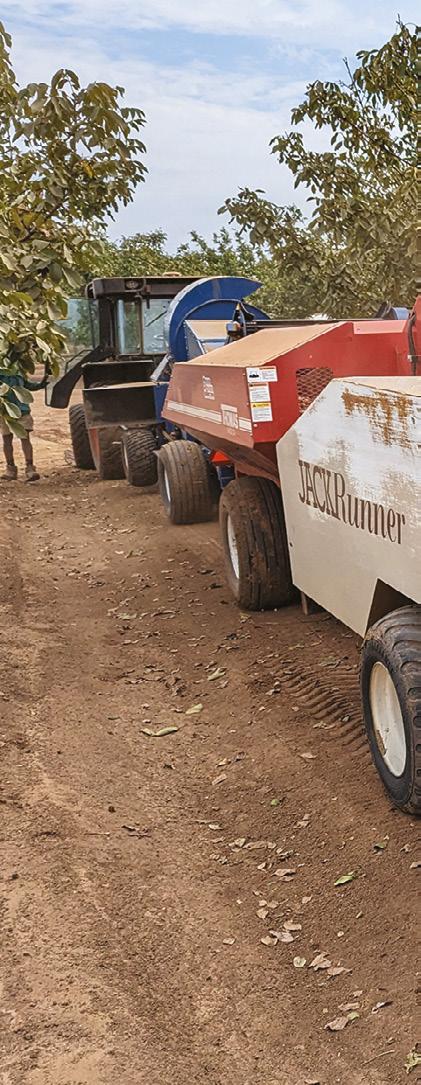
She said staff have been key to the farm’s success, including families from Vanuatu employed through the Pacific Island workers scheme that are accommodated on-farm.
“The staff have been on the same journey as us in learning about a new crop. It’s collaborative, which results in a productive relationship.
“The families from Vanuatu that we have stay are very proud of what they have achieved, as we are. They are really excited about the opportunity to learn. Some of them are now operating complicated machinery and automated irrigation equipment.”
THE NEXT GENERATION
Katherine and Peter also have a small army of six sons aged 14 to 21 that all chip in on weekends. Oswald (21) is a qualified fitter machinist, Stanley (20) and Fredrick (19) are completing apprenticeships and Indigo (16), Barney (15) and Kipling (14) are at school.
“They all love coming home and the way we are working with our environment. They all have the potential to contribute to agriculture, whether it be through innovation, engineering or even robotics if they want to,” Katherine said.
Eldest son Oswald, who is a fitter and machinist at Collier & Miller in Griffith, confirmed his love of life on the land at Murrami during the week and a farmer on weekends.

“All of us boys do volunteer work on the weekends. It’s great, I wouldn’t have it any other way,” Oswald said.
“You are never short of things to do, and the freedom of being on the farm gives you the opportunity to create and do what you want.”
Oswald’s welding and machining skills were put to the test this year with the construction of new sheep drafting yards, containment feeding infrastructure for finishing lambs and upgrades to the shearing shed.
“There was plenty of welding in all that. We’re always making something or fixing something up on the farm. That’s why I see myself as a farmer in the future.”
Brother Stanley also boasts welding skills that are utilised on farm. Stanley is completing a fitter machinist apprenticeship in Albury and travels home on weekends.
“You do get a couple of weekends off every now and then. There has not been too many lately with the building of new yards and extensions to the shearing shed. We get some work done when we are all home, that’s for sure.”
Stanley said he is also eyeing off a future life as a farmer.
“One of the reasons I am studying my trade is because I aim to go back to the farm one day with all the mechanical and advanced machinery skills I need to run a successful business.” l
COMMUNITY NEW GENERATIONS
“Adapting walnuts into our climate, the genetic material we are working with and the innovations that have gone with it have made it a really exciting journey.”
THE FARMER MAY - JUNE 2023 82
Katherine Herrmann
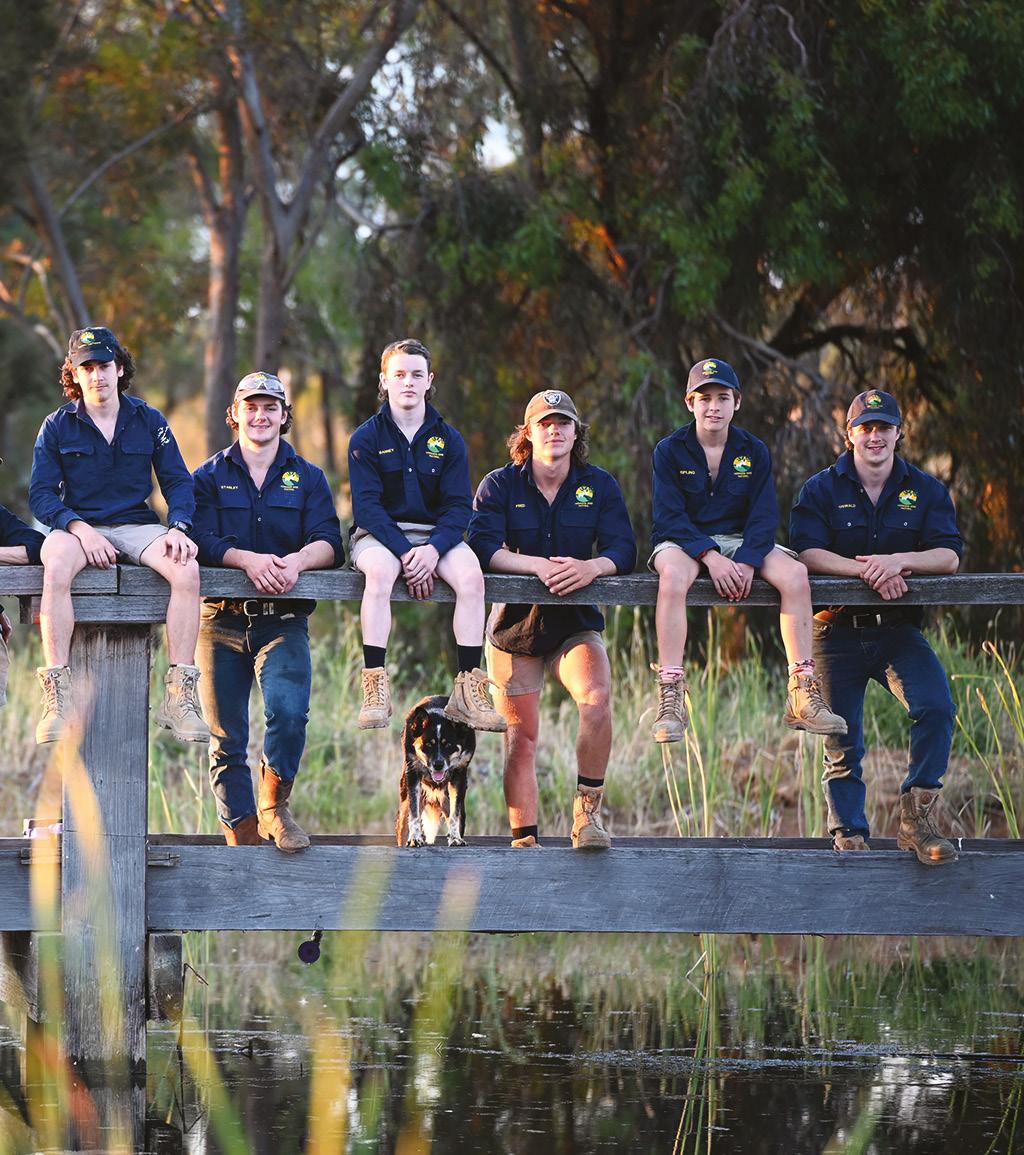

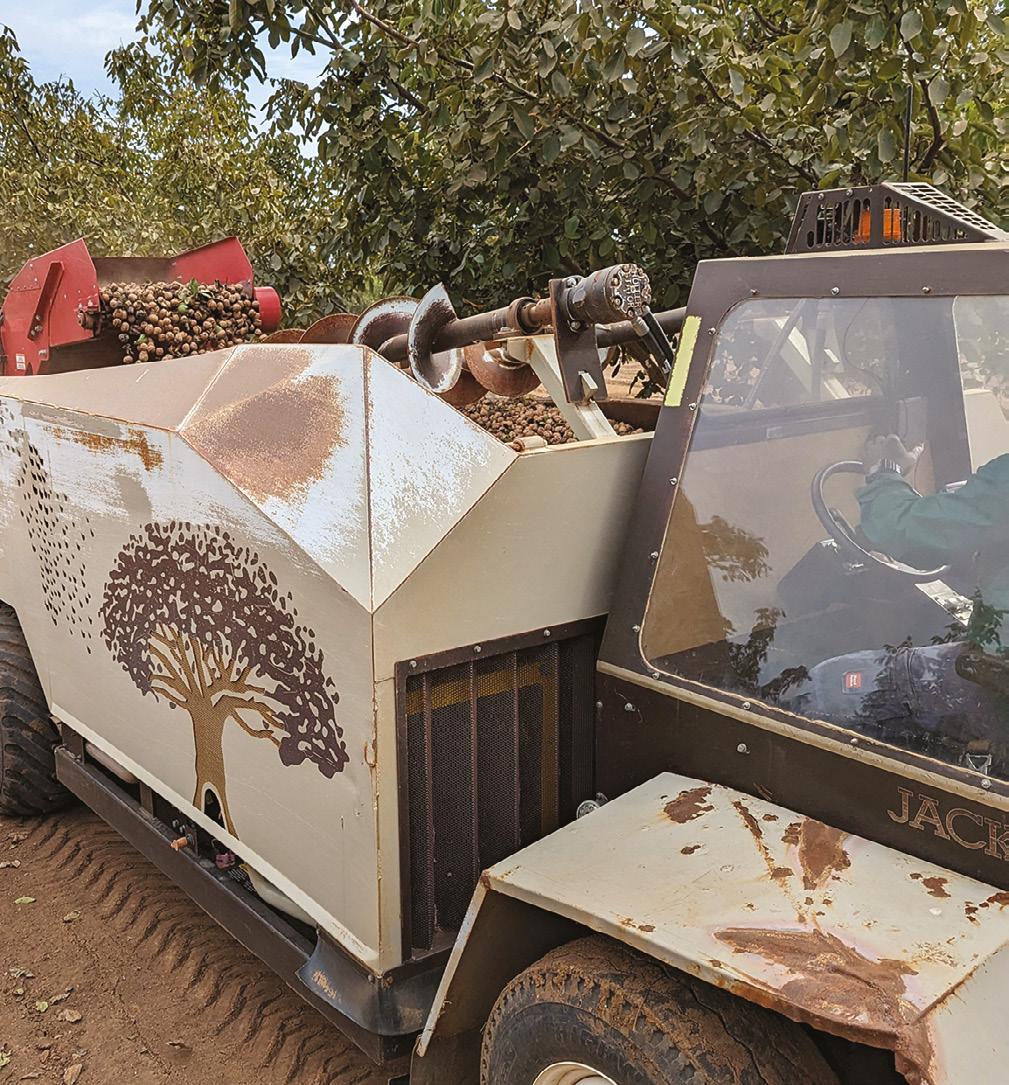
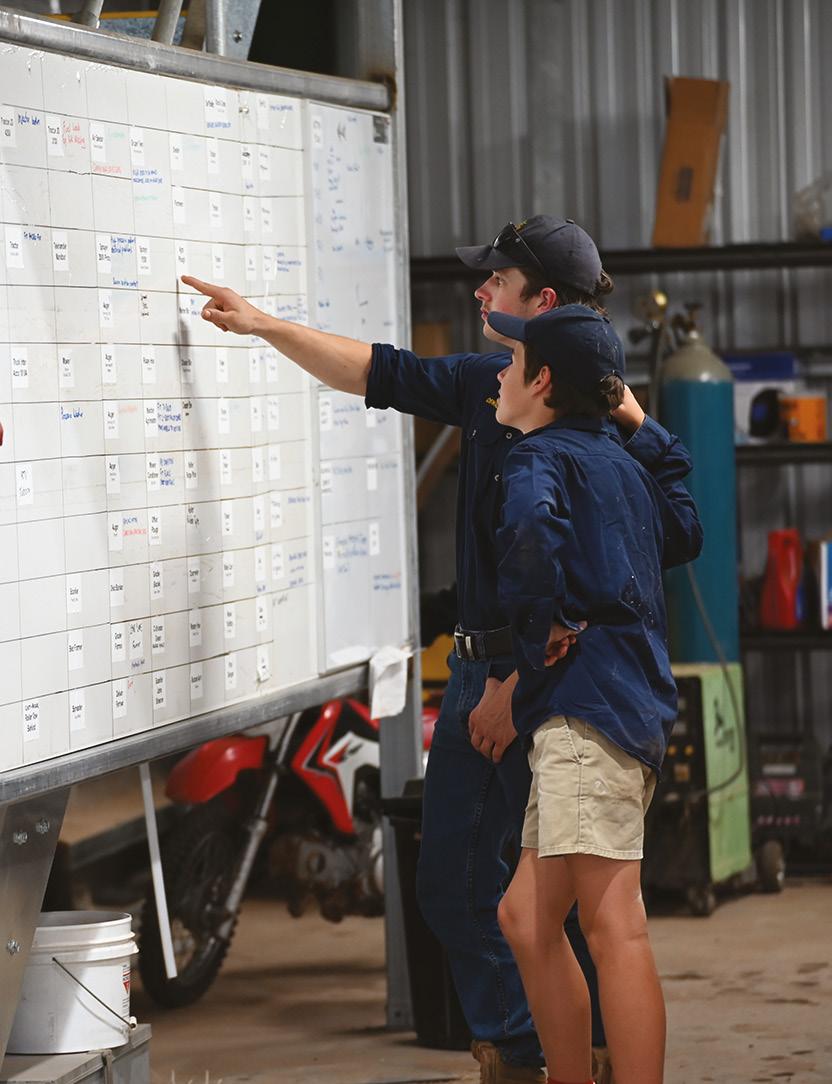

MAY - JUNE 2023 THE FARMER 83
A SMALL ARMY Clockwise from top left: The Herrmann clan; Katherine and Peter survey their walnut trees; Peter and Katherine with Peter’s parents Alma and Ray; Oswald and Kipling check out the farm’s Duty Board; Duxton Nuts harvest.
Spags’ life of leisure
Meet retired farm dog Spags from the Riverina region, who now has a life of leisure in the charming town of Berry.
 EDITED BY MICHELLE HESPE
EDITED BY MICHELLE HESPE
REAL NAME AND NICKNAMES:
Hello there, I’m Spaghetti, but my friends call me Spags. Originally from the Riverina region of NSW, I made the sea change to Berry on the South Coast.
WHAT IS YOUR FAVOURITE THING TO DO NOW THAT YOU’RE NO LONGER ON THE FARM?
Sun bathe and chase tennis balls. After a lifetime of working on the farm, it’s nice to take it easy and go for long walks on the beach. Some may say I have a life of leisure.
HAVE YOU EVER DONE SOMETHING REALLY NAUGHTY?
Well, I’ll admit that I do consider myself to be a little bit of a Houdini, and so escaping to get pats and all sort of treats from the folks in our neighbourhood is a favourite activity of mine.
WHAT IS YOUR WORST HABIT?
Carrying on like a pork chop whenever I see a tennis ball. I could chase them all day long.
WHAT IS YOUR FAVOURITE FOOD?
Kibble – there is a lot to be said for good ol’ kibble. And a cheeky slice of cheese or two after a hard day of sunbathing is always a treat.
IF YOU BECAME FAMOUS FOR ONE THING, WHAT WOULD IT BE?
I would like to be the first dog to host a morning show on television. I am very suited to it. I like to get up early, and boy can I carry on. I am sure I could get a handle on pronunciation.
IS THERE SOMETHING THAT DRIVES YOUR PARENTS MAD?
When I don’t listen and refuse to stop barking when there’s a ball anywhere in sight.
IF YOU COULD HAVE ANOTHER ANIMAL AS A FRIEND, WHAT WOULD IT BE AND WHY?
I’m very lucky to have a best friend named Ted, and he is also a retired kelpie. We have a lot in common – we both enjoy walks, chasing tennis balls, hanging out at coffee shops and praying for toast and cheese to hit the ground. A really good day is when bacon goes astray.
FAVOURITE TOY OR THING TO PLAY WITH?
If you had not guessed by now – tennis balls. Duh.
WHAT DOES EVERYONE LOVE ABOUT YOU? How friendly and approachable I am, my big smile, and my name always makes people laugh.
ANY LAST WORDS?
Woeeoof, Weeeoofff. Which roughly translates to Carpe Diem.
COMMUNITY FARM DOGS
THE FARMER MAY - JUNE 2023 84
The Saleyards
We’ve rounded up some of the best Aussie-made gifts for Mother’s Day.
Compiled by DANIELLE MCILTROT
COUNTRY COLOURS
Inspired by her trips around Australia, designer and landscape artist Sally Wilson decided to make wearable art in the form of ‘landscape’ bracelets. Hand-crafted in her studio from high-quality fired polymer clay, each bracelet comes with an accompanying photo of the location that inspired it. $40 sallywilsonart.com

BREAK A SWEAT
These comfy Merino leggings will keep mum warm and sweat-free with Merino’s natural moisture wicking properties. From the gym to the café, these leggings will keep mum looking stylish and feeling comfortable.

$115 merinocountry.com
CITRUS FRESH
Featuring 100 per cent pure lemon myrtle essential oil, this moisturiser is refreshing, uplifting and long-lasting for the face, hands and body. With an organic aloe vera base, boosted with macadamia oil and vitamin E, mum’s skin will feel smooth and silky soft.

$31.95 lemonmyrtlefragrances.com.au
GOOD CHIMES
Since 1985, Windsong Chimes has handcrafted precisiontuned Australian-made wind chimes designed to reflect the timeless beauty and charm of music created by the wind. Tuned to a Bb pentatonic scale, their Concerto wind chime is an enduring favourite which combines lyrical melody with refreshing clarity and lightness of tone.
$169 windsongchimes.com.au


COMFY AND COSY
This Easy Rest Woolblend pillow is blended with 100 per cent Australian wool and new premium hollow polyester filling to give the ultimate loft and comfort, with natural support, breathability and temperature-balancing properties. Complete with a cotton reusable bag, this pillow is a great, long-lasting gift for mum.
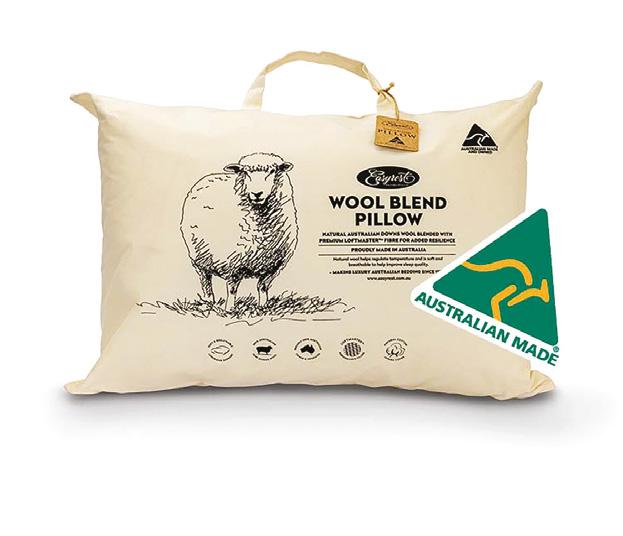
$92.85 easyrest.com.au
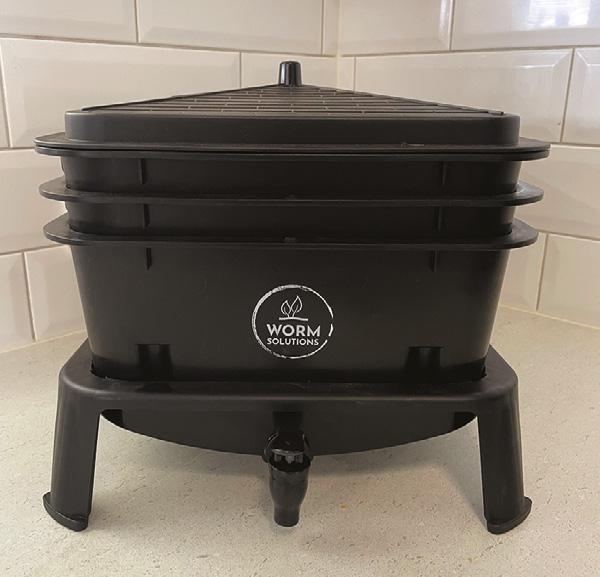
AROMA ARRANGEMENTS
For Mother’s Day this year, Australian-made and female-owned business Beloved Scents released a new fragrance, Peony Petals. With 80 hours of burn time, this double wick soy candle comes in a limited edition candy pink and is a great way to show mum your appreciation this year.

$39.95 belovedscents.com.au

THINK I’LL GO USE WORMS
Ideal for teaching kids the fundamentals of worm farming and waste recycling is Worm Solutions (worm wee)! Perfect for apartments or small properties, Worm Solutions is compact and sustainable.
$69.95 (kit only)
$109.95 (full kit with worms) wormsolutions.com.au
HYDRATION STATION
The 321 Filter Bottle is a reusable 500ml eco filtered water bottle. The “French press” style carbon filtration system absorbs impurities such as odours, tastes, organic compounds and residual chlorine from potable tap water. Simply plunge to enjoy clean and fresh drinking water.
$31.95 321water.com
MARKETPLACE
MAY - JUNE 2023 THE FARMER 85
Faith in farming
Ranald and Jenny Mitchell have been members of NSW Farmers for 62 years. Always staying ahead of the game, they have been passionate about regenerative farming for more than two decades.
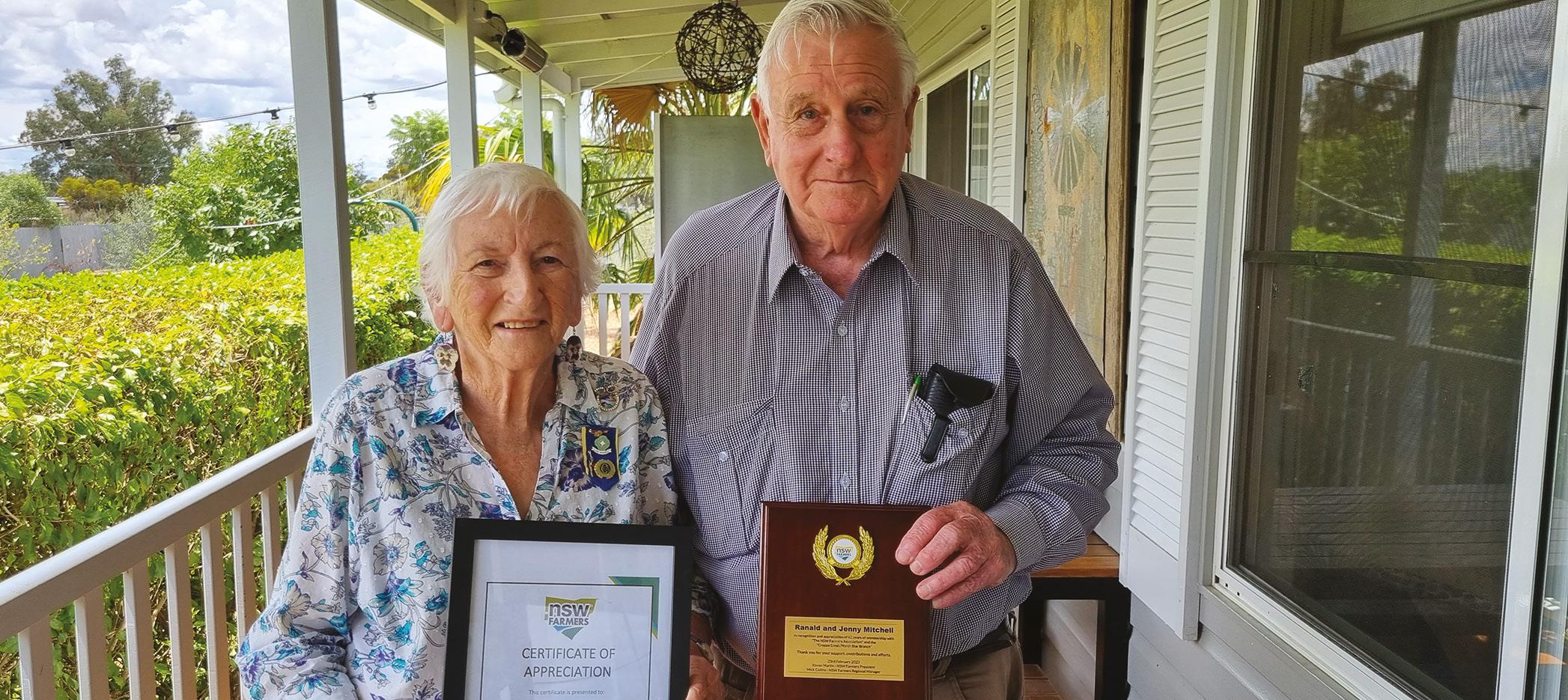
HOW DID YOU GET INTO FARMING AND AGRICULTURE?
My father Lesley was a farmer in the area, and he drew what was called a Prickly Pear block to clean up. It was 2,399 acres, and we killed all the prickly pear with the help of cactoblastis – which is one of the greatest biological control success stories of all time. We put fences up and put water on it and it became Leyland. I took it over when I was 18 and dad started selling it to me, and that is where I stayed for the next 68 years. We sold the farm last year and have now retired to Goondiwindi, which has been the biggest change in our 65 years of marriage.
WHAT DO YOU LOVE ABOUT FARMING AND AGRICULTURE?
My passion for the land and its use continues to evolve and grow to this day. I have learned so much about producing food sustainably and looking after the land and soil.
WHAT DOES YOUR FARM PRODUCE?
We started with just sheep, then added a little bit of grain growing and some cattle. After going through some droughts, it became clear that cropping was the best option for the farm. North Star became one of the largest wheat receival sites in Australia. We also realised early on the
need to diversify the cropping operations and change our practices. This included adding legume crops like chickpeas and faba beans in winter and mung beans and cow peas in winter. It was a rotational cropping system that was quite complex, and I had big maps to plan it all out. We did set aside 16 hectares through the Biodiversity Conservation Trust that will remain in perpetuity. If I were 20 years younger, we would have gone back into some livestock as well.
WHAT DO YOU THINK IS THE BIGGEST THING TO HAVE HAPPENED IN FARMING IN THE LAST TEN YEARS?
The rise of regenerative farming practices. It is something that I am quite passionate about now. We had been doing it for about 20 years, using things like worm juice to replace artificial fertilisers and crop rotations. Regenerative farming needs to become the aim of the wider farming community to enhance our fragile soils and our environment while continuing to produce food.
WHO IS YOUR BIGGEST INSPIRATION IN FARMING AND AGRICULTURE?
My wife Jenny, and our strong Christian faith.
Name: Ranald Mitchell
NSW Farmers Branch: North Star
Farm location: North Star
Farm name: Leyland
Years as a Member: 62
Why are you a NSW Farmers Member?
“I realised that working with a group of farmers allowed me to get some of my ideas across, and I could learn from them as well. That is what the North Star branch was all about. NSW Farmers and its predecessors have been great to learn from. To have a common voice in issues like shearers’ strikes is a must. We have also had a great Regional Service Manager in Mick Collins, who has really supported the branch and its members.”
WHAT DID YOU DO WHEN YOU WERE NOT FARMING?
We had five children, so it was always about time with family and friends and involvement in community groups such as Pony Club. We have been very blessed with a strong network of friends. Sundays were for church activities and a day off from the farm. Jenny was President of CWA NSW for a while, which involved a lot of activity. That included being invited to Government House for a private dinner party with the Queen and Prince Philip when they were here. The Queen was fantastic to talk to. She knew all about drought in northern NSW at the time and talked about what was going on with farmers in England.
WHAT IS YOUR FAVOURITE BOOK?
The Bible, and regenerative farming books by the likes of Charles Massey.
WHAT IS YOUR FAVOURITE SECTION OF THE FARMER MAGAZINE?
I really like all of it. It’s a very good read. I like reading the stories about what farmers are doing in other parts of the state, and there have been great stories on regenerative farming. l
COMMUNITY MEET A MEMBER
THE FARMER MAY - JUNE 2023 86
Mobil Card TM . Fuelling NSW Farmers.
NSW Farmers members can now save on Mobil fuels. With zero card fees and great savings, add a Mobil Card to your wallet today!
Zero card fees
Zero card fees
Looking after locals with no monthly card fees.
Looking after locals with no monthly card fees.
All in one
All in one Great deals on tyres, batteries, servicing and more with Mobil Card extras.
Great deals on tyres, batteries, servicing and more with Mobil Card extras.
NSWF Members can now enjoy at NSW Mobil Branded sites:
• 6.0 cents per litre discount on diesel fuels at unattended Mobil branded locations
NSWF Members can now enjoy at NSW Mobil Branded sites:
• 6.0 cents per litre discount on diesel fuels at unattended Mobil branded locations
• 4.0 cents per litre discount on diesel fuels at Mobil branded service station locations
• 4.0 cents per litre discount on unleaded fuels / e10 at Mobil branded locations
• 4.0 cents per litre discount on diesel fuels at Mobil branded service station locations
• 6.0 cents per litre discount on premium unleaded 95 /98 fuel
Mobil quality fuels
Flexible and organised
Mobil quality fuels


Access to SynergyTM and Mobil Diesel EfficientTM fuels that protect your engine.
Access to SynergyTM and Mobil Diesel EfficientTM fuels that protect your engine.

Up to 51 day account terms and ATO & security reporting.
Flexible and organised
Up to 51 day account terms and ATO & security reporting.
• If you need any support with completing an application, contact Tracey Thorn on 0450 693 287 or tracey.thorn@sales.mobil.com.au
• If you need any support with completing an application, contact Tracey Thorn on 0450 693 287 or tracey.thorn@sales.mobil.com.au
I already have a Mobil Card account; how do I access the NSWF discount?
I already have a Mobil Card account; how do I access the NSWF discount?
• Contact Tracey (or your existing account manager) on the details above, or email sales@mobilcard.com.au to let us know your account number
• 4.0 cents per litre discount on unleaded fuels / e10 at Mobil branded locations
• Zero card fees; up to 21 day payment terms and flexible billing cycles
• 6.0 cents per litre discount on premium unleaded 95 /98 fuel
• Zero card fees; up to 21 day payment terms and flexible billing cycles
7-Eleven service stations are now accepting Mobil Card and at their locations and NSWF members can now enjoy:
• 2.0 cents per litre discount on unleaded fuel / e10
7-Eleven service stations are now accepting Mobil Card and at their locations and NSWF members can now enjoy:
• 3.0 cents per litre discount on premium unleaded 95 /98 fuel
• 2.0 cents per litre discount on diesel fuel
• 2.0 cents per litre discount on unleaded fuel / e10
How do I apply?
• Please apply online at www.mobilcard.com.au
• 3.0 cents per litre discount on premium unleaded 95 /98 fuel
• 2.0 cents per litre discount on diesel fuel
• Make sure you enter Promo Code NSWFARMERS when completing the application
How do I apply?
• Please apply online at www.mobilcard.com.au
• Make sure you enter Promo Code NSWFARMERS when completing the application
Mobil Card


Your business. Sorted.
Your business. Sorted.
• Contact Tracey (or your existing account manager) on the details above, or email sales@mobilcard.com.au to let us know your account number
How do I find my nearest Mobil Card site?
• Use our Fuel Finder at www.mobil.com.au or download the Mobil App on your Android or iPhone; be sure to tick the Mobil Card filter to search
How do I find my nearest Mobil Card site?
• Mobil branded sites across NSW are independentlyoperated, so each time you fuel with Mobil Card you are supporting a local business
• Use our Fuel Finder at www.mobil.com.au or download the Mobil App on your Android or iPhone; be sure to tick the Mobil Card filter to search
• 7-Eleven service stations across the country now accept Mobil Card. To confirm your closest 7-Eleven location please refer to the Fuel Finder via www.mobil.com.au
• Mobil branded sites across NSW are independentlyoperated, so each time you fuel with Mobil Card you are supporting a local business
• 7-Eleven service stations across the country now accept Mobil Card. To confirm your closest 7-Eleven location please refer to the Fuel Finder via www.mobil.com.au
Offer is available only to current NSW Farmers Federation members, and an application must be completed on the prescribed form. Offer cannot be used in conjunction with any other discount, offer or site promotion. Mobil may share summary information on volume usage / spend by Accountholders with NSW Farmers Federation. Mobil Card enables you to access participating Mobil-branded sites, where you can buy Mobil Synergy and Diesel Efficient fuels. Mobil Card is issued by Mobil Oil Australia Pty. Ltd. 88 004 052 984. Discounts are inclusive of GST and apply off the pump price at participating Mobil-branded and 7-Eleven locations. Offer is subject to approval of your account application by Mobil. Mobil Card is a charge card and not a money lending facility. Offer applies to Mobil fuel purchases only, excluding LPG or Diesel Exhaust Fluid (AdBlue®), at participating locations. Mobil reserves the right to modify or change discounts at any time. Standard Mobil Card terms, conditions, fees and charges apply, unless varied in writing. Applicants and authorised representatives must be over 18 years old, hold an ABN and use their account/cards wholly or predominately for business purposes. If you would prefer not to receive marketing communications from Mobil, please email sales@mobilcard.com.au Participating sites, terms and conditions and fee schedule are available at www.mobilcard.com.au.
Offer is available only to current NSW Farmers Federation members, and an application must be completed on the prescribed form. Offer cannot be used in conjunction with any other discount, offer or site promotion. Mobil may share summary information on volume usage / spend by Accountholders with NSW Farmers Federation. Mobil Card enables you to access participating Mobil-branded sites,
Mobil Card
JOIN US
Memberships
Annual membership options
FULL PRODUCER MEMBER $438.90 For those who own or manage 1 VOTE PER MEMBERSHIP a farm. Includes our basic workplace relations package which provides:


· Collective representation on awards, minimum wage review, workers compensation.
· Wage information, including wage guides issued annually.
· Phone advice, four calls a year.
ESSENTIALS WORKPLACE RELATIONS PACKAGE
Members can upgrade to this package to receive:
· Unlimited advice on employment matters.
· Assistance in negotiating with the Fair Work Ombudsman’s office.
· Representation in employment matters handled by tribunals, such as Fair Work Australia.
ADDITIONAL MEMBER $100
Linked to a full producer, with a 1 VOTE PER MEMBERSHIP proprietorial or income interest.
· Assistance with drafting and reviewing employment-related correspondence, policies and procedures, and employment agreements.
SECOND VOTE MEMBER $100
Linked to a full producer, most 1 VOTE PER MEMBERSHIP often a family member.
SMALL FARMS MEMBER $150 Have a small holding and do not receive majority of income from it.
ASSOCIATE MEMBER $100
COUNTRY CONNECTION $100
Do not own a farm, e.g. teachers, agronomists, business people.
Supporters of farms from the city.
RETIRED MEMBER $100 For retired farmers
The Essentials Workplace Relations package fees start from $165 for up to two employees. Extra charges may apply for assistance required within your first four months of membership. All prices include GST.
794 000.

FOR ALL GENERAL ENQUIRIES Contact the Member Service Centre on 1300 794 000 or your local regional services manager:
NORTHERN Michael Collins, 0439 958 163, collinsm@nswfarmers.org.au
NORTH COAST & TABLELANDS Mark Bulley, 0429 330 348, bulleym@nswfarmers.org.au
TABLELANDS & SOUTH WEST SLOPES Catriona McAuliffe, 0488 100 005, mcauliffec@nswfarmers.org.au
MIA WEST RIVERINA & LACHLAN Frank Galluzzo, 0427 773 495, galluzzof@nswfarmers.org.au
EAST RIVERINA & SOUTH COAST Daniel Brear, 0487 248 731, breard@nswfarmers.org.au
WESTERN DIVISION & ORANA Caron Chester, 0400 116 207, chesterc@nswfarmers.org.au
HUNTER & SYDNEY BASIN Tanya Hayes, 0407 533 218, hayest@nswfarmers.org.au
MEMBERSHIP & COMMERCIAL Andrew Coughlan, 0477 393 092, coughlana@nswfarmers.org.au

YES, I WOULD LIKE TO JOIN NSW FARMERS. I HAVE TICKED MY MEMBERSHIP CHOICE ABOVE. PLEASE CONTACT ME.

NAME: ADDRESS: EMAIL: PHONE: COMMODITY (IF APPROPRIATE):
MEMBERSHIP SERVICE
MANAGER
Alicia Harrison, 0429 817 611 harrisona@nswfarmers.org.au
Help protect your livelihood. NSW Farmers is your voice – we are only as strong as you make us. The greater our numbers; the greater our voice.
Use your voice, become a member at nswfarmers.org.au or call 1300
include The Farmer magazine delivere d to you.
The goats of Dry Creek Farm –How a family business began to thrive The future of Aussie weather –What’s on the horizon Safeguarding our oysters –Creating a diseaseresistant spat Agritourism is booming –Farming diversifying Election yields new Labor government strong outcomes for agriculture
THE FARMER MAY - JUNE 2023 88
NSW FARMERS MEMBERS
GET 10% OFF RRP**
DO YOU NEED SUPER-FAST INTERNET?
IMPROVE DATA SPEEDS ALL CARRIERS SUPPORTED MULTIPLE USERS
To receive your discount please enter your NSWF Member Number in to the Coupon Code eld in the shopping cart section of the Powertec website www.powertec.com.au

WHAT’S THE BUZZ?
By testing beehives for signs of disease that can affect avocado trees, scientists can more quickly and easily discern whether nearby trees are affected. Not only will it help avocado producers, but simultaneously provide a powerful crossindustry biosecurity tool. That’s the bee’s knees!
The un-bee-lievable power of bees
New research has revealed that bees could be the key to determining whether our avocado crops are pathogen-free.
Words MATILDA MEIKLE
In a study conducted by the University of Queensland and CSIRO, experts have determined that bees can alert them of the presence of disease in avocado trees. If this strategy can be implemented nationwide, it could lead to increased production and export rates for Australian avocados.
THE PRIMARY PROBLEM
Currently, there are many factors that could prevent our avocados from being sold overseas. The leading cause is sunblotch – a disease which weakens and damages the plant without showing visible symptoms.
According to associate professor from the Queensland Alliance for Agriculture and Food Innovation, Dr Andrew Geering, sunblotch is a constant danger to avocado plants.
“We’ve had an active control plan for avocado sunblotch since the 1980s because it has the potential to decrease yield of a tree by about 80 per cent,” he says.
“Even though this pathogen has nearly been eradicated, there is a chance there are still pockets of infection around the place, and this is a concern for Australia’s trading partners.”

PROTECTING OUR PLANTS
So, how can bees help to detect and eradicate this pesky disease?

Dr John Roberts first proposed using bees for disease detection when he noticed that plant viruses are often found alongside bee viruses in pollination hives.
“Avocado trees are 10 metres tall by 5 metres wide – and there might be 20,000 in an orchard – and we needed a way to efficiently gather samples,” says Dr Geering.
Instead of wasting time and resources testing each avocado tree for viruses, the team discovered that bees who pollinate the avocado plants can do it for them. By simply testing the pollen in the hive for signs of infection, the process becomes much simpler.
“Bees are reliable, free and very thorough in their sampling activity,” Dr Geering notes.
WHAT’S NEXT?
For the research team, there are several next steps.
“Now that we’ve demonstrated the principle, we’d like to roll it out in the largest avocado producing area in Australia, the Atherton Tablelands, to demonstrate that it’s free of the pathogen,” Dr Geering says.
There are around 530,000 commercial beehives in the country, making bees a simple and accessible tool. Dr. Geering believes they are the answer moving forward.
“This approach can also provide surveillance for multiple pathogens simultaneously of both honeybees and plants, making this a powerful crossindustry biosecurity tool,” he says. l
THE TAIL END
THE FARMER MAY - JUNE 2023 90
SAVE THE DATE NSW Farmers 2023 Annual Conference 18 - 20 July | Rosehill Gardens Racecourse
Feeding the Future

Building soil carbon in cropping systems has just got easier Delivering the benefits of building soil carbon back to farmers. SecondCrop combines Loam’s ground-breaking microbial technology with farmer-focused carbon project options. loambio.com To discuss if one of our options is right for your farm visit loambio.com to complete our Grower Interest Survey or email us on info@loambio.com Scan QR code to fill out our Grower Interest Survey.



































 Words MICHAEL BURT
Words MICHAEL BURT
























































































 –
Words SUE WALLACE
–
Words SUE WALLACE








 –
Words DARREN BAGULEY
–
Words DARREN BAGULEY



 –
Words IAN NEUBAUER
–
Words IAN NEUBAUER
































 –
Words MICHAEL BURT
–
Words MICHAEL BURT




 A BIG WIN
A BIG WIN



















 EDITED BY MICHELLE HESPE
EDITED BY MICHELLE HESPE
























